

28 Best Academic Search Engines That make your research easier
This post may contain affiliate links that allow us to earn a commission at no expense to you. Learn more

If you’re a researcher or scholar, you know that conducting effective online research is a critical part of your job. And if you’re like most people, you’re always on the lookout for new and better ways to do it.
I’m sure you are familiar with some research databases. But, top researchers keep an open mind and are always looking for inspiration in unexpected places.
This article aims to give you an edge over researchers that rely mainly on Google for their entire research process.
Our list of 28 academic search engines will start with the more familiar to less.
Table of Contents
#1. Google Scholar

Google Scholar is an academic search engine that indexes the full text or metadata of scholarly literature across an array of publishing formats and disciplines.
Great for academic research, you can use Google Scholar to find articles from academic journals, conference proceedings, theses, and dissertations. The results returned by Google Scholar are typically more relevant and reliable than those from regular search engines like Google.
Tip: You can restrict your results to peer-reviewed articles only by clicking on the “Scholarly”
- Scholarly results are typically more relevant and reliable than those from regular search engines like Google.
- You can restrict your results to peer-reviewed articles only by clicking on the “Scholarly” tab.
- Google Scholar database Coverage is extensive, with approx. 200 million articles indexed.
- Abstracts are available for most articles.
- Related articles are shown, as well as the number of times an article has been cited.
- Links to full text are available for many articles.
- Abstracts are only a snippet of the full article, so you might need to do additional searching to get the full information you need.
- Not all articles are available in full text.
Google Scholar is completely free.
#2. ERIC (Education Resources Information Center)
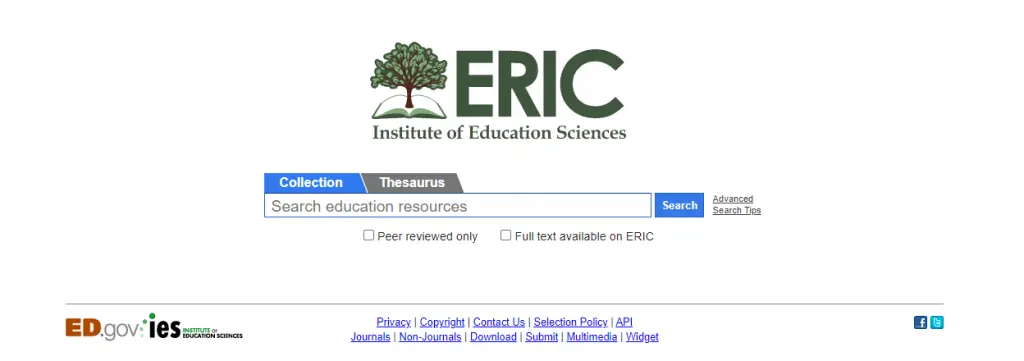
ERIC (short for educational resources information center) is a great academic search engine that focuses on education-related literature. It is sponsored by the U.S. Department of Education and produced by the Institute of Education Sciences.
ERIC indexes over a million articles, reports, conference papers, and other resources on all aspects of education from early childhood to higher education. So, search results are more relevant to Education on ERIC.
- Extensive coverage: ERIC indexes over a million articles, reports, and other resources on all aspects of education from early childhood to higher education.
- You can limit your results to peer-reviewed journals by clicking on the “Peer-Reviewed” tab.
- Great search engine for educators, as abstracts are available for most articles.
ERIC is a free online database of education-related literature.
You might also like:
- SCI Journal: Science Journal Impact Factor
- 15 Best Websites to Download Research Papers for Free
- 11 Best Academic Writing Tools For Researchers 2024
- 10 Best Reference Management Software for Research 2024
- Academic Tools
#3. Wolfram Alpha

Wolfram Alpha is a “computational knowledge engine” that can answer factual questions posed in natural language. It can be a useful search tool.
Type in a question like “What is the square root of 64?” or “What is the boiling point of water?” and Wolfram Alpha will give you an answer.
Wolfram Alpha can also be used to find academic articles. Just type in your keywords and Wolfram Alpha will generate a list of academic articles that match your query.
Tip: You can restrict your results to peer-reviewed journals by clicking on the “Scholarly” tab.
- Can answer factual questions posed in natural language.
- Can be used to find academic articles.
- Results are ranked by relevance.
- Results can be overwhelming, so it’s important to narrow down your search criteria as much as possible.
- The experience feels a bit more structured but it could also be a bit restrictive
Wolfram Alpha offers a few pricing options, including a “Pro” subscription that gives you access to additional features, such as the ability to create custom reports. You can also purchase individual articles or download them for offline use.
Pro costs $5.49 and Pro Premium costs $9.99
#4. iSEEK Education
- 15 Best Websites To Download Research Papers For Free
- 30+ Essential Software For Researchers
- 15 Best Academic Research Trend Prediction Platforms
- 15 Best Academic Networking And Collaboration Platforms
iSEEK is a search engine targeting students, teachers, administrators, and caregiver. It’s designed to be safe with editor-reviewed content.
iSEEK Education also includes a “Cited by” feature which shows you how often an article has been cited by other researchers.
- Editor-reviewed content.
- “Cited by” feature shows how often an article has been cited by other researchers.
- Limited to academic content.
- Doesn’t have the breadth of coverage that some of the other academic search engines have.
iSEEK Education is free to use.
#5. BASE (Bielefeld Academic Search Engine)
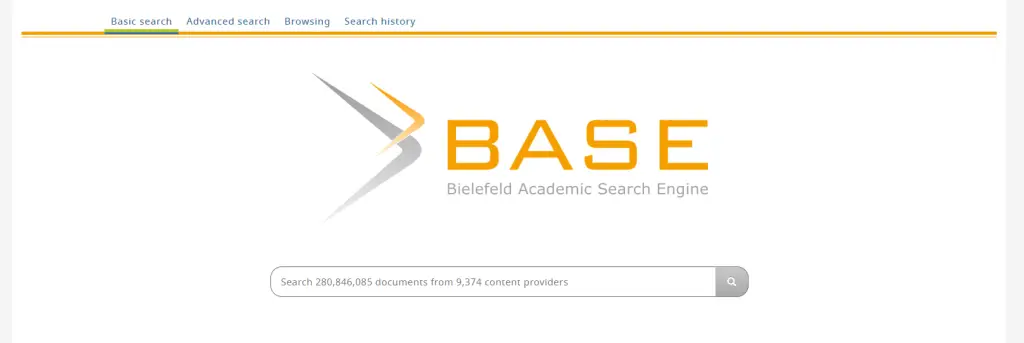
BASE is hosted at Bielefeld University in Germany and that’s where it name stems from (Bielefeld Academic Search Engine).
Known as “one of the most comprehensive academic web search engines,” it contains over 100 million documents from 4,000 different sources.
Users can narrow their search using the advanced search option, so regardless of whether you need a book, a review, a lecture, a video or a thesis, BASE has what you need.
BASE indexes academic articles from a variety of disciplines, including the arts, humanities, social sciences, and natural sciences.
- One of the world’s most voluminous search engines,
- Indexes academic articles from a variety of disciplines, especially for academic web resources
- Includes an “Advanced Search” feature that lets you restrict your results to peer-reviewed journals.
- Doesn’t include abstracts for most articles.
- Doesn’t have related articles, references, cited by
BASE is free to use.
- 10 Best Reference Management Software for Research 2023
- 15 Best Academic Networking and Collaboration Platforms
- 30+ Essential Software for Researchers
- 15 Best Academic Blogging and Content Management
- 11 Best Academic Writing Tools For Researchers
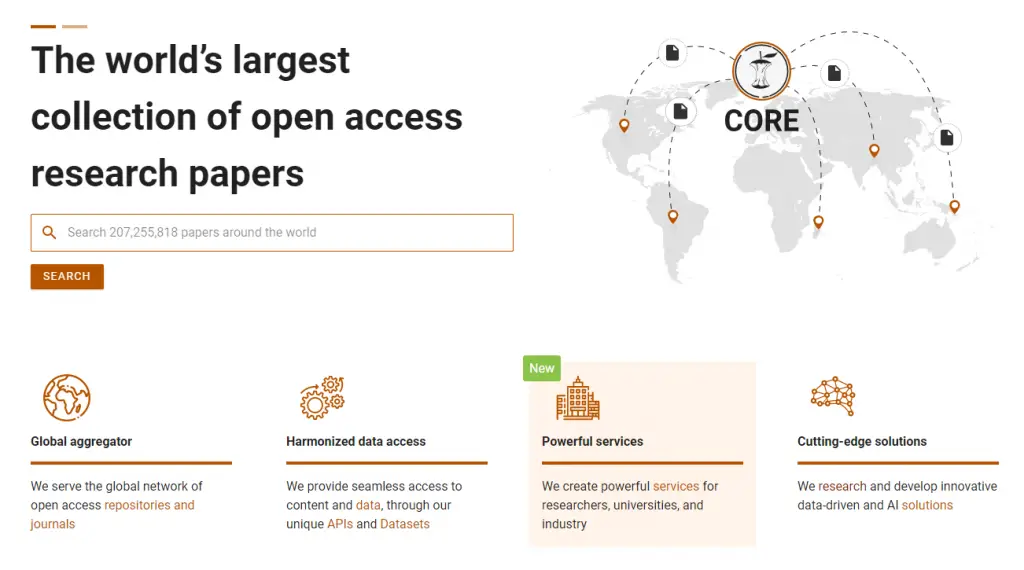
CORE is an academic search engine that focuses on open access research papers. A link to the full text PDF or complete text web page is supplied for each search result. It’s academic search engine dedicated to open access research papers.
- Focused on open access research papers.
- Links to full text PDF or complete text web page are supplied for each search result.
- Export formats include BibTeX, Endnote, RefWorks, Zotero.
- Coverage is limited to open access research papers.
- No abstracts are available for most articles.
- No related articles, references, or cited by features.
CORE is free to use.
- Best Plagiarism Checkers for Research Papers in 2024
#7. Science.gov

Science.gov is a search engine developed and managed by the United States government. It includes results from a variety of scientific databases, including NASA, EPA, USGS, and NIST.
US students are more likely to have early exposure to this tool for scholarly research.
- Coverage from a variety of scientific databases (200 million articles and reports).
- Links to full text are available for some articles.
Science.gov is free to use.
- 15 Best Academic Journal Discovery Platforms
- Sci Hub Review
#8. Semantic Scholar

Semantic Scholar is a recent entrant to the field. Its goal is to provide more relevant and effective search results via artificial intelligence-powered methods that detect hidden relationships and connections between research topics.
- Powered by artificial intelligence, which enhances search results.
- Covers a large number of academic articles (approx. 40 million).
- Related articles, references, and cited by features are all included.
- Links to full text are available for most articles.
Semantic Scholar is free to use.
- 11 Best Academic Writing Tools For Researchers
- 10 Best Reference Management Software for Research
- 15 Best Academic Journal Discovery Platforms
#9. RefSeek

RefSeek searches more than five billion documents, including web pages, books, encyclopedias, journals, and newspapers.
This is one of the free search engines that feels like Yahoo with a massive directory. It could be good when you are just looking for research ideas from unexpected angles. It could lead you to some other database that you might not know such as the CIA The World Factbook, which is a great reference tool.
- Searches more than five billion documents.
- The Documents tab is very focused on research papers and easy to use.
- Results can be filtered by date, type of document, and language.
- Good source for free academic articles, open access journals, and technical reports.
- The navigation and user experience is very dated even to millenials…
- It requires more than 3 clicks to dig up interesting references (which is how it could lead to you something beyond the 1st page of Google)
- The top part of the results are ALL ads (well… it’s free to use)
RefSeek is free to use.
#10. ResearchGate
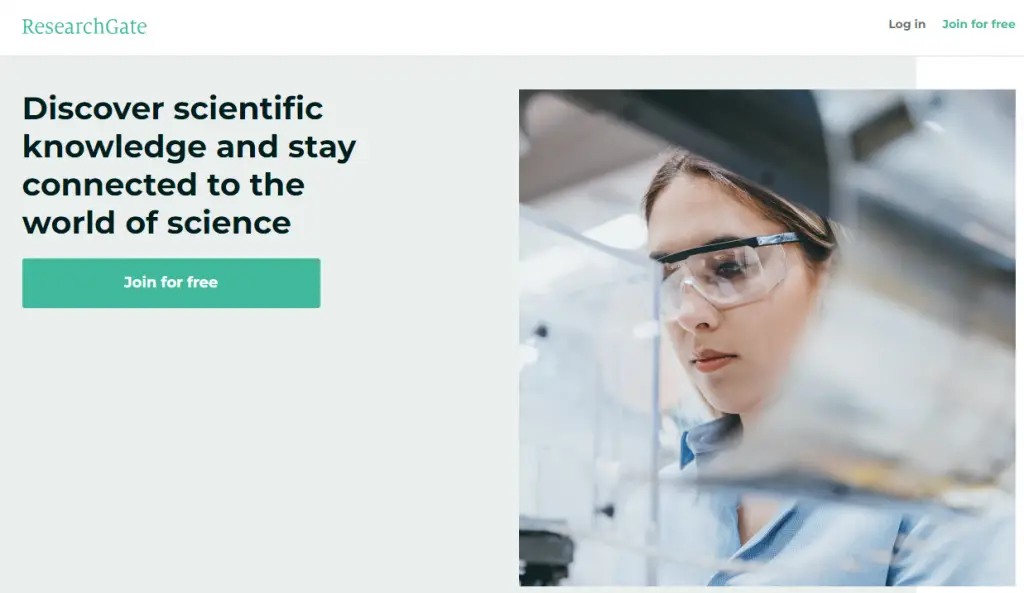
A mixture of social networking site + forum + content databases where researchers can build their profile, share research papers, and interact with one another.
Although it is not an academic search engine that goes outside of its site, ResearchGate ‘s library of works offers an excellent choice for any curious scholar.
There are more than 100 million publications available on the site from over 11 million researchers. It is possible to search by publication, data, and author, as well as to ask the researchers questions.
- A great place to find research papers and researchers.
- Can follow other researchers and get updates when they share new papers or make changes to their profile.
- The network effect can be helpful in finding people who have expertise in a particular topic.
- Interface is not as user friendly
- Can be overwhelming when trying to find relevant papers.
- Some papers are behind a paywall.
ResearchGate is free to use.
- 15 Best Academic Research Trend Prediction Platforms
- 25 Best Tools for Tracking Research Impact and Citations
#11. DataONE Search (formerly CiteULike)
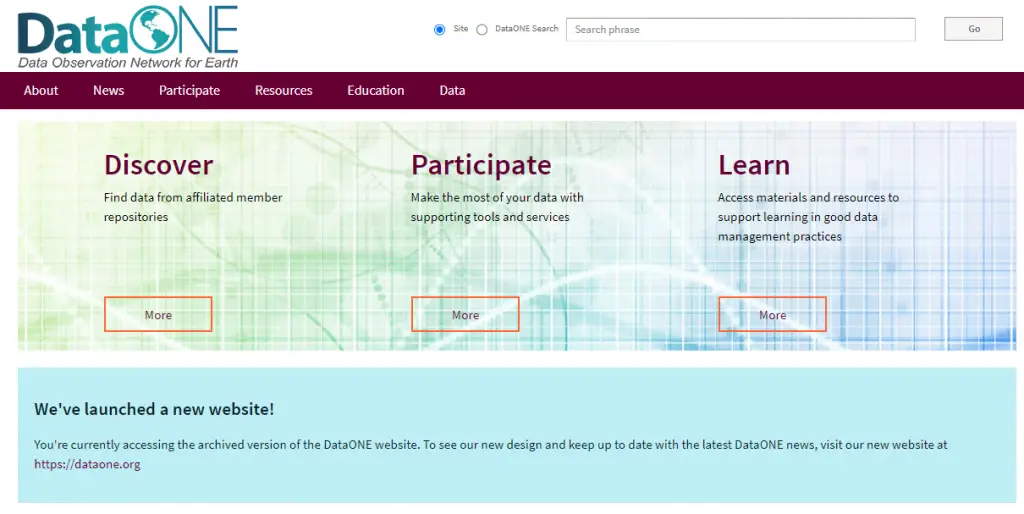
A social networking site for academics who want to share and discover academic articles and papers.
- A great place to find academic papers that have been shared by other academics.
- Some papers are behind a paywall
CiteULike is free to use.
#12. DataElixir

DataElixir is deigned to help you find, understand and use data. It includes a curated list of the best open datasets, tools and resources for data science.
- Dedicated resource for finding open data sets, tools, and resources for data science.
- The website is easy to navigate.
- The content is updated regularly
- The resources are grouped by category.
- Not all of the resources are applicable to academic research.
- Some of the content is outdated.
DataElixir is free to use.
#13. LazyScholar – browser extension
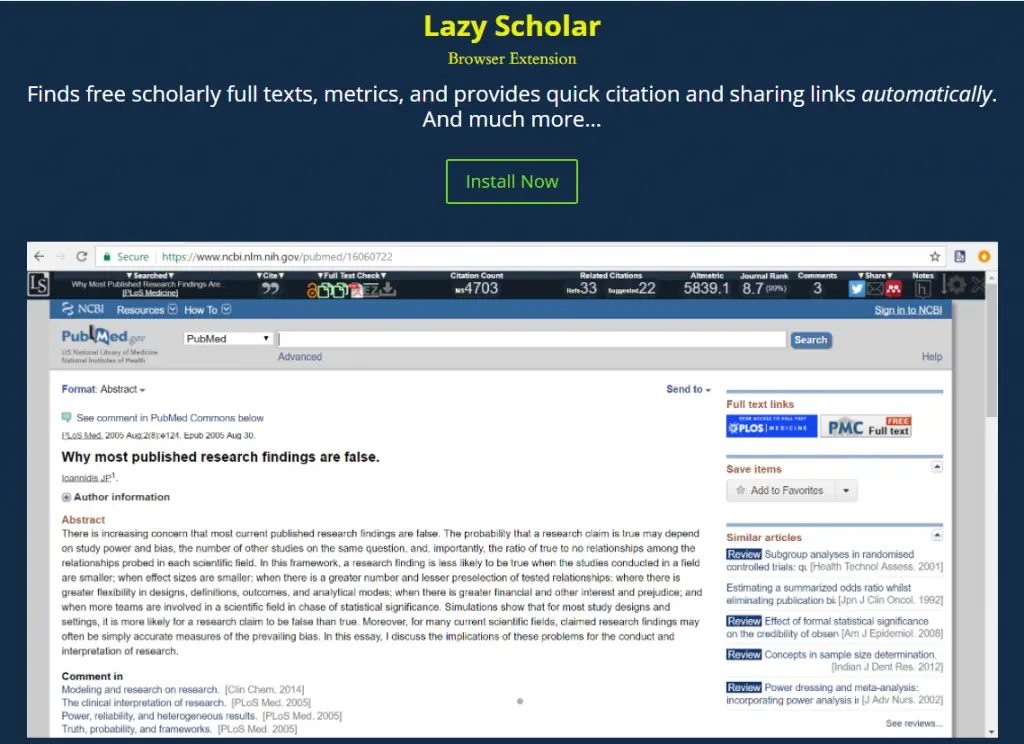
LazyScholar is a free browser plugin that helps you discover free academic full texts, metrics, and instant citation and sharing links. Lazy Scholar is created Colby Vorland, a postdoctoral fellow at Indiana University.
- It can integrate with your library to find full texts even when you’re off-campus.
- Saves your history and provides an interface to find it.
- A pre-formed citation is availlable in over 900 citation styles.
- Can recommend you topics and scans new PubMed listings to suggest new papers
- Results can be a bit hit or miss
LazyScholar is free to use.
#14. CiteseerX – digital library from PenState

CiteseerX is a digital library stores and indexes research articles in Computer Science and related fields. The site has a robust search engine that allows you to filter results by date, author.
- Searches a large number of academic papers.
- Results can be filtered by date, author, and topic.
- The website is easy to use.
- You can create an account and save your searches for future reference.
CiteseerX is free to use.
- Surfer Review: Is It Worth It?
- 25 Best Tools For Tracking Research Impact And Citations
#15. The Lens – patents search
The Lens or the Patent Lens is an online patent and scholarly literature search facility, provided by Cambia, an Australia-based non-profit organization.

- Searches for a large number of academic papers.
The price range can be free for non-profit use to $5,000 for commercial enterprise.
#16. Fatcat – wiki for bibliographic catalog
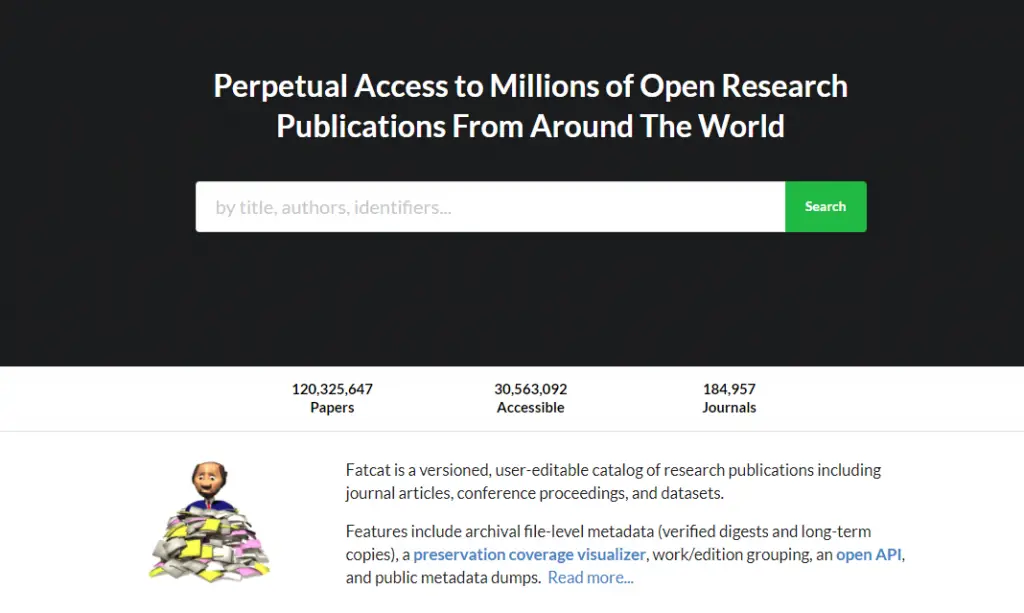
Fatcat is an open bibliographic catalog of written works. The scope of works is somewhat flexible, with a focus on published research outputs like journal articles, pre-prints, and conference proceedings. Records are collaboratively editable, versioned, available in bulk form, and include URL-agnostic file-level metadata.
- Open source and collaborative
- You can be part of the community that is very focused on its mission
- The archival file-level metadata (verified digests and long-term copies) is a great feature.
- Could prove to be another rabbit hole
- People either love or hate the text-only interface
#17. Lexis Web – Legal database
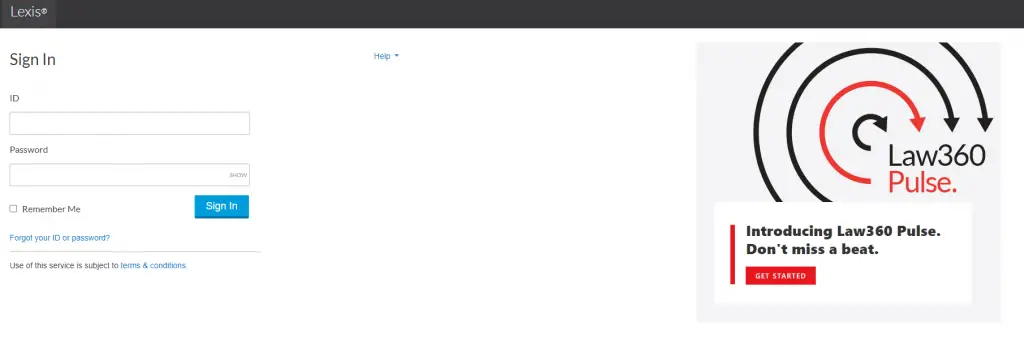
Are you researching legal topics? You can turn to Lexis Web for any law-related questions you may have. The results are drawn from legal sites and can be filtered based on criteria such as news, blogs, government, and commercial. Additionally, users can filter results by jurisdiction, practice area, source and file format.
- Results are drawn from legal sites.
- Filters are available based on criteria such as news, blogs, government, and commercial.
- Users can filter results by jurisdiction, practice area, source and file format.
- Not all law-related questions will be answered by this search engine.
- Coverage is limited to legal sites only.
Lexis Web is free for up to three searches per day. After that, a subscription is required.
#18. Infotopia – part of the VLRC family
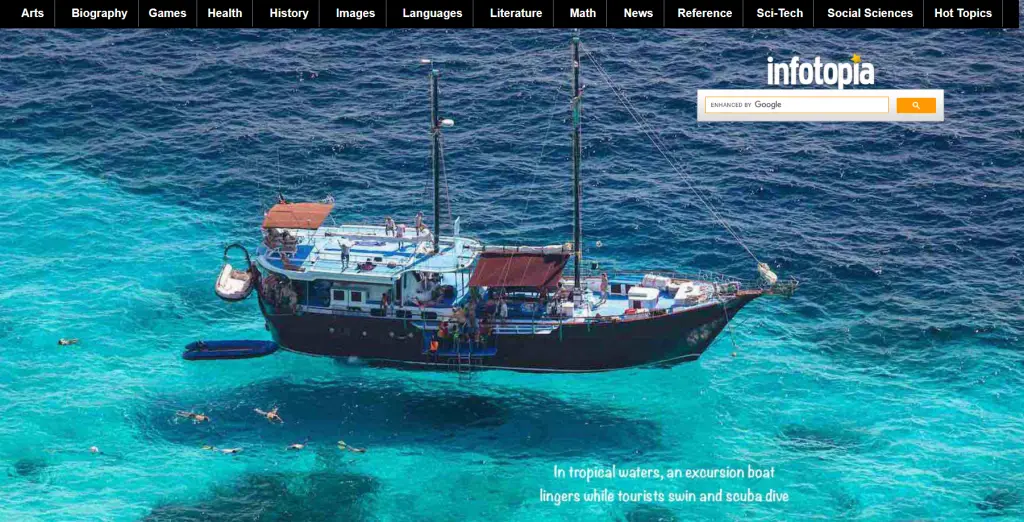
Infotopia touts itself as an “alternative to Google safe search.” Scholarly book results are curated by librarians, teachers, and other educational workers. Users can select from a range of topics such as art, health, and science and technology, and then see a list of resources pertaining to the topic.
Consequently, if you aren’t able to find what you are looking for within Infotopia’s pages, you will probably find it on one of its many suggested websites.
#19. Virtual Learning Resources Center
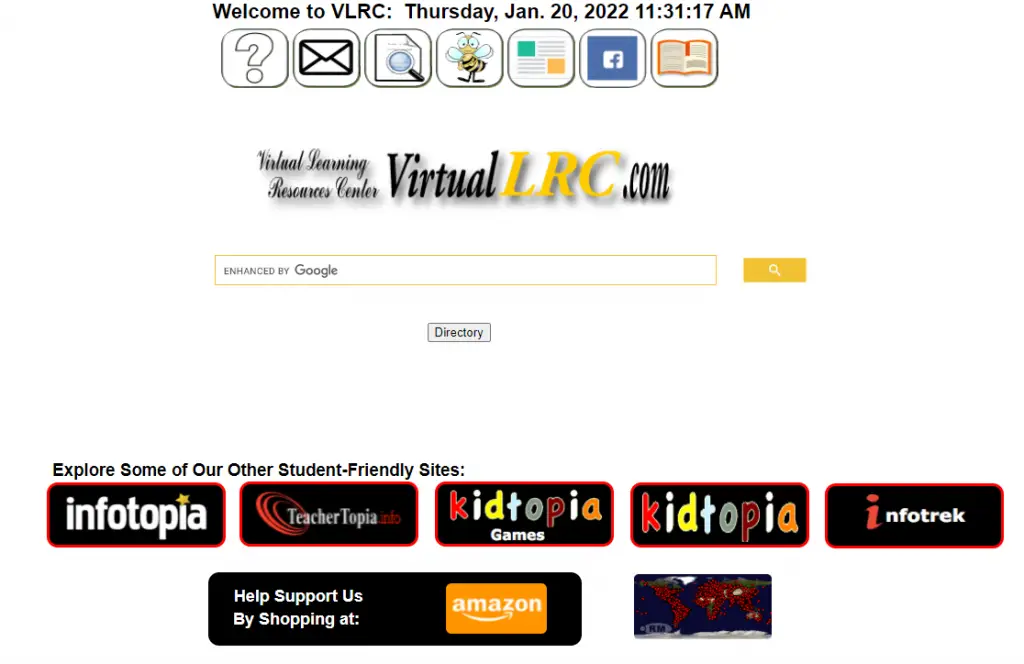
Virtual Learning Resources Center (VLRC) is an academic search engine that features thousands of academic sites chosen by educators and librarians worldwide. Using an index generated from a research portal, university, and library internet subject guides, students and instructors can find current, authoritative information for school.
- Thousands of academic information websites indexed by it. You will also be able to get more refined results with custom Google search, which will speed up your research.
- Many people consider VLRC as one of the best free search engines to start looking for research material.
- TeachThought rated the Virtual LRC #3 in it’s list of 100 Search Engines For Academic Research
- More relevant to education
- More relevant to students

Powered by Google Custom Search Engine (CSE), Jurn is a free online search engine for accessing and downloading free full-text scholarly papers. It was created by David Haden in a public open beta version in February 2009, initially for locating open access electronic journal articles in the arts and humanities.
After the indexing process was completed, a website containing additional public directories of web links to indexed publications was introduced in mid-2009. The Jurn search service and directory has been regularly modified and cleaned since then.
- A great resource for finding academic papers that are behind paywalls.
- The content is updated regularly.uren
Jurn is free to use.
#21. WorldWideScience
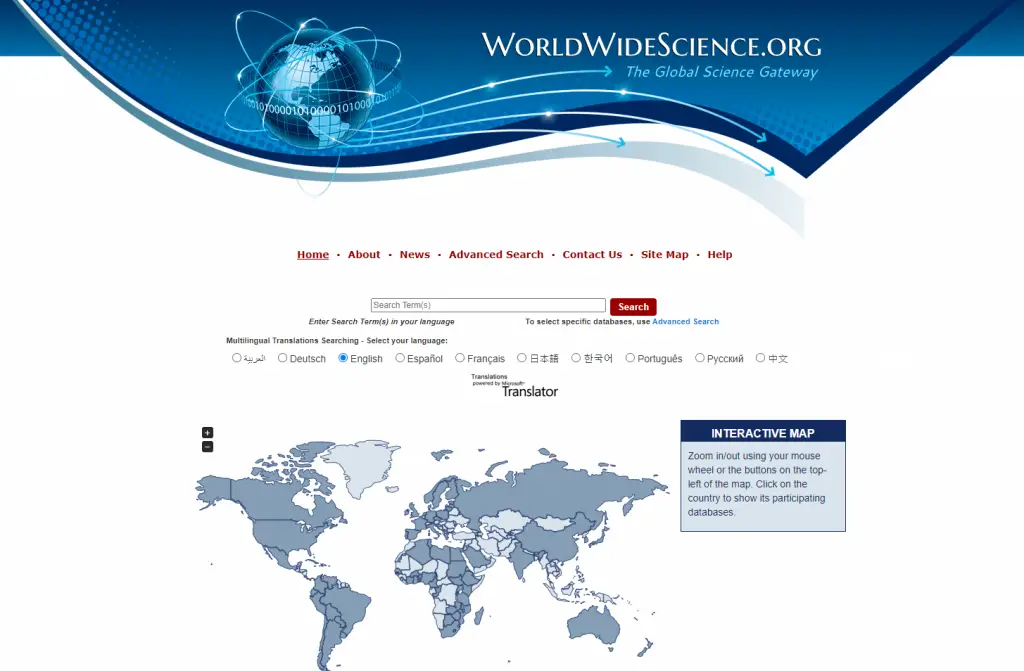
The Office of Scientific and Technical Information—a branch of the Office of Science within the U.S. Department of Energy—hosts the portal WorldWideScience , which has dubbed itself “The Global Science Gateway.”
Over 70 countries’ databases are used on the website. When a user enters a query, it contacts databases from all across the world and shows results in both English and translated journals and academic resources.
- Results can be filtered by language and type of resource
- Interface is easy to use
- Contains both academic journal articles and translated academic resources
- The website can be difficult to navigate.
WorldWideScience is free to use.
#22. Google Books
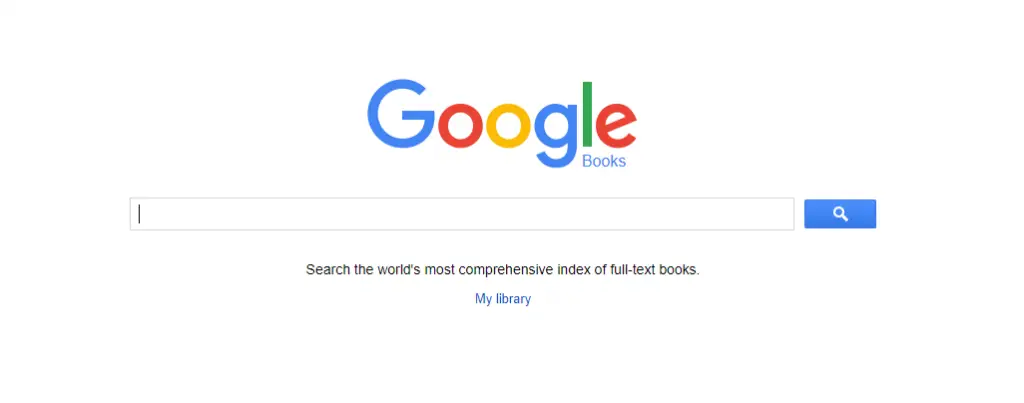
A user can browse thousands of books on Google Books, from popular titles to old titles, to find pages that include their search terms. You can look through pages, read online reviews, and find out where to buy a hard copy once you find the book you are interested in.
#23. DOAJ (Directory of Open Access Journals)
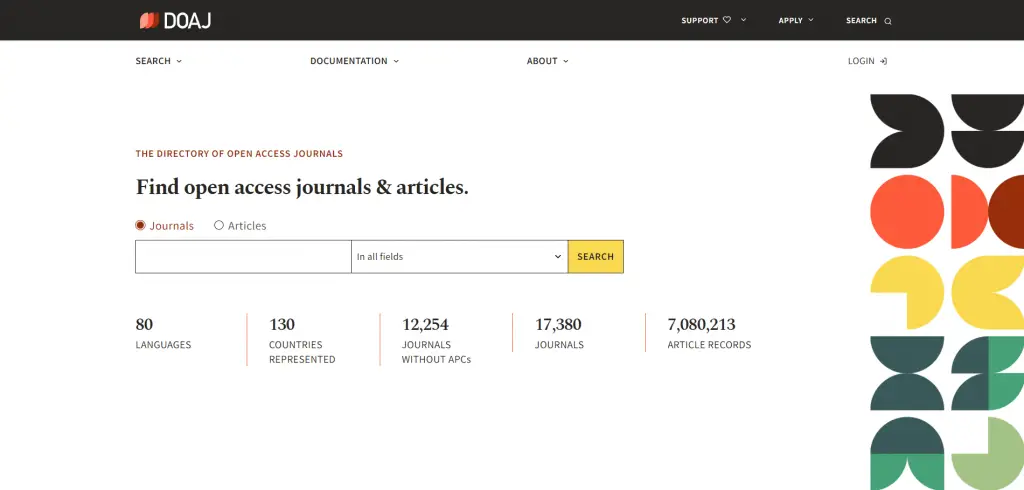
DOAJ is a free search engine for scientific and scholarly materials. It is a searchable database with over 8,000 peer-reviewed research papers organized by subject. It’s one of the most comprehensive libraries of scientific and scholarly resources, with over 8,000 journals available on a variety of themes.
#24. Baidu Scholar

Baidu Xueshu (Academic) is the Chinese version for Google Scholar. IDU Scholar indexes academic papers from a variety of disciplines in both Chinese and English.
- Articles are available in full text PDF.
- Covers a variety of academic disciplines.
- No abstracts are available for most articles, but summaries are provided for some.
- A great portal that takes you to different specialized research platform
- You need to be able to read Chinese to use the site
- Since 2021 there is a rise of focus on China and the Chinese Communist Party
Baidu Scholar is free to use.
#25. PubMed Central
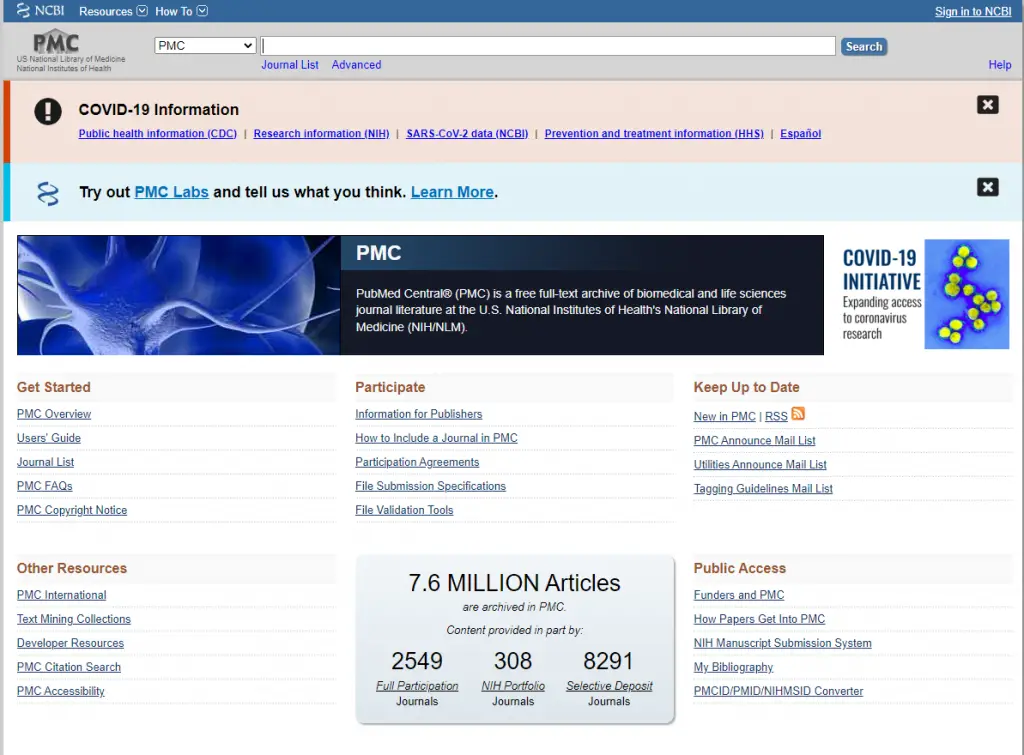
PubMed is a free search engine that provides references and abstracts for medical, life sciences, and biomedical topics.
If you’re studying anything related to healthcare or science, this site is perfect. PublicMed Central is operated by the National Center for Biotechnology Information, a division of the U.S. National Library of Medicine. It contains more than 3 million full-text journal articles.
It’s similar to PubMed Health, which focuses on health-related research and includes abstracts and citations to over 26 million articles.
#26. MEDLINE®
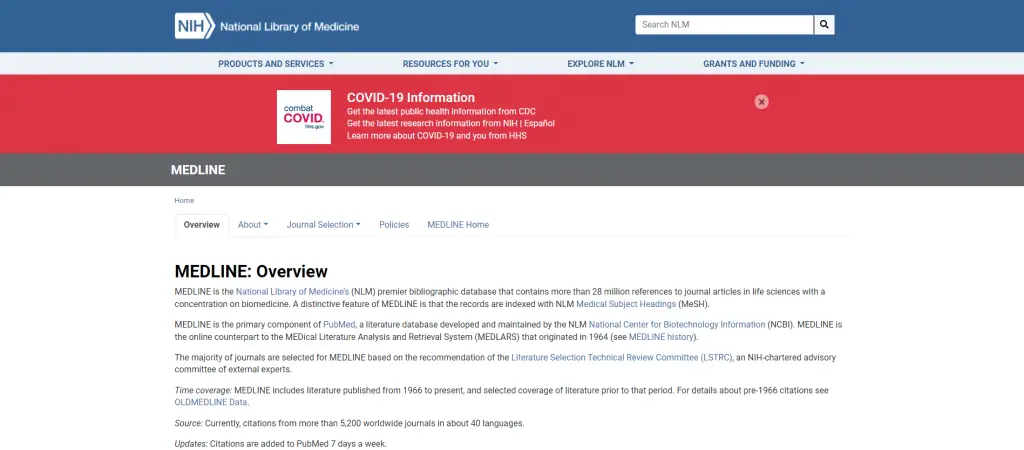
MEDLINE® is a paid subscription database for life sciences and biomedicine that includes more than 28 million citations to journal articles. For finding reliable, carefully chosen health information, Medline Plus provides a powerful search tool and even a dictionary.
- A great database for life sciences and biomedicine.
- Contains more than 28 million references to journal articles.
- References can be filtered by date, type of document, and language.
- The database is expensive to access.
- Some people find it difficult to navigate and find what they are looking for.
MEDLINE is not free to use ( pricing information ).
Defunct Academic Search Engines
#27. microsoft academic .
Microsoft Academic
Microsoft Academic Search seemed to be a failure from the beginning. It ended in 2012, then re-launched in 2016 as Microsoft Academic. It provides the researcher with the opportunity to search academic publications,
Microsoft Academic used to be the second-largest academic search engine after Google Scholar. Microsoft Academic provides a wealth of data for free, but Microsoft has announced that it will shut Microsoft Academic down in by 2022.
#28. Scizzle
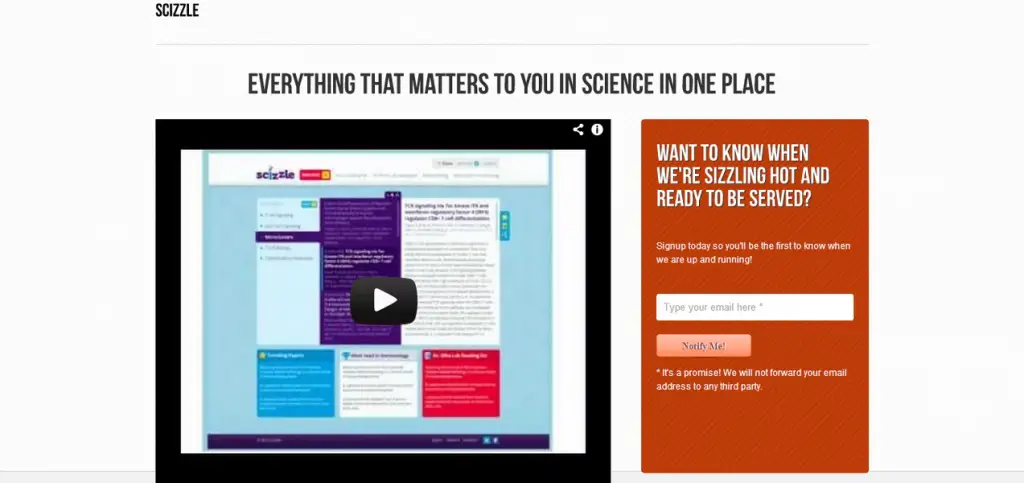
Designed to help researchers stay on top of the literature by setting up email alerts, based on key terms, for newspapers.
Unfortunately, academic search engines come and go. These are two that are no longer available.
Final Thoughts
There are many academic search engines that can help researchers and scholars find the information they need. This list provides a variety of options, starting with more familiar engines and moving on to less well-known ones.
Keeping an open mind and exploring different sources is essential for conducting effective online research. With so much information at our fingertips, it’s important to make sure we’re using the best tools available to us.
Tell us in the comment below which academic search engine have you not heard of? Which database do you think we should add? What database do your professional societies use? What are the most useful academic websites for research in your opinion?
There is more.
Check out our other articles on the Best Academic Tools Series for Research below.
- Learn how to get more done with these Academic Writing Tools
- Learn how to proofread your work with these Proofreading Tools
- Learn how to broaden your research landscape with these Academic Search Engines
- Learn how to manage multiple research projects with these Project Management Tools
- Learn how to run effective survey research with these Survey Tools for Research
- Learn how get more insights from important conversations and interviews with Transcription Tools
- Learn how to manage the ever-growing list of references with these Reference Management Software
- Learn how to double your productivity with literature reviews with these AI-Based Summary Generators
- Learn how to build and develop your audience with these Academic Social Network Sites
- Learn how to make sure your content is original and trustworthy with these Plagiarism Checkers
- Learn how to talk about your work effectively with these Science Communication Tools
10 thoughts on “28 Best Academic Search Engines That make your research easier”
Thank you so much Joannah..I have found this information useful to me as librarian in an academic library
You are welcome! We are happy to hear that!
Thank You Team, for providing a comprehensive list of academic search engines that can help make research easier for students and scholars. The variety of search engines included offers a range of options for finding scholarly articles, journals, and other academic resources. The article also provides a brief summary of each search engine’s features, which helps in determining which one is the best fit for a specific research topic. Overall, this article is a valuable resource for anyone looking for a quick and easy way to access a wealth of academic information.
Thank you for taking the time to share your feedback with us. We are delighted to hear that you found our list of academic search engines helpful in making research easier for students and scholars. We understand the importance of having a variety of options when it comes to finding scholarly articles, journals, and other academic resources, and we strive to provide a comprehensive list of resources to meet those needs.
We are glad that you found the brief summary of each search engine’s features helpful in determining which one is the best fit for a specific research topic. Our goal is to make it easy for our readers to access valuable academic information and we’re glad that we were able to achieve that for you.
We appreciate your support and thank you for your kind words. We will continue to provide valuable resources for students and researchers in the future. Please let us know if you have any further questions or suggestions.
No more questions Thank You
I cannot thank you enough!!! thanks alot 🙂
Typography animation is a technique that combines text and motion to create visually engaging and dynamic animations. It involves animating individual letters, words, or phrases in various ways to convey a message, evoke emotions, or enhance the visual impact of a design or video. – Typography Animation Techniques Tools and Online Software {43}
Hi Joannah! Here’s another one you may want to add! Expontum ( https://www.expontum.com/ ) – Helps researchers quickly find knowledge gaps and identify what research projects have been completed before. Thanks!
Expontum – Helps researchers quickly find knowledge gaps and identify what research projects have been completed before. Expontum is free, open access, and available to all globally with no paid versions of the site. Automated processes scan research article information 24/7 so this website is constantly updating. By looking at over 35 million research publications (240 million by the end of 2023), the site has 146 million tagged research subjects and 122 million tagged research attributes. Learn more about methodology and sources on the Expontum About Page ( https://www.expontum.com/about.php )
Hey Ryan, I clicked and checked your site and thought it was very relevant to our reader. Thank you for sharing. And, we will be reviewing your site soon.
Sounds good! Thanks, Joannah!
Leave a Comment Cancel reply
Save my name, email, and website in this browser for the next time I comment.
We maintain and update science journals and scientific metrics. Scientific metrics data are aggregated from publicly available sources. Please note that we do NOT publish research papers on this platform. We do NOT accept any manuscript.
2012-2024 © scijournal.org
Advanced search
Saved to my library.


Explore millions of high-quality primary sources and images from around the world, including artworks, maps, photographs, and more.
Explore migration issues through a variety of media types
- Part of The Streets are Talking: Public Forms of Creative Expression from Around the World
- Part of The Journal of Economic Perspectives, Vol. 34, No. 1 (Winter 2020)
- Part of Cato Institute (Aug. 3, 2021)
- Part of University of California Press
- Part of Open: Smithsonian National Museum of African American History & Culture
- Part of Indiana Journal of Global Legal Studies, Vol. 19, No. 1 (Winter 2012)
- Part of R Street Institute (Nov. 1, 2020)
- Part of Leuven University Press
- Part of UN Secretary-General Papers: Ban Ki-moon (2007-2016)
- Part of Perspectives on Terrorism, Vol. 12, No. 4 (August 2018)
- Part of Leveraging Lives: Serbia and Illegal Tunisian Migration to Europe, Carnegie Endowment for International Peace (Mar. 1, 2023)
- Part of UCL Press
Harness the power of visual materials—explore more than 3 million images now on JSTOR.
Enhance your scholarly research with underground newspapers, magazines, and journals.
Explore collections in the arts, sciences, and literature from the world’s leading museums, archives, and scholars.
Academia.edu no longer supports Internet Explorer.
To browse Academia.edu and the wider internet faster and more securely, please take a few seconds to upgrade your browser .
Download 55 million PDFs for free
Explore our top research interests.

Engineering

Anthropology

- Earth Sciences

- Computer Science

- Mathematics

- Health Sciences

Join 261 million academics and researchers
Track your impact.
Share your work with other academics, grow your audience and track your impact on your field with our robust analytics
Discover new research
Get access to millions of research papers and stay informed with the important topics around the world
Publish your work
Publish your research with fast and rigorous service through Academia.edu Publishing. Get instant worldwide dissemination of your work
Unlock the most powerful tools with Academia Premium

Work faster and smarter with advanced research discovery tools
Search the full text and citations of our millions of papers. Download groups of related papers to jumpstart your research. Save time with detailed summaries and search alerts.
- Advanced Search
- PDF Packages of 37 papers
- Summaries and Search Alerts

Share your work, track your impact, and grow your audience
Get notified when other academics mention you or cite your papers. Track your impact with in-depth analytics and network with members of your field.
- Mentions and Citations Tracking
- Advanced Analytics
- Publishing Tools
Real stories from real people

Used by academics at over 15,000 universities

Get started and find the best quality research
- Academia.edu Publishing
- We're Hiring!
- Help Center
- Find new research papers in:
- Cognitive Science
- Academia ©2024
21 Legit Research Databases for Free Journal Articles in 2024
#scribendiinc
Written by Scribendi
Has this ever happened to you? While looking for websites for research, you come across a research paper site that claims to connect academics to a peer-reviewed article database for free.
Intrigued, you search for keywords related to your topic, only to discover that you must pay a hefty subscription fee to access the service. After the umpteenth time being duped, you begin to wonder if there's even such a thing as free journal articles.
Subscription fees and paywalls are often the bane of students and academics, especially those at small institutions who don't provide access to many free article directories and repositories.
Whether you're working on an undergraduate paper, a PhD dissertation, or a medical research study, we want to help you find tools to locate and access the information you need to produce well-researched, compelling, and innovative work.
Below, we discuss why peer-reviewed articles are superior and list out the best free article databases to use in 2024.
Download Our Free Research Database Roundup PDF
Why peer-reviewed scholarly journal articles are more authoritative.

Determining what sources are reliable can be challenging. Peer-reviewed scholarly journal articles are the gold standard in academic research. Reputable academic journals have a rigorous peer-review process.
The peer review process provides accountability to the academic community, as well as to the content of the article. The peer review process involves qualified experts in a specific (often very specific) field performing a review of an article's methods and findings to determine things like quality and credibility.
Peer-reviewed articles can be found in peer-reviewed article databases and research databases, and if you know that a database of journals is reliable, that can offer reassurances about the reliability of a free article. Peer review is often double blind, meaning that the author removes all identifying information and, likewise, does not know the identity of the reviewers. This helps reviewers maintain objectivity and impartiality so as to judge an article based on its merit.
Where to Find Peer-Reviewed Articles
Peer-reviewed articles can be found in a variety of research databases. Below is a list of some of the major databases you can use to find peer-reviewed articles and other sources in disciplines spanning the humanities, sciences, and social sciences.
What Are Open Access Journals?
An open access (OA) journal is a journal whose content can be accessed without payment. This provides scholars, students, and researchers with free journal articles. OA journals use alternate methods of funding to cover publication costs so that articles can be published without having to pass those publication costs on to the reader.

Some of these funding models include standard funding methods like advertising, public funding, and author payment models, where the author pays a fee in order to publish in the journal. There are OA journals that have non-peer-reviewed academic content, as well as journals that focus on dissertations, theses, and papers from conferences, but the main focus of OA is peer-reviewed scholarly journal articles.
The internet has certainly made it easier to access research articles and other scholarly publications without needing access to a university library, and OA takes another step in that direction by removing financial barriers to academic content.
Choosing Wisely
Features of legitimate oa journals.
There are things to look out for when trying to decide if a free publication journal is legitimate:
Mission statement —The mission statement for an OA journal should be available on their website.
Publication history —Is the journal well established? How long has it been available?
Editorial board —Who are the members of the editorial board, and what are their credentials?
Indexing —Can the journal be found in a reliable database?
Peer review —What is the peer review process? Does the journal allow enough time in the process for a reliable assessment of quality?
Impact factor —What is the average number of times the journal is cited over a two-year period?
Features of Illegitimate OA Journals
There are predatory publications that take advantage of the OA format, and they are something to be wary of. Here are some things to look out for:
Contact information —Is contact information provided? Can it be verified?
Turnaround —If the journal makes dubious claims about the amount of time from submission to publication, it is likely unreliable.
Editorial board —Much like determining legitimacy, looking at the editorial board and their credentials can help determine illegitimacy.
Indexing —Can the journal be found in any scholarly databases?
Peer review —Is there a statement about the peer review process? Does it fit what you know about peer review?
How to Find Scholarly Articles
Identify keywords.
Keywords are included in an article by the author. Keywords are an excellent way to find content relevant to your research topic or area of interest. In academic searches, much like you would on a search engine, you can use keywords to navigate through what is available to find exactly what you're looking for.
Authors provide keywords that will help you easily find their article when researching a related topic, often including general terms to accommodate broader searches, as well as some more specific terms for those with a narrower scope. Keywords can be used individually or in combination to refine your scholarly article search.
Narrow Down Results
Sometimes, search results can be overwhelming, and searching for free articles on a journal database is no exception, but there are multiple ways to narrow down your results. A good place to start is discipline.
What category does your topic fall into (psychology, architecture, machine learning, etc.)? You can also narrow down your search with a year range if you're looking for articles that are more recent.
A Boolean search can be incredibly helpful. This entails including terms like AND between two keywords in your search if you need both keywords to be in your results (or, if you are looking to exclude certain keywords, to exclude these words from the results).
Consider Different Avenues
If you're not having luck using keywords in your search for free articles, you may still be able to find what you're looking for by changing your tactics. Casting a wider net sometimes yields positive results, so it may be helpful to try searching by subject if keywords aren't getting you anywhere.
You can search for a specific publisher to see if they have OA publications in the academic journal database. And, if you know more precisely what you're looking for, you can search for the title of the article or the author's name.
Determining the Credibility of Scholarly Sources
Ensuring that sources are both credible and reliable is crucial to academic research. Use these strategies to help evaluate the usefulness of scholarly sources:
- Peer Review : Look for articles that have undergone a rigorous peer-review process. Peer-reviewed articles are typically vetted by experts in the field, ensuring the accuracy of the research findings.
Tip: To determine whether an article has undergone rigorous peer review, review the journal's editorial policies, which are often available on the journal's website. Look for information about the peer-review process, including the criteria for selecting reviewers, the process for handling conflicts of interest, and any transparency measures in place.
- Publisher Reputation : Consider the reputation of the publisher. Established publishers, such as well-known academic journals, are more likely to adhere to high editorial standards and publishing ethics.
- Author Credentials : Evaluate the credentials and expertise of the authors. Check their affiliations, academic credentials, and past publications to assess their authority in the field.
- Citations and References : Examine the citations and references provided in the article. A well-researched article will cite credible sources to support its arguments and findings. Verify the accuracy of the cited sources and ensure they are from reputable sources.
- Publication Date : Consider the publication date of the article. While older articles may still be relevant, particularly in certain fields, it is best to prioritize recent publications for up-to-date research and findings.
- Journal Impact Factor : Assess the journal's impact factor or other metrics that indicate its influence and reputation within the academic community. Higher impact factor journals are generally considered more prestigious and reliable.
Tip: Journal Citation Reports (JCR), produced by Clarivate Analytics, is a widely used source for impact factor data. You can access JCR through academic libraries or directly from the Clarivate Analytics website if you have a subscription.
- Peer Recommendations : Seek recommendations from peers, mentors, or professors in your field. They can provide valuable insights and guidance on reputable sources and journals within your area of study.
- Cross-Verification : Cross-verify the information presented in the article with other credible sources. Compare findings, methodologies, and conclusions with similar studies to ensure consistency and reliability.
By employing these strategies, researchers can confidently evaluate the credibility and reliability of scholarly sources, ensuring the integrity of their research contributions in an ever-evolving landscape.
The Top 21 Free Online Journal and Research Databases
Navigating OA journals, research article databases, and academic websites trying to find high-quality sources for your research can really make your head spin. What constitutes a reliable database? What is a useful resource for your discipline and research topic? How can you find and access full-text, peer-reviewed articles?
Fortunately, we're here to help. Having covered some of the ins and outs of peer review, OA journals, and how to search for articles, we have compiled a list of the top 21 free online journals and the best research databases. This list of databases is a great resource to help you navigate the wide world of academic research.
These databases provide a variety of free sources, from abstracts and citations to full-text, peer-reviewed OA journals. With databases covering specific areas of research and interdisciplinary databases that provide a variety of material, these are some of our favorite free databases, and they're totally legit!
CORE is a multidisciplinary aggregator of OA research. CORE has the largest collection of OA articles available. It allows users to search more than 219 million OA articles. While most of these link to the full-text article on the original publisher's site, or to a PDF available for download, five million records are hosted directly on CORE.
CORE's mission statement is a simple and straightforward commitment to offering OA articles to anyone, anywhere in the world. They also host communities that are available for researchers to join and an ambassador community to enhance their services globally. In addition to a straightforward keyword search, CORE offers advanced search options to filter results by publication type, year, language, journal, repository, and author.
CORE's user interface is easy to use and navigate. Search results can be sorted based on relevance or recency, and you can search for relevant content directly from the results screen.
Collection : 219,537,133 OA articles
Other Services : Additional services are available from CORE, with extras that are geared toward researchers, repositories, and businesses. There are tools for accessing raw data, including an API that provides direct access to data, datasets that are available for download, and FastSync for syncing data content from the CORE database.
CORE has a recommender plug-in that suggests relevant OA content in the database while conducting a search and a discovery feature that helps you discover OA versions of paywalled articles. Other features include tools for managing content, such as a dashboard for managing repository output and the Repository Edition service to enhance discoverability.
Good Source of Peer-Reviewed Articles : Yes
Advanced Search Options : Language, author, journal, publisher, repository, DOI, year
2. ScienceOpen
Functioning as a research and publishing network, ScienceOpen offers OA to more than 74 million articles in all areas of science. Although you do need to register to view the full text of articles, registration is free. The advanced search function is highly detailed, allowing you to find exactly the research you're looking for.
The Berlin- and Boston-based company was founded in 2013 to "facilitate open and public communications between academics and to allow ideas to be judged on their merit, regardless of where they come from." Search results can be exported for easy integration with reference management systems.
You can also bookmark articles for later research. There are extensive networking options, including your Science Open profile, a forum for interacting with other researchers, the ability to track your usage and citations, and an interactive bibliography. Users have the ability to review articles and provide their knowledge and insight within the community.
Collection : 74,560,631
Other Services : None
Advanced Search Options : Content type, source, author, journal, discipline
3. Directory of Open Access Journals
A multidisciplinary, community-curated directory, the Directory of Open Access Journals (DOAJ) gives researchers access to high-quality peer-reviewed journals. It has archived more than two million articles from 17,193 journals, allowing you to either browse by subject or search by keyword.
The site was launched in 2003 with the aim of increasing the visibility of OA scholarly journals online. Content on the site covers subjects from science, to law, to fine arts, and everything in between. DOAJ has a commitment to "increase the visibility, accessibility, reputation, usage and impact of quality, peer-reviewed, OA scholarly research journals globally, regardless of discipline, geography or language."
Information about the journal is available with each search result. Abstracts are also available in a collapsible format directly from the search screen. The scholarly article website is somewhat simple, but it is easy to navigate. There are 16 principles of transparency and best practices in scholarly publishing that clearly outline DOAJ policies and standards.
Collection : 6,817,242
Advanced Search Options : Subject, journal, year
4. Education Resources Information Center
The Education Resources Information Center (ERIC) of the Institution of Education Sciences allows you to search by topic for material related to the field of education. Links lead to other sites, where you may have to purchase the information, but you can search for full-text articles only. You can also search only peer-reviewed sources.
The service primarily indexes journals, gray literature (such as technical reports, white papers, and government documents), and books. All sources of material on ERIC go through a formal review process prior to being indexed. ERIC's selection policy is available as a PDF on their website.
The ERIC website has an extensive FAQ section to address user questions. This includes categories like general questions, peer review, and ERIC content. There are also tips for advanced searches, as well as general guidance on the best way to search the database. ERIC is an excellent database for content specific to education.
Collection : 1,292,897
Advanced Search Options : Boolean
5. arXiv e-Print Archive
The arXiv e-Print Archive is run by Cornell University Library and curated by volunteer moderators, and it now offers OA to more than one million e-prints.
There are advisory committees for all eight subjects available on the database. With a stated commitment to an "emphasis on openness, collaboration, and scholarship," the arXiv e-Print Archive is an excellent STEM resource.
The interface is not as user-friendly as some of the other databases available, and the website hosts a blog to provide news and updates, but it is otherwise a straightforward math and science resource. There are simple and advanced search options, and, in addition to conducting searches for specific topics and articles, users can browse content by subject. The arXiv e-Print Archive clearly states that they do not peer review the e-prints in the database.
Collection : 1,983,891
Good Source of Peer-Reviewed Articles : No
Advanced Search Options : Subject, date, title, author, abstract, DOI
6. Social Science Research Network
The Social Science Research Network (SSRN) is a collection of papers from the social sciences community. It is a highly interdisciplinary platform used to search for scholarly articles related to 67 social science topics. SSRN has a variety of research networks for the various topics available through the free scholarly database.
The site offers more than 700,000 abstracts and more than 600,000 full-text papers. There is not yet a specific option to search for only full-text articles, but, because most of the papers on the site are free access, it's not often that you encounter a paywall. There is currently no option to search for only peer-reviewed articles.
You must become a member to use the services, but registration is free and enables you to interact with other scholars around the world. SSRN is "passionately committed to increasing inclusion, diversity and equity in scholarly research," and they encourage and discuss the use of inclusive language in scholarship whenever possible.
Collection : 1,058,739 abstracts; 915,452 articles
Advanced Search Options : Term, author, date, network
7. Public Library of Science
Public Library of Science (PLOS) is a big player in the world of OA science. Publishing 12 OA journals, the nonprofit organization is committed to facilitating openness in academic research. According to the site, "all PLOS content is at the highest possible level of OA, meaning that scientific articles are immediately and freely available to anyone, anywhere."
PLOS outlines four fundamental goals that guide the organization: break boundaries, empower researchers, redefine quality, and open science. All PLOS journals are peer-reviewed, and all 12 journals uphold rigorous ethical standards for research, publication, and scientific reporting.
PLOS does not offer advanced search options. Content is organized by topic into research communities that users can browse through, in addition to options to search for both articles and journals. The PLOS website also has resources for peer reviewers, including guidance on becoming a reviewer and on how to best participate in the peer review process.
Collection : 12 journals
Advanced Search Options : None
8. OpenDOAR
OpenDOAR, or the Directory of Open Access Repositories, is a comprehensive resource for finding free OA journals and articles. Using Google Custom Search, OpenDOAR combs through OA repositories around the world and returns relevant research in all disciplines.
The repositories it searches through are assessed and categorized by OpenDOAR staff to ensure they meet quality standards. Inclusion criteria for the database include requirements for OA content, global access, and categorically appropriate content, in addition to various other quality assurance measures. OpenDOAR has metadata, data, content, preservation, and submission policies for repositories, in addition to two OA policy statements regarding minimum and optimum recommendations.
This database allows users to browse and search repositories, which can then be selected, and articles and data can be accessed from the repository directly. As a repository database, much of the content on the site is geared toward the support of repositories and OA standards.
Collection : 5,768 repositories
Other Services : OpenDOAR offers a variety of additional services. Given the nature of the platform, services are primarily aimed at repositories and institutions, and there is a marked focus on OA in general. Sherpa services are OA archiving tools for authors and institutions.
They also offer various resources for OA support and compliance regarding standards and policies. The publication router matches publications and publishers with appropriate repositories.
There are also services and resources from JISC for repositories for cost management, discoverability, research impact, and interoperability, including ORCID consortium membership information. Additionally, a repository self-assessment tool is available for members.
Advanced Search Options : Name, organization name, repository type, software name, content type, subject, country, region
9. Bielefeld Academic Search Engine
The Bielefeld Academic Search Engine (BASE) is operated by the Bielefeld University Library in Germany, and it offers more than 240 million documents from more than 8,000 sources. Sixty percent of its content is OA, and you can filter your search accordingly.
BASE has rigorous inclusion requirements for content providers regarding quality and relevance, and they maintain a list of content providers for the sake of transparency, which can be easily found on their website. BASE has a fairly elegant interface. Search results can be organized by author, title, or date.
From the search results, items can be selected and exported, added to favorites, emailed, and searched in Google Scholar. There are basic and advanced search features, with the advanced search offering numerous options for refining search criteria. There is also a feature on the website that saves recent searches without additional steps from the user.
Collection : 276,019,066 documents; 9,286 content providers
Advanced Search Options : Author, subject, year, content provider, language, document type, access, terms of reuse

10. Digital Library of the Commons Repository
Run by Indiana University, the Digital Library of the Commons (DLC) Repository is a multidisciplinary journal repository that allows users to access thousands of free and OA articles from around the world. You can browse by document type, date, author, title, and more or search for keywords relevant to your topic.
DCL also offers the Comprehensive Bibliography of the Commons, an image database, and a keyword thesaurus for enhanced search parameters. The repository includes books, book chapters, conference papers, journal articles, surveys, theses and dissertations, and working papers. DCL advanced search features drop-down menus of search types with built-in Boolean search options.
Searches can be sorted by relevance, title, date, or submission date in ascending or descending order. Abstracts are included in selected search results, with access to full texts available, and citations can be exported from the same page. Additionally, the image database search includes tips for better search results.
Collection : 10,784
Advanced Search Options : Author, date, title, subject, sector, region, conference
11. CIA World Factbook
The CIA World Factbook is a little different from the other resources on this list in that it is not an online journal directory or repository. It is, however, a useful free online research database for academics in a variety of disciplines.
All the information is free to access, and it provides facts about every country in the world, which are organized by category and include information about history, geography, transportation, and much more. The World Factbook can be searched by country or region, and there is also information about the world's oceans.
This site contains resources related to the CIA as an organization rather than being a scientific journal database specifically. The site has a user interface that is easy to navigate. The site also provides a section for updates regarding changes to what information is available and how it is organized, making it easier to interact with the information you are searching for.
Collection : 266 countries
12. Paperity
Paperity boasts its status as the "first multidisciplinary aggregator of OA journals and papers." Their focus is on helping you avoid paywalls while connecting you to authoritative research. In addition to providing readers with easy access to thousands of journals, Paperity seeks to help authors reach their audiences and help journals increase their exposure to boost readership.
Paperity has journal articles for every discipline, and the database offers more than a dozen advanced search options, including the length of the paper and the number of authors. There is even an option to include, exclude, or exclusively search gray papers.
Paperity is available for mobile, with both a mobile site and the Paperity Reader, an app that is available for both Android and Apple users. The database is also available on social media. You can interact with Paperity via Twitter and Facebook, and links to their social media are available on their homepage, including their Twitter feed.
Collection : 8,837,396
Advanced Search Options : Title, abstract, journal title, journal ISSN, publisher, year of publication, number of characters, number of authors, DOI, author, affiliation, language, country, region, continent, gray papers
13. dblp Computer Science Bibliography
The dblp Computer Science Bibliography is an online index of major computer science publications. dblp was founded in 1993, though until 2010 it was a university-specific database at the University of Trier in Germany. It is currently maintained by the Schloss Dagstuhl – Leibniz Center for Informatics.
Although it provides access to both OA articles and those behind a paywall, you can limit your search to only OA articles. The site indexes more than three million publications, making it an invaluable resource in the world of computer science. dblp entries are color-coded based on the type of item.
dblp has an extensive FAQ section, so questions that might arise about topics like the database itself, navigating the website, or the data on dblp, in addition to several other topics, are likely to be answered. The website also hosts a blog and has a section devoted to website statistics.
Collection : 5,884,702
14. EconBiz
EconBiz is a great resource for economic and business studies. A service of the Leibniz Information Centre for Economics, it offers access to full texts online, with the option of searching for OA material only. Their literature search is performed across multiple international databases.
EconBiz has an incredibly useful research skills section, with resources such as Guided Walk, a service to help students and researchers navigate searches, evaluate sources, and correctly cite references; the Research Guide EconDesk, a help desk to answer specific questions and provide advice to aid in literature searches; and the Academic Career Kit for what they refer to as Early Career Researchers.
Other helpful resources include personal literature lists, a calendar of events for relevant calls for papers, conferences, and workshops, and an economics terminology thesaurus to help in finding keywords for searches. To stay up-to-date with EconBiz, you can sign up for their newsletter.
Collection : 1,075,219
Advanced Search Options : Title, subject, author, institution, ISBN/ISSN, journal, publisher, language, OA only
15. BioMed Central
BioMed Central provides OA research from more than 300 peer-reviewed journals. While originally focused on resources related to the physical sciences, math, and engineering, BioMed Central has branched out to include journals that cover a broader range of disciplines, with the aim of providing a single platform that provides OA articles for a variety of research needs. You can browse these journals by subject or title, or you can search all articles for your required keyword.
BioMed Central has a commitment to peer-reviewed sources and to the peer review process itself, continually seeking to help and improve the peer review process. They're "committed to maintaining high standards through full and stringent peer review."
Additionally, the website includes resources to assist and support editors as part of their commitment to providing high-quality, peer-reviewed OA articles.
Collection : 507,212
Other Services : BMC administers the International Standard Randomised Controlled Trial Number (ISRCTN) registry. While initially designed for registering clinical trials, since its creation in 2000, the registry has broadened its scope to include other health studies as well.
The registry is recognized by the International Committee of Medical Journal Editors, as well as the World Health Organization (WHO), and it meets the requirements established by the WHO International Clinical Trials Registry Platform.
The study records included in the registry are all searchable and free to access. The ISRCTN registry "supports transparency in clinical research, helps reduce selective reporting of results and ensures an unbiased and complete evidence base."
Advanced Search Options : Author, title, journal, list
A multidisciplinary search engine, JURN provides links to various scholarly websites, articles, and journals that are free to access or OA. Covering the fields of the arts, humanities, business, law, nature, science, and medicine, JURN has indexed almost 5,000 repositories to help you find exactly what you're looking for.
Search features are enhanced by Google, but searches are filtered through their index of repositories. JURN seeks to reach a wide audience, with their search engine tailored to researchers from "university lecturers and students seeking a strong search tool for OA content" and "advanced and ambitious students, age 14-18" to "amateur historians and biographers" and "unemployed and retired lecturers."
That being said, JURN is very upfront about its limitations. They admit to not being a good resource for educational studies, social studies, or psychology, and conference archives are generally not included due to frequently unstable URLs.
Collection : 5,064 indexed journals
Other Services : JURN has a browser add-on called UserScript. This add-on allows users to integrate the JURN database directly into Google Search. When performing a search through Google, the add-on creates a link that sends the search directly to JURN CSE. JURN CSE is a search service that is hosted by Google.
Clicking the link from the Google Search bar will run your search through the JURN database from the Google homepage. There is also an interface for a DuckDuckGo search box; while this search engine has an emphasis on user privacy, for smaller sites that may be indexed by JURN, DuckDuckGo may not provide the same depth of results.
Advanced Search Options : Google search modifiers
Dryad is a digital repository of curated, OA scientific research data. Launched in 2009, it is run by a not-for-profit membership organization, with a community of institutional and publisher members for whom their services have been designed. Members include institutions such as Stanford, UCLA, and Yale, as well as publishers like Oxford University Press and Wiley.
Dryad aims to "promote a world where research data is openly available, integrated with the scholarly literature, and routinely reused to create knowledge." It is free to access for the search and discovery of data. Their user experience is geared toward easy self-depositing, supports Creative Commons licensing, and provides DOIs for all their content.
Note that there is a publishing charge associated if you wish to publish your data in Dryad. When searching datasets, they are accompanied by author information and abstracts for the associated studies, and citation information is provided for easy attribution.
Collection : 44,458
Advanced Search Options : No
Run by the British Library, the E-Theses Online Service (EThOS) allows you to search over 500,000 doctoral theses in a variety of disciplines. All of the doctoral theses available on EThOS have been awarded by higher education institutions in the United Kingdom.
Although some full texts are behind paywalls, you can limit your search to items available for immediate download, either directly through EThOS or through an institution's website. More than half of the records in the database provide access to full-text theses.
EThOS notes that they do not hold all records for all institutions, but they strive to index as many doctoral theses as possible, and the database is constantly expanding, with approximately 3,000 new records added and 2,000 new full-text theses available every month. The availability of full-text theses is dependent on multiple factors, including their availability in the institutional repository and the level of repository development.
Collection : 500,000+
Advanced Search Options : Abstract, author's first name, author's last name, awarding body, current institution, EThOS ID, year, language, qualifications, research supervisor, sponsor/funder, keyword, title
PubMed is a research platform well-known in the fields of science and medicine. It was created and developed by the National Center for Biotechnology Information (NCBI) at the National Library of Medicine (NLM). It has been available since 1996 and offers access to "more than 33 million citations for biomedical literature from MEDLINE, life science journals, and online books."
While PubMed does not provide full-text articles directly, and many full-text articles may be behind paywalls or require subscriptions to access them, when articles are available from free sources, such as through PubMed Central (PMC), those links are provided with the citations and abstracts that PubMed does provide.
PMC, which was established in 2000 by the NLM, is a free full-text archive that includes more than 6,000,000 records. PubMed records link directly to corresponding PMC results. PMC content is provided by publishers and other content owners, digitization projects, and authors directly.
Collection : 33,000,000+
Advanced Search Options : Author's first name, author's last name, identifier, corporation, date completed, date created, date entered, date modified, date published, MeSH, book, conflict of interest statement, EC/RN number, editor, filter, grant number, page number, pharmacological action, volume, publication type, publisher, secondary source ID, text, title, abstract, transliterated title
20. Semantic Scholar
A unique and easy-to-use resource, Semantic Scholar defines itself not just as a research database but also as a "search and discovery tool." Semantic Scholar harnesses the power of artificial intelligence to efficiently sort through millions of science-related papers based on your search terms.
Through this singular application of machine learning, Semantic Scholar expands search results to include topic overviews based on your search terms, with the option to create an alert for or further explore the topic. It also provides links to related topics.
In addition, search results produce "TLDR" summaries in order to provide concise overviews of articles and enhance your research by helping you to navigate quickly and easily through the available literature to find the most relevant information. According to the site, although some articles are behind paywalls, "the data [they] have for those articles is limited," so you can expect to receive mostly full-text results.
Collection : 203,379,033
Other Services : Semantic Scholar supports multiple popular browsers. Content can be accessed through both mobile and desktop versions of Firefox, Microsoft Edge, Google Chrome, Apple Safari, and Opera.
Additionally, Semantic Scholar provides browser extensions for both Chrome and Firefox, so AI-powered scholarly search results are never more than a click away. The mobile interface includes an option for Semantic Swipe, a new way of interacting with your research results.
There are also beta features that can be accessed as part of the Beta Program, which will provide you with features that are being actively developed and require user feedback for further improvement.
Advanced Search Options : Field of study, date range, publication type, author, journal, conference, PDF
Zenodo, powered by the European Organization for Nuclear Research (CERN), was launched in 2013. Taking its name from Zenodotus, the first librarian of the ancient library of Alexandria, Zenodo is a tool "built and developed by researchers, to ensure that everyone can join in open science." Zenodo accepts all research from every discipline in any file format.
However, Zenodo also curates uploads and promotes peer-reviewed material that is available through OA. A DOI is assigned to everything that is uploaded to Zenodo, making research easily findable and citable. You can sort by keyword, title, journal, and more and download OA documents directly from the site.
While there are closed access and restricted access items in the database, the vast majority of research is OA material. Search results can be filtered by access type, making it easy to view the free articles available in the database.
Collection : 2,220,000+
Advanced Search Options : Access, file type, keywords
Check out our roundup of free research databases as a handy one-page PDF.
How to find peer-reviewed articles.
There are a lot of free scholarly articles available from various sources. The internet is a big place. So how do you go about finding peer-reviewed articles when conducting your research? It's important to make sure you are using reputable sources.
The first source of the article is the person or people who wrote it. Checking out the author can give you some initial insight into how much you can trust what you’re reading. Looking into the publication information of your sources can also indicate whether the article is reliable.
Aspects of the article, such as subject and audience, tone, and format, are other things you can look at when evaluating whether the article you're using is valid, reputable, peer-reviewed material. So, let's break that down into various components so you can assess your research to ensure that you're using quality articles and conducting solid research.
Check the Author
Peer-reviewed articles are written by experts or scholars with experience in the field or discipline they're writing about. The research in a peer-reviewed article has to pass a rigorous evaluation process, so it's a foregone conclusion that the author(s) of a peer-reviewed article should have experience or training related to that research.
When evaluating an article, take a look at the author's information. What credentials does the author have to indicate that their research has scholarly weight behind it? Finding out what type of degree the author has—and what that degree is in—can provide insight into what kind of authority the author is on the subject.
Something else that might lend credence to the author's scholarly role is their professional affiliation. A look at what organization or institution they are affiliated with can tell you a lot about their experience or expertise. Where were they trained, and who is verifying their research?
Identify Subject and Audience
The ultimate goal of a study is to answer a question. Scholarly articles are also written for scholarly audiences, especially articles that have gone through the peer review process. This means that the author is trying to reach experts, researchers, academics, and students in the field or topic the research is based on.
Think about the question the author is trying to answer by conducting this research, why, and for whom. What is the subject of the article? What question has it set out to answer? What is the purpose of finding the information? Is the purpose of the article of importance to other scholars? Is it original content?
Research should also be approached analytically. Is the methodology sound? Is the author using an analytical approach to evaluate the data that they have obtained? Are the conclusions they've reached substantiated by their data and analysis? Answering these questions can reveal a lot about the article's validity.
Format Matters
Reliable articles from peer-reviewed sources have certain format elements to be aware of. The first is an abstract. An abstract is a short summary or overview of the article. Does the article have an abstract? It's unlikely that you're reading a peer-reviewed article if it doesn't. Peer-reviewed journals will also have a word count range. If an article seems far too short or incredibly long, that may be reason to doubt it.
Another feature of reliable articles is the sections the information is divided into. Peer-reviewed research articles will have clear, concise sections that appropriately organize the information. This might include a literature review, methodology, results (in the case of research articles), and a conclusion.
One of the most important sections is the references or bibliography. This is where the researcher lists all the sources of their information. A peer-reviewed source will have a comprehensive reference section.
An article that has been written to reach an academic community will have an academic tone. The language that is used, and the way this language is used, is important to consider. If the article is riddled with grammatical errors, confusing syntax, and casual language, it almost definitely didn't make it through the peer review process.
Also consider the use of terminology. Every discipline is going to have standard terminology or jargon that can be used and understood by other academics in the discipline. The language in a peer-reviewed article is going to reflect that.
If the author is going out of their way to explain simple terms, or terms that are standard to the field or discipline, it's unlikely that the article has been peer reviewed, as this is something that the author would be asked to address during the review process.
Publication
The source of the article will be a very good indicator of the likelihood that it was peer reviewed. Where was the article published? Was it published alongside other academic articles in the same discipline? Is it a legitimate and reputable scholarly publication?
A trade publication or newspaper might be legitimate or reputable, but it is not a scholarly source, and it will not have been subject to the peer review process. Scholarly journals are the best resource for peer-reviewed articles, but it's important to remember that not all scholarly journals are peer reviewed.
It's helpful to look at a scholarly source's website, as peer-reviewed journals will have a clear indication of the peer review process. University libraries, institutional repositories, and reliable databases (and now you have a list of legit ones) can also help provide insight into whether an article comes from a peer-reviewed journal.

Common Research Mistakes to Avoid
Research is a lot of work. Even with high standards and good intentions, it's easy to make mistakes. Perhaps you searched for access to scientific journals for free and found the perfect peer-reviewed sources, but you forgot to document everything, and your references are a mess. Or, you only searched for free online articles and missed out on a ground-breaking study that was behind a paywall.
Whether your research is for a degree or to get published or to satisfy your own inquisitive nature, or all of the above, you want all that work to produce quality results. You want your research to be thorough and accurate.
To have any hope of contributing to the literature on your research topic, your results need to be high quality. You might not be able to avoid every potential mistake, but here are some that are both common and easy to avoid.
Sticking to One Source
One of the hallmarks of good research is a healthy reference section. Using a variety of sources gives you a better answer to your question. Even if all of the literature is in agreement, looking at various aspects of the topic may provide you with an entirely different picture than you would have if you looked at your research question from only one angle.
Not Documenting Every Fact
As you conduct your research, do yourself a favor and write everything down. Everything you include in your paper or article that you got from another source is going to need to be added to your references and cited.
It's important, especially if your aim is to conduct ethical, high-quality research, that all of your research has proper attribution. If you don't document as you go, you could end up making a lot of work for yourself if the information you don't write down is something that later, as you write your paper, you really need.
Using Outdated Materials
Academia is an ever-changing landscape. What was true in your academic discipline or area of research ten years ago may have since been disproven. If fifteen studies have come out since the article that you're using was published, it's more than a little likely that you're going to be basing your research on flawed or dated information.
If the information you're basing your research on isn't as up-to-date as possible, your research won't be of quality or able to stand up to any amount of scrutiny. You don't want all of your hard work to be for naught.
Relying Solely on Open Access Journals
OA is a great resource for conducting academic research. There are high-quality journal articles available through OA, and that can be very helpful for your research. But, just because you have access to free articles, that doesn't mean that there's nothing to be found behind a paywall.
Just as dismissing high-quality peer-reviewed articles because they are OA would be limiting, not exploring any paid content at all is equally short-sighted. If you're seeking to conduct thorough and comprehensive research, exploring all of your options for quality sources is going to be to your benefit.
Digging Too Deep or Not Deep Enough
Research is an art form, and it involves a delicate balance of information. If you conduct your research using only broad search terms, you won't be able to answer your research question well, or you'll find that your research provides information that is closely related to your topic but, ultimately, your findings are vague and unsubstantiated.
On the other hand, if you delve deeply into your research topic with specific searches and turn up too many sources, you might have a lot of information that is adjacent to your topic but without focus and perhaps not entirely relevant. It's important to answer your research question concisely but thoroughly.
Different Types of Scholarly Articles
Different types of scholarly articles have different purposes. An original research article, also called an empirical article, is the product of a study or an experiment. This type of article seeks to answer a question or fill a gap in the existing literature.
Research articles will have a methodology, results, and a discussion of the findings of the experiment or research and typically a conclusion.
Review articles overview the current literature and research and provide a summary of what the existing research indicates or has concluded. This type of study will have a section for the literature review, as well as a discussion of the findings of that review. Review articles will have a particularly extensive reference or bibliography section.
Theoretical articles draw on existing literature to create new theories or conclusions, or look at current theories from a different perspective, to contribute to the foundational knowledge of the field of study.
10 Tips for Navigating Journal Databases
Use the right academic journal database for your search, be that interdisciplinary or specific to your field. Or both!
If it's an option, set the search results to return only peer-reviewed sources.
Start by using search terms that are relevant to your topic without being overly specific.
Try synonyms, especially if your keywords aren't returning the desired results.

Even if you've found some good articles, try searching using different terms.
Explore the advanced search features of the database(s).
Learn to use Booleans (AND, OR, NOT) to expand or narrow your results.
Once you've gotten some good results from a more general search, try narrowing your search.
Read through abstracts when trying to find articles relevant to your research.
Keep track of your research and use citation tools. It'll make life easier when it comes time to compile your references.
7 Frequently Asked Questions
1. how do i get articles for free.
Free articles can be found through free online academic journals, OA databases, or other databases that include OA journals and articles. These resources allow you to access free papers online so you can conduct your research without getting stuck behind a paywall.
Academics don't receive payment for the articles they contribute to journals. There are often, in fact, publication fees that scholars pay in order to publish. This is one of the funding structures that allows OA journals to provide free content so that you don't have to pay fees or subscription costs to access journal articles.
2. How Do I Find Journal Articles?
Journal articles can be found in databases and institutional repositories that can be accessed at university libraries. However, online research databases that contain OA articles are the best resource for getting free access to journal articles that are available online.
Peer-reviewed journal articles are the best to use for academic research, and there are a number of databases where you can find peer-reviewed OA journal articles. Once you've found a useful article, you can look through the references for the articles the author used to conduct their research, and you can then search online databases for those articles, too.
3. How Do I Find Peer-Reviewed Articles?
Peer-reviewed articles can be found in reputable scholarly peer-reviewed journals. High-quality journals and journal articles can be found online using academic search engines and free research databases. These resources are excellent for finding OA articles, including peer-reviewed articles.
OA articles are articles that can be accessed for free. While some scholarly search engines and databases include articles that aren't peer reviewed, there are also some that provide only peer-reviewed articles, and databases that include non-peer-reviewed articles often have advanced search features that enable you to select "peer review only." The database will return results that are exclusively peer-reviewed content.
4. What Are Research Databases?
A research database is a list of journals, articles, datasets, and/or abstracts that allows you to easily search for scholarly and academic resources and conduct research online. There are databases that are interdisciplinary and cover a variety of topics.
For example, Paperity might be a great resource for a chemist as well as a linguist, and there are databases that are more specific to a certain field. So, while ERIC might be one of the best educational databases available for OA content, it's not going to be one of the best databases for finding research in the field of microbiology.
5. How Do I Find Scholarly Articles for Specific Fields?
There are interdisciplinary research databases that provide articles in a variety of fields, as well as research databases that provide articles that cater to specific disciplines. Additionally, a journal repository or index can be a helpful resource for finding articles in a specific field.
When searching an interdisciplinary database, there are frequently advanced search features that allow you to narrow the search results down so that they are specific to your field. Selecting "psychology" in the advanced search features will return psychology journal articles in your search results. You can also try databases that are specific to your field.
If you're searching for law journal articles, many law reviews are OA. If you don't know of any databases specific to history, visiting a journal repository or index and searching "history academic journals" can return a list of journals specific to history and provide you with a place to begin your research.
6. Are Peer-Reviewed Articles Really More Legitimate?
The short answer is yes, peer-reviewed articles are more legitimate resources for academic research. The peer review process provides legitimacy, as it is a rigorous review of the content of an article that is performed by scholars and academics who are experts in their field of study. The review provides an evaluation of the quality and credibility of the article.
Non-peer-reviewed articles are not subject to a review process and do not undergo the same level of scrutiny. This means that non-peer-reviewed articles are unlikely, or at least not as likely, to meet the same standards that peer-reviewed articles do.
7. Are Free Article Directories Legitimate?
Yes! As with anything, some databases are going to be better for certain requirements than others. But, a scholarly article database being free is not a reason in itself to question its legitimacy.
Free scholarly article databases can provide access to abstracts, scholarly article websites, journal repositories, and high-quality peer-reviewed journal articles. The internet has a lot of information, and it's often challenging to figure out what information is reliable.
Research databases and article directories are great resources to help you conduct your research. Our list of the best research paper websites is sure to provide you with sources that are totally legit.
Get Professional Academic Editing
Hire an expert academic editor , or get a free sample, about the author.

Scribendi's in-house editors work with writers from all over the globe to perfect their writing. They know that no piece of writing is complete without a professional edit, and they love to see a good piece of writing transformed into a great one. Scribendi's in-house editors are unrivaled in both experience and education, having collectively edited millions of words and obtained numerous degrees. They love consuming caffeinated beverages, reading books of various genres, and relaxing in quiet, dimly lit spaces.
Have You Read?
"The Complete Beginner's Guide to Academic Writing"
Related Posts

How to Write a Research Proposal

How to Write a Scientific Paper

How to Write a Thesis or Dissertation
Upload your file(s) so we can calculate your word count, or enter your word count manually.
We will also recommend a service based on the file(s) you upload.
English is not my first language. I need English editing and proofreading so that I sound like a native speaker.
I need to have my journal article, dissertation, or term paper edited and proofread, or I need help with an admissions essay or proposal.
I have a novel, manuscript, play, or ebook. I need editing, copy editing, proofreading, a critique of my work, or a query package.
I need editing and proofreading for my white papers, reports, manuals, press releases, marketing materials, and other business documents.
I need to have my essay, project, assignment, or term paper edited and proofread.
I want to sound professional and to get hired. I have a resume, letter, email, or personal document that I need to have edited and proofread.
Prices include your personal % discount.
Prices include % sales tax ( ).

A free, AI-powered research tool for scientific literature
- Alice Kessler-Harris
- Mixed Media
New & Improved API for Developers
Introducing semantic reader in beta.
Stay Connected With Semantic Scholar Sign Up What Is Semantic Scholar? Semantic Scholar is a free, AI-powered research tool for scientific literature, based at the Allen Institute for AI.
- Skip to main content
- Skip to primary sidebar
- Skip to footer
- QuestionPro

- Solutions Industries Gaming Automotive Sports and events Education Government Travel & Hospitality Financial Services Healthcare Cannabis Technology Use Case NPS+ Communities Audience Contactless surveys Mobile LivePolls Member Experience GDPR Positive People Science 360 Feedback Surveys
- Resources Blog eBooks Survey Templates Case Studies Training Help center
Home Surveys
Resources for Academic Research: 12 Best Websites & Tools
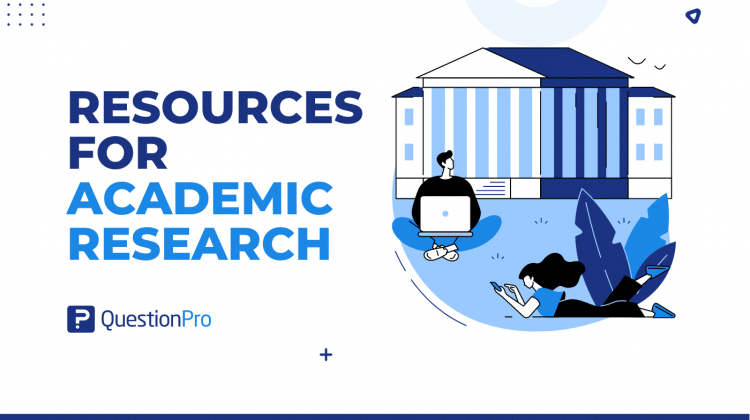
It is best to use scholarly or professional resources that are reliable, accurate, and valid for academic coursework and resources for academic research project assignments.
These are typically books and articles that have been reviewed before publication, but they can also be media and websites from reputable organizations and institutions.
When you do a research project, write a paper, or start a blog, you would then read articles to see what other people have done and then build on their work.
What are Resources for Academic Research?
Resources for academic research are the tools, materials, and information sources that scholars, students, and researchers use to conduct thorough and accurate research on a given topic.
Academic journals, books, online databases, primary and secondary sources, and research tools such as citation generators, reference managers, and statistical analysis software are examples of these resources .
Access to reliable and diverse resources is essential for producing high-quality academic work that is credible, informative, and current.
12 Best Websites, Tools & Resources for Academic Research
What sources will lead you to trustworthy resources for academic research? When you need to find sources, use these academic resources instead of scrolling through pages of search results.
- Google Scholar
Google Scholar offers a wide range of scholarly literature, including articles, theses, books, and conference papers, making it a great resource for academic study.
Google Scholar allows researchers to search for information on a topic, find relevant material for their literature review, track citations of their work, remain up-to-date on new research in their field, and evaluate their work using metrics like the h-index and i10-index.
It’s a comprehensive, user-friendly academic research resource with powerful search capabilities, email alerts, and Google integration. This important website helps researchers find, access, and manage research data.
Features:
- Keyword, author, or title search box for scholarly literature.
- Tracking your work’s citations.
- Advanced search filters by publication date, author, or journal.
- Full-text articles and papers for convenient reference.
- Email alerts for keywords or topics to remain current on research in your profession.
- Work impact metrics like the h-index and i10-index.
- Google Books and Google Drive integration for saving and organizing research resources.
JSTOR is an online library with academic journals, books, and primary sources from many fields. It was started in 1995 as a non-profit organization by JSTOR Inc. and a number of academic institutions.
More than 12 million academic articles and books from more than 2,000 publishers are in JSTOR’s online library. Content on JSTOR comes from many different fields, such as the humanities, social sciences, and natural sciences.
Individuals and institutions can subscribe to JSTOR’s digital library, and researchers, students, and scholars worldwide use it as a reliable and complete resource for academic research.
- JSTOR offers scholarly journals, books, and primary materials.
- JSTOR material spans humanities, social sciences, and natural sciences.
- JSTOR’s stored content, including historical records, gives academics a broad perspective.
- Users can search the platform’s huge database for keywords, authors, titles, and more.
- PDFs of JSTOR articles can be downloaded.
- Sharing, citation, and exporting options help scholars collaborate on the platform.
- JSTOR’s pricing makes it’s content affordable for all sizes and budgets.
ProQuest is a global information content and technology company that gives access to research databases, electronic books, and digital archives. Eugene B. Power started it in 1938 as University Microfilms to store and distribute dissertations and theses on microfilm.
Today, ProQuest gives you access to a wide range of content, such as academic journals, newspapers, dissertations, and primary sources. The databases on ProQuest cover a wide range of subjects, including the social sciences, the humanities, and the natural sciences.
Researchers, students, and scholars worldwide use ProQuest because it is a reliable, all-inclusive resource for academic research.
Features :
- Offers access to research databases, e-books, and digital archives in a wide range of fields.
- There are a lot of academic journals, newspapers, dissertations, and primary sources in this collection.
- Included are the social sciences, the humanities, and the natural sciences.
- Users can search by author, title, keyword, subject, and other criteria.
- Many of its databases let you read articles and other materials in full text.
- Includes tools for saving research, organizing it, and sharing it with others.
- Offers different pricing options so that people and organizations of all sizes and budgets can use it.
- Offers easy access to ProQuest’s services through mobile apps and the web so that they can be used from anywhere.
- Users can get a lot of help with customer service and training.
- ResearchGate
ResearchGate is a social networking site for academics and researchers to cooperate. In 2008, a group of scientists founded it to allow researchers to share their work, communicate, and network.
One of the largest research communities online, ResearchGate has over 17 million users. The platform lets scholars create profiles, share publications, ask and answer questions, and network with like-minded researchers.
A citation tracker and reputation score help scholars manage their research activity on ResearchGate.
- A social network for scientists and researchers.
- Enables scholars to create profiles, share work, and network.
- Researcher cooperation and discussion platform.
- A citation tracker, online reputation score , and analytics assist scholars in managing their research.
- Job board and career resource for researchers.
- Allows field researchers to ask and answer questions.
- Offers a news feed on cutting-edge research.
- Provides scholars with peer assessment and feedback.
- Allows researchers to advertise their work and gain academic recognition.
- Provides free and premium memberships.
Zotero, a free, open-source reference manager, helps scholars organize and credit their sources. The George Mason University Roy Rosenzweig Center for History and New Media was founded in 2006.
Zotero lets users organize and search papers, books, web pages, and other study materials. It connects with various online browsers to gather and save research sources when surfing.
Researchers may easily format their citations and bibliographies in their discipline’s style with Zotero’s several citation formats. As a handy and effective tool for managing research resources, researchers, students, and scholars worldwide use it.
- A free, open-source reference manager.
- Organizes, stores, and cites research sources.
- Organizes and stores research items in a searchable database.
- It connects with various online browsers to gather and save research sources when surfing.
- Offers a variety of citation styles for producing citations and bibliographies.
- Enables people to share their research.
- Provides note-taking, labeling, and research source highlighting features.
- Automatically refreshes and syncs devices for easy research access.
- Provides many plugins and add-ons to increase functionality.
- Includes excellent documentation and a helpful user community.
Mendeley, a free reference management and academic, social network, lets researchers organize and share their articles and resources. It was started in 2008 by academicians and software developers and acquired by Elsevier in 2013.
Mendeley lets users create a searchable database of research papers, books, and other resources, including citation management, collaboration, and discovery capabilities. It offers groups, profiles, and suggestions to assist the researcher’s network.
Mendeley is a convenient and effective research management tool used by academics, students, and intellectuals worldwide.
- Free academic networking and reference management.
- Helps scholars organize and share papers and resources.
- Provides a searchable database of research papers, books, etc.
- Citation, collaboration, and discovery tools.
- Helps researchers network with groups, profiles, and recommendations.
- Annotates, highlights, and organizes research.
- Formats citations and bibliographies in several fields.
- Plugins and add-ons for major word processing and research applications.
- Automatic updates and device syncing make research materials accessible anywhere.
- Has a strong user community and substantial documentation.
Grammarly is a real-time writing tool that checks spelling, punctuation, and style. It was created in 2009 by linguists and software engineers and is now one of the most popular writing tools.
Grammarly is available as a browser extension, a desktop program for Windows and macOS, and a web app. It comes in free and premium versions, with the premium version adding genre-specific writing style advice, plagiarism detection, and readability scoring.
Grammarly improves writing for millions of writers, students, and professionals worldwide.
- Real-time grammar and spelling checker for writers.
- Helps writers improve style and tone.
- Software engineers and linguists created it.
- Use a web app, browser extension, or desktop software.
- Free and paid versions are available.
- The premium edition includes genre-specific writing style suggestions, plagiarism detection, and a readability score.
- Helps writers improve their writing quality and clarity.
- Available in English and others.
- Compatible with Google Documents, Microsoft Word, and others.
- Provides thorough grammar and writing instructions in an easy-to-use interface.
- Helps non-native English speakers improve their writing.
- Microsoft Academic
Microsoft Research created the free public search engine Microsoft Academic. It offers scientific, technological, engineering, mathematical, social science, and humanities research papers, journals, conference proceedings, and other scholarly publications.
Microsoft Academic leverages advanced natural language processing and machine learning to recognize author, publication, and research domain relationships, making it easier for scholars to find relevant material and track field changes. Citation analysis, research network visualization, and author profile management are also available.
- A free public search engine built by Microsoft Research.
- Accesses academic journals, conference proceedings, research papers, and other scholarly publications.
- Understands authors, publications, and research fields using advanced natural language processing and machine learning.
- Helps researchers find relevant literature and follow industry trends.
- Citation analysis, visualization of research networks, and author profile creation and management are available.
- Has powerful filters and semantic search in a user-friendly interface.
- Citation counts, trends, and co-authorship networks are provided.
- Enables users to set personalized research alerts.
- APIs enable developers to access data and functionality.
- Zotero and Mendeley integration supported.
Evernote lets users capture, organize, and share notes and information across devices. It helps users recall everything from personal notes and to-do lists to business documents and research notes.
Evernote lets users make and save notes in text, photos, audio, and site clippings. Tagging, search, and device synchronization make it easy for users to find and retrieve their notes anytime, anywhere.
The premium edition of Evernote includes PDF annotation, presentation mode, and team collaboration.
- Note-taking app for multiple platforms.
- Enables users to take, organize, and share notes across devices.
- Helps users recall anything from personal notes and to-do lists to research and business paperwork.
- Enables users to make and save notes in numerous formats, including text, photos, audio, and site clippings.
- Allows users to find and retrieve their notes anytime, anywhere, with labeling, search, and device syncing.
- Has configurable notebooks and notes and a simple interface.
- Offers note formatting, annotation, and editing features.
- Supports Google Drive, Slack, and other productivity apps.
- Provides a free version with limited functionality and a paid version with PDF annotation, presentation mode, and team collaboration.
- Search notes, journals, and tags with a sophisticated search function.
- To keep organized, lets users set reminders and make to-do lists.
The US National Library of Medicine (NLM) of the National Institutes of Health (NIH) maintains PubMed, a free biomedical literature and research article database (NIH). It comprises over 32 million citations and abstracts of papers from more than 8,000 biomedical journals and books, dissertations, and other health and medicine-related resources.
PubMed covers a wide range of medical issues, including clinical research, genetics, nursing, and pharmacology. Medical researchers, students, and professionals can use it to find the newest medical research.
- Free biomedical research article database.
- Managed by the US National Library of Medicine (NLM) at the NIH (NIH)
- 32 million citations and abstracts from over 8,000 biomedical journals.
- Clinical research, genetics, nursing, pharmacology, and more.
- Obtains full-text articles from PubMed Central (PMC)
- Includes Boolean operators, search fields, and filters.
- Accesses MeSH, a fully controlled vocabulary for indexing articles.
- Saves and exports search results and send email alerts for new publications matching search criteria.
- Has a simple interface and search tools.
- Links to important publications, citations, and other resources.
- PubMed has a smartphone app.
- QuestionPro Insight Hub
QuestionPro Insight Hub connects businesses and organizations to millions of consumers and expert panelists globally for market research. The platform allows users to build surveys, run polls, conduct focus groups, and collect data from social media, email, mobile devices, and websites. Advanced analytics and reporting options enable users to evaluate data and understand customer behavior, preferences, and opinions.
Businesses may use QuestionPro Insight Hub to acquire real-time feedback from their target audience, optimize their products and services, and make informed business decisions based on consumer insights. The platform is appropriate for startups to enterprise-level enterprises in fields including healthcare, education, finance, and more.
- Access to millions of professional and consumer panelists all over the world
- Customizable surveys with different types of questions, themes, and templates
- Advanced logic and branching options for surveys
- Integration with many data collection sources, like social media, email, mobile devices, and websites
- Text analytics and sentiment analysis are built in for free-form responses.
- Real-time reporting and analytics with dashboards and charts that the user can change
- Collaboration tools that let team members share surveys, results, and insights
- Survey participants can get invitations and reminders by email that they can customize.
- Tools for running moderated and unmoderated discussions in online focus groups
- Polling tools to get quick feedback from customers and stakeholders and to get them involved
- Targeting options that make it easier to reach specific groups and demographics
- Compliance with GDPR and CCPA for privacy and security of data
- API and the ability to connect to other business platforms and applications.
- QuestionPro Live polls
QuestionPro Live Polls lets presenters communicate with their audience by running live polls during presentations, meetings, webinars, and other events that require real-time input. Presenters can modify QuestionPro Live Polls and obtain rapid audience reactions.
QuestionPro Live Polls include:
- Different question kinds.
- Configurable designs.
- Real-time live polling results.
- Multiple distribution choices.
- Audience engagement tools.
- Analytics and reporting.
- Integration with other platforms.
The solution lets presenters generate multiple-choice, rating scales, and open-ended polls.
SMS, email, QR codes, and social media to distribute QuestionPro Live Polls. Presenters and guests can instantly see real-time polling results on the screen. Presenters can quickly poll their audience regardless of location or device.
QuestionPro Live Polls encourages audience participation with countdown timers, animations, and gamification. Presenters can learn about audience opinions, preferences, and habits using poll analytics and reporting.
QuestionPro Live Polls is great for audience engagement, real-time feedback, and interactive presentations and events.
Features:
- Multiple question types, including multiple-choice, rating scales, and open-ended questions
- Poll designs that can be changed to fit the theme of the presentation or event
- The results of the poll were shown on the screen right away.
- Several ways to spread the word, like SMS, email, QR codes, and social media
- Tools for getting people to pay attention, such as countdown timers, animations, and gamification elements
- Analytics and reporting tools can help you determine what your audience thinks, likes, and does.
- Integration with other platforms, like PowerPoint, Zoom, and other video conferencing tools
- You can target your audience based on different demographic and psychographic factors to get more accurate feedback and insights.
LEARN ABOUT: Speaker evaluation form
In conclusion, the 12 best websites, tools, and resources for academic research offer students, scholars, and researchers a wealth of information and tools to help them in their quest for knowledge. Databases, search engines, citation generators, and collaboration tools are just a few of the features these resources offer.
Using these resources, researchers can improve their research and produce high-quality academic work. Researchers should keep up with the latest tools and technologies, as these can greatly improve their research and help their field advance.
QuestionPro’s Insight Hub and Livepolls are powerful data collection tools. These tools have various features, such as doing surveys, visualizing data, and polling in real-time, which can greatly improve the research process.
With the ability to collect data from a wide range of sources, researchers can gain valuable insights and come to conclusions that are based on facts. Combining these two tools can help researchers do high-quality research and make important contributions to their field. So get more help for your academic research with the help of QuestionPro.
MORE LIKE THIS

Data Information vs Insight: Essential differences
May 14, 2024

Pricing Analytics Software: Optimize Your Pricing Strategy
May 13, 2024


Relationship Marketing: What It Is, Examples & Top 7 Benefits
May 8, 2024

The Best Email Survey Tool to Boost Your Feedback Game
May 7, 2024
Other categories
- Academic Research
- Artificial Intelligence
- Assessments
- Brand Awareness
- Case Studies
- Communities
- Consumer Insights
- Customer effort score
- Customer Engagement
- Customer Experience
- Customer Loyalty
- Customer Research
- Customer Satisfaction
- Employee Benefits
- Employee Engagement
- Employee Retention
- Friday Five
- General Data Protection Regulation
- Insights Hub
- Life@QuestionPro
- Market Research
- Mobile diaries
- Mobile Surveys
- New Features
- Online Communities
- Question Types
- Questionnaire
- QuestionPro Products
- Release Notes
- Research Tools and Apps
- Revenue at Risk
- Survey Templates
- Training Tips
- Uncategorized
- Video Learning Series
- What’s Coming Up
- Workforce Intelligence
Where to find peer reviewed articles for research
This is our ultimate guide to helping you get familiar with your research field and find peer reviewed articles in the Web of Science™. It forms part of our Research Smarter series.
Finding relevant research and journal articles in your field is critical to a successful research project. Unfortunately, it can be one of the hardest, most time-consuming challenges for academics.
This blog outlines how you can leverage the Web of Science citation network to complete an in-depth, comprehensive search for literature. We share insights about how you can find a research paper and quickly assess its impact. We also explain how to create alerts to keep track of new papers in your field – whether you’re new to the topic or about to embark on a literature review.
- Choosing research databases for your search
- Where to find peer reviewed articles? Master the keyword search
- Filter your results and analyze for trends
- Explore the citation network
- Save your searches and set up alerts for new journal articles
1. Choosing research databases for your search
The myriad search engines, research databases and data repositories all differ in reliability, relevancy and organization of data. This can make it tricky to navigate and assess what’s best for your research at hand.
The Web of Science stands out the most powerful and trusted citation database. It helps you connect ideas and advance scientific research across all fields and disciplines. This is made possible with best-in-class publication and citation data for confident discovery and assessment of journal articles. The Web of Science is also publisher-neutral, carefully-curated by a team of expert editors and consists of 19 different research databases.
The Web of Science Core Collection™ is the single most authoritative source for how to find research articles, discover top authors , and relevant journals . It only includes journals that have met rigorous quality and impact criteria, and it captures billions of cited references from globally significant journals, books and proceedings ( check out its coverage ). Researchers and organizations use this research database regularly to track ideas across disciplines and time.
Explore the Web of Science Core Collection
We recommend spending time exploring the Core Collection specifically because its advanced citation network features are unparalleled. If you are looking to do an exhaustive search of a specific field, you might want to switch to one of the field-specific databases like MEDLINE and INSPEC. You can also select “All databases” from the drop-down box on the main search page. This will cover all research databases your institution subscribes to. IF you are still unsure about where to find scholarly journal articles, you can learn more in our Quick Reference Guide, here, or try it out today.
“We recommend spending time exploring the Core Collection specifically because its advanced citation network features are unparalleled.”

2. Where to find peer reviewed articles? Master the keyword search
A great deal of care and consideration is needed to find peer review articles for research. It starts with your keyword search.
Your chosen keywords or search phrases cannot be too inclusive or limiting. They also require constant iteration as you become more familiar with your research field. Watch this video on search tips to learn more:
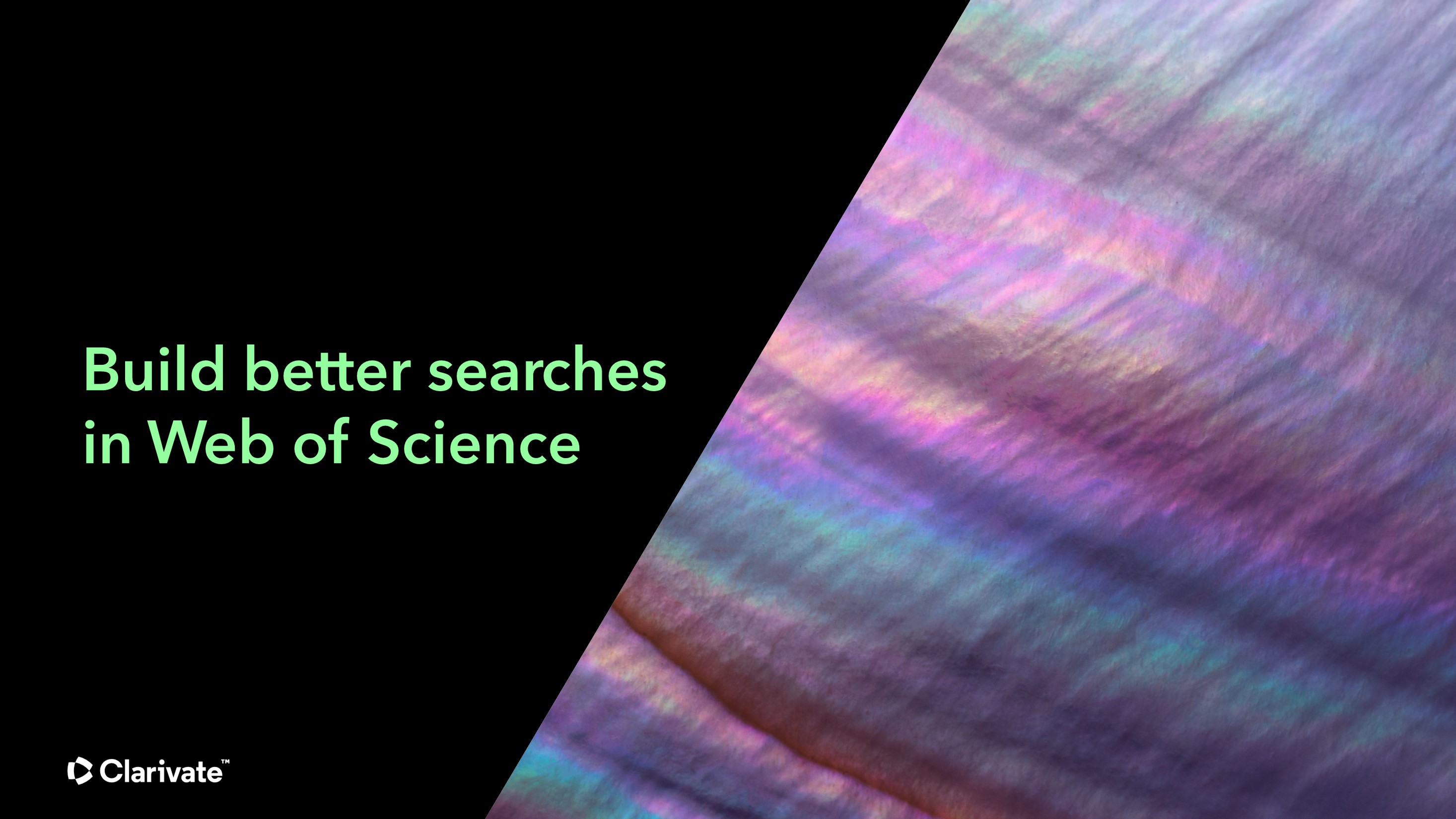
It’s worth noting that a repeated keyword search in the same Web of Science database will retrieve almost identical results every time, save for newly-indexed research. Not all research databases do this. If you are conducting a literature review and require a reproducible keyword search, it is best to steer clear of certain databases. For example, a research database that lacks overall transparency or frequently changes its search algorithm may be detrimental to your research.
3. Filter your search results and analyze trends
Group, rank and analyze the research articles in your search results to optimize the relevancy and efficiency of your efforts. In the Web of Science, researchers can cut through the data in a number of creative ways. This will help you when you’re stuck wondering where to find peer reviewed articles, journals and authors. The filter and refine tools , as well as the Analyze Results feature, are all at your disposal for this.
“Group, rank and analyze the research papers in your search results to optimize the relevancy and efficiency of your efforts.”
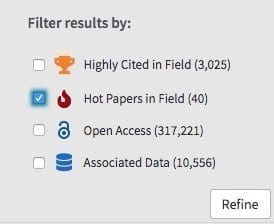
Filter and Refine tools in the Web of Science
You can opt for basic filter and refine tools in the Web of Science. These include subject category, publication date and open access within your search results. You can also filter by highly-cited research and hot research papers. A hot paper is a journal article that has accumulated rapid and significant numbers of citations over a short period of time.
The Analyze Results tool does much of this and more. It provides an interactive visualization of your results by the most prolific author, institution and funding agency, for example. This, combined, will help you understand trends across your field.
4. Explore the citation network
Keyword searches are essentially an a priori view of the literature. Citation-based searching, on the other hand, leads to “systematic serendipity”. This term was used by Eugene Garfield, the founder of Web of Science. New scientific developments are linked to the global sphere of human knowledge through the citation network. The constantly evolving connections link ideas and lead to systematic serendipity, allowing for all sorts of surprising discoveries.
Exploring the citation network helps you to:
- Identify a seminal research paper in any field. Pay attention to the number of times a journal article is cited to achieve this.
- Track the advancement of research as it progresses over time by analyzing the research papers that cite the original source. This will also help you catch retractions and corrections to research.
- Track the evolution of a research paper backward in time by tracking the work that a particular journal article cites.
- View related references. A research paper may share citations with another piece of work (calculated from bibliographic coupling). That means it’s likely discussing a similar topic.

Visualizing the history discoveries in the citation network
The Web of Science Core Collection indexes every piece of content cover-to-cover. This creates a complete and certain view of more than 115 years of the highest-quality journal articles. The depth of coverage enables you to uncover the historical trail of a research paper in your field. By doing so, it helps you visualize how discoveries unfold through time. You can also learn where they might branch off into new areas of research. Achieve this in your search by ordering your result set by date of publication.
As PhD student Rachel Ragnhild Carlson (Stanford University) recently wrote in a column for Nature: [1]
”As a PhD student, I’ve learnt to rely not just on my Web of Science research but on numerous conversations with seasoned experts. And I make sure that my reading includes literature from previous decades, which often doesn’t rise to the top of a web search. This practice is reinforced by mentors in my lab, who often find research gems by filtering explicitly for studies greater than ten years old.”
5. Save your search and set up alerts for new journal articles
Save time and keep abreast of new journal articles in your field by saving your searches and setting up email alerts . This means you can return to your search at any time. You can also stay up-to-date about a new research paper included in your search result. This will help you find an article more easily in the future. Head over to Web of Science to try it out today.
“Everyone should set up email alerts with keywords for PubMed, Web of Science, etc. Those keyword lists will evolve and be fine-tuned over time. However, it really helps to get an idea of recent publications.” Thorbjörn Sievert , PhD student, University of Jyväskylä
[1] Ragnhild Carlson, R. 2020 ‘How Trump’s embattled environment agency prepared me for a PhD’, Nature 579, 458
Related posts
Reimagining research impact: introducing web of science research intelligence.

Beyond discovery: AI and the future of the Web of Science

Clarivate welcomes the Barcelona Declaration on Open Research Information

Reference management. Clean and simple.
The top list of research databases for medicine and healthcare

3. Cochrane Library
4. pubmed central (pmc), 5. uptodate, frequently asked questions about research databases for medicine and healthcare, related articles.
Web of Science and Scopus are interdisciplinary research databases and have a broad scope. For biomedical research, medicine, and healthcare there are a couple of outstanding academic databases that provide true value in your daily research.
Scholarly databases can help you find scientific articles, research papers , conference proceedings, reviews and much more. We have compiled a list of the top 5 research databases with a special focus on healthcare and medicine.
PubMed is the number one source for medical and healthcare research. It is hosted by the National Institutes of Health (NIH) and provides bibliographic information including abstracts and links to the full text publisher websites for more than 28 million articles.
- Coverage: around 35 million items
- Abstracts: ✔
- Related articles: ✔
- References: ✘
- Cited by: ✘
- Links to full text: ✔
- Export formats: XML, NBIB
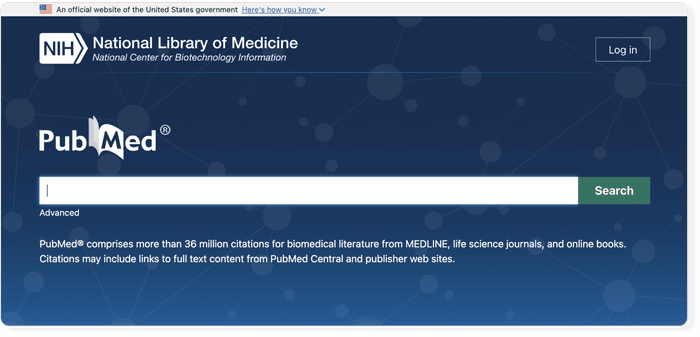
Pro tip: Use a reference manager like Paperpile to keep track of all your sources. Paperpile integrates with PubMed and many popular databases. You can save references and PDFs directly to your library using the Paperpile buttons and later cite them in thousands of citation styles:
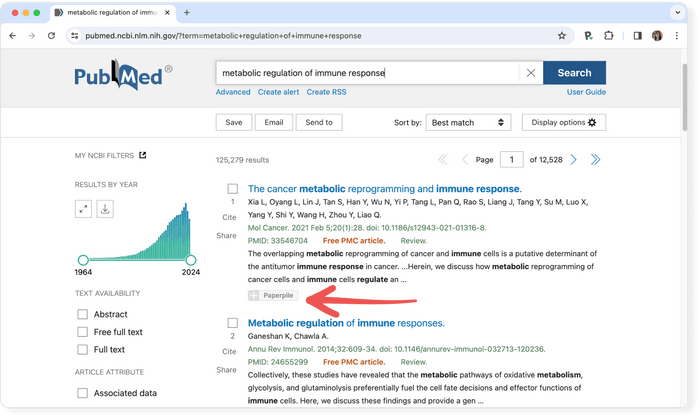
EMBASE (Excerpta Medica Database) is a proprietary research database that also includes PubMed. It can also be accessed by other database providers such as Ovid .
- Coverage: 38 million articles
- References: ✔
- Cited by: ✔
- Full text: ✔ (requires institutional subscription to EMBASE and individual publishers)
- Export formats: RIS
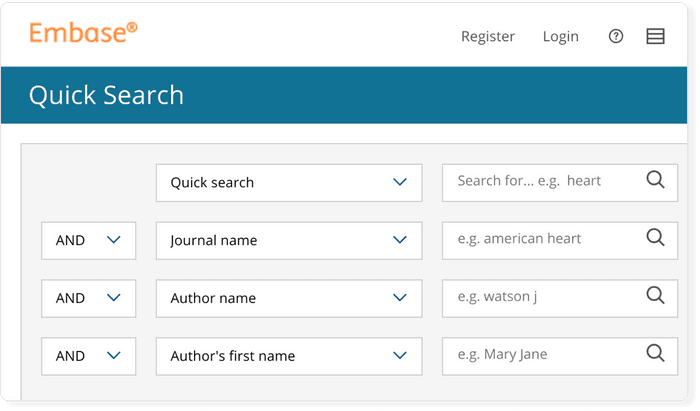
The Cochrane Library is best know for its systematic reviews. There are 53 review groups around the world that ensure that the published reviews are of high-quality and evidence based. Articles are updated over time to reflect new research.
- Coverage: several thousand high quality reviews
- Full text: ✔
- Export formats: RIS, BibTeX
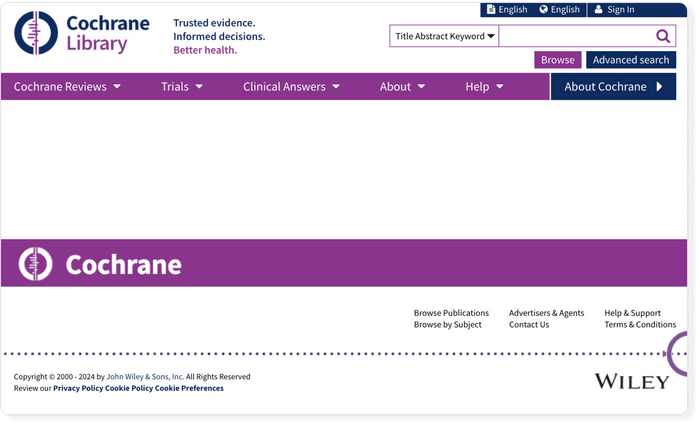
PubMed Central is the free, open access branch of PubMed. It includes full-text versions for all indexed papers. You might also want to check out its sister site Europe PMC .
- Coverage: more than 8 million articles
- Export formats: APA, MLA, AMA, RIS, NBIB

Like the Cochrane Library, UpToDate provides detailed reviews for clinical topics. Reviews are constantly updated to provide an up-to-date view.
- Coverage: several thousand articles from over 420 peer-reviewed journals
- Related articles: ✘
- Full text: ✔ (requires institutional subscription)
- Export formats: ✘
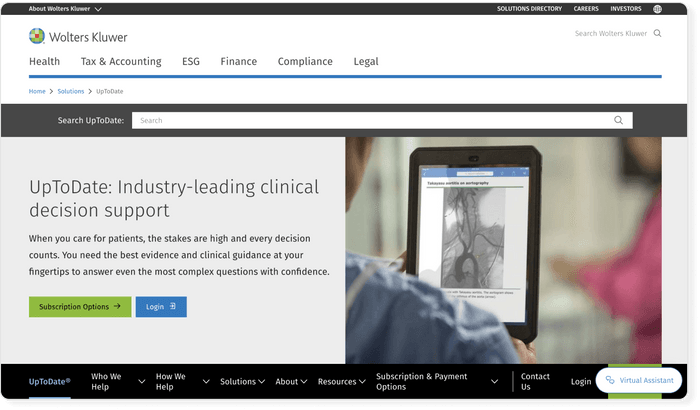
PubMed is the number one source for medical and healthcare research. It is hosted at the National Institutes of Health (NIH) and provides bibliographic information including abstracts and links to the full text publisher websites for more than 35 million items.
EMBASE (Excerpta Medica Database) is a proprietary research database that also includes in its corpus PubMed. It can also be accessed by other database providers such as Ovid.
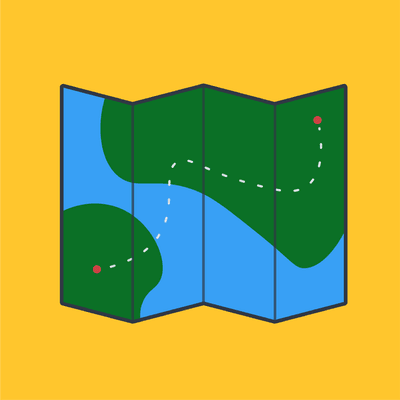
🇺🇦 make metadata, not war
A comprehensive bibliographic database of the world’s scholarly literature
The world’s largest collection of open access research papers, machine access to our vast unique full text corpus, core features, indexing the world’s repositories.
We serve the global network of repositories and journals
Comprehensive data coverage
We provide both metadata and full text access to our comprehensive collection through our APIs and Datasets
Powerful services
We create powerful services for researchers, universities, and industry
Cutting-edge solutions
We research and develop innovative data-driven and AI solutions
Committed to the POSI
Cost-free PIDs for your repository
OAI identifiers are unique identifiers minted cost-free by repositories. Ensure that your repository is correctly configured, enabling the CORE OAI Resolver to redirect your identifiers to your repository landing pages.
OAI IDs provide a cost-free option for assigning Persistent Identifiers (PIDs) to your repository records. Learn more.
Who we serve?
Enabling others to create new tools and innovate using a global comprehensive collection of research papers.

“ Our partnership with CORE will provide Turnitin with vast amounts of metadata and full texts that we can ... ” Show more
Gareth Malcolm, Content Partner Manager at Turnitin
Academic institutions.
Making research more discoverable, improving metadata quality, helping to meet and monitor open access compliance.

“ CORE’s role in providing a unified search of repository content is a great tool for the researcher and ex... ” Show more
Nicola Dowson, Library Services Manager at Open University
Researchers & general public.
Tools to find, discover and explore the wealth of open access research. Free for everyone, forever.

“ With millions of research papers available across thousands of different systems, CORE provides an invalu... ” Show more
Jon Tennant, Rogue Paleontologist and Founder of the Open Science MOOC
Helping funders to analyse, audit and monitor open research and accelerate towards open science.

“ Aggregation plays an increasingly essential role in maximising the long-term benefits of open access, hel... ” Show more
Ben Johnson, Research Policy Adviser at Research England
Our services, access to raw data.
Create new and innovative solutions.
Content discovery
Find relevant research and make your research more visible.
Managing content
Manage how your research content is exposed to the world.
Companies using CORE

Gareth Malcolm
Content Partner Manager at Turnitin
Our partnership with CORE will provide Turnitin with vast amounts of metadata and full texts that we can utilise in our plagiarism detection software.
Academic institution using CORE
Kathleen Shearer
Executive Director of the Confederation of Open Access Repositories (COAR)
CORE has significantly assisted the academic institutions participating in our global network with their key mission, which is their scientific content exposure. In addition, CORE has helped our content administrators to showcase the real benefits of repositories via its added value services.
Partner projects

Ben Johnson
Research Policy Adviser
Aggregation plays an increasingly essential role in maximising the long-term benefits of open access, helping to turn the promise of a 'research commons' into a reality. The aggregation services that CORE provides therefore make a very valuable contribution to the evolving open access environment in the UK.

- Stream Your Favorite Sports
- Where to Watch WNBA Games
The Best Research and Reference Websites
Where to look when you need information
:max_bytes(150000):strip_icc():format(webp)/stacy-fisher-9842c081a15b4def99bfd26b4822be19.jpg)
- Emporia State University
- Cloud Services
- Error Messages
- Family Tech
- Home Networking
- Around the Web
Research websites come in handy in all kinds of situations, whether you're looking for the average rainfall in the Amazon rainforest, researching Roman history, or just having fun learning to find information.
This list of the best research websites will help greatly, and most of them are updated daily with new information.
I like to pair these sites with free research organizational tools to keep track of everything I gather online.
Best Research Websites
- Library of Congress : LOC.gov lets you not only ask a librarian for help , but also search catalogs of libraries from all over the world. This is truly a huge resource that should be on your Top 10 best research sites list. Anything from Academia Sinica in Taiwan to Yale University in the U.S. is here and ready to be searched.
- ReferenceDesk.org : Dubbed "The Internet's Best Reference Source," this extremely useful web directory provides everything from business and finance information to federal government resources, scholarship details, links to newspapers and calendars, search engines, and more.
- Ask the Space Expert: NASA's source for space and science research help. Use the video links to listen to questions answered by experts. These are from 2013 through 2015.
- USA.gov : This is where you should start when looking for specific U.S. government information. Learn about the country in general or education, housing, disability services, jobs, taxes, laws, and more.
- Reference.com : Extremely simple to use with a basic layout, this reference website lets you browse by category or search by keywords to research everything from food and health to history, beauty, education, technology, vehicles, art, and more.
- Refdesk.com : Billing itself as the internet's fact-checker, this site includes in-depth research links to breaking news, editorials, Today in History, Word of the Day, and other references.
- Encyclopedia.com : The #1 online encyclopedia that lets you search over 200 reference books and encyclopedias at once. The Picks of the week is a neat section to examine each week.
- Encyclopedia Britannica : One of the world's oldest encyclopedias online; has featured posts and category listings. The company launched in the 18th century and has been publishing exclusively online since 2011.
- Purdue University Quick Reference : This site has tons of information that includes resources specific to Purdue University and surrounding areas in Indiana. It also includes an Ask a Librarian service.
- Prescriber's Digital Reference : A wonderful research tool when gathering detailed medical information. The drug name browser includes summaries (dosage, description, and more) for hundreds of drugs.
- iTools.com : Serves as a gateway for reference and research links. It uses other websites for its searches, like YouTube and Google.
- ResearchGate : Scientific knowledge from over 160 million publication pages; browse topics in categories like engineering, biology, climate change, medicine, math, and more.
- Baseball-Reference.com : Here's everything you ever wanted to know about baseball.
- FOLDOC : Free Online Dictionary of Computing is a detailed computing dictionary for researching the meaning behind computer-related tools, standards, jargon, languages, and more. The "random" button is a fun way to learn new concepts.
Depending on the type of research you're doing or how you need to reference the information, you may need quick access to books. There are lots of places to find free book downloads , textbooks , and educational movies .
Other Ways to Do Research
Search engines like Google are a great way to perform online research. You can locate books, articles, interviews, and lots more. Learn how to search better to get the most out of your research.
Another top source of expert information is your local librarian— search for libraries near you at WorldCat . Librarians are trained to find answers to obscure questions, they're friendly, and best of all, you can talk with them face to face. They often ask you questions you might not have considered, leading to even better results. You can get help from librarians online, too, through some of the sources above.
Get the Latest Tech News Delivered Every Day
- The Best Free People Search Websites
- The 8 Best Free Genealogy Websites of 2024
- 17 Best Sites to Download Free Books in 2024
- The 10 Best ChatGPT Alternatives (2024)
- Best Niche Search Engines
- 22 Best Places to Get Free Kindle Books in 2024
- The 20 Best Free Learning Websites for Kids in 2024
- X Slang and Key Terms Explained
- The Top 10 Most Popular Sites on the Web (2024)
- 15 Best Free Web Tools to Organize Your Research
- The 8 Best Search Engines of 2024
- The 10 Best Free Online Classes for Adults in 2024
- The 60 Most Useful Alexa Skills of 2024
- The 7 Best Free PC Game Websites of 2024
- 13 Best Sites With Free Educational Movies
- 9 Best Sites for Public Domain Images

The 5 Best Platforms to Publish Your Academic Research
Academic research is a central component of scientific advancements and breakthrough innovations. However, your research journey is complex and ever-changing. You must take into consideration funding options, how to securely store your information, choosing where to publish your research, finding manuscript peer reviewers, and many more.
To keep up with the change, you and other researchers require modern, easy-to-navigate research platforms to help you uncover, store, verify, compile, and share content, data, and important insights to continue to carry out breakthrough research.
This article explains how to identify the best platforms for publishing your research and gives you a list of five platforms to help you publish. Towards the end, you’ll also see a mention of how Orvium can further assist you with publishing.
How to Identify the Best Platforms for Publishing
When trying to identify the best platforms for publishing your research, you have to consider several factors, including:
- Does the platform support your research journey ? Can you collaborate with other authors and researchers, discover public groups and research papers and manuscripts (including Open Access work), view interactive graphs, images, tables, etc., track citations, and build a professional research profile?
- Is the platform easy to use ? Does it offer rich functionalities that are easy to understand, and if so, which ones?
- Does it use artificial intelligence and machine learning ? Automated actions (email alerts, etc.) can help you unlock breakthroughs faster and deliver deeper insights.
- What security and governance does it have ? Platforms must be secure and compliant according to local regulations since researchers often deal with sensitive data.
The 5 Best Platforms to Publish Academic Research
Researchgate.
ResearchGate is a platform hosting over 135 million publication pages with a community of 20 million scientists. The platform allows you to show off your work, access papers and advice from other researchers, make contacts and even find jobs. Some of its more prominent features include:
- Dedicated Q&A section with searchable keywords to target experts in your particular field or area of study
- Ability to create a personal profile page where you can display all research-specific details about yourself, including up to five pieces of work (including datasets and conference papers)
- In-depth stats on who reads your work and the ability to track your citations
- A private messaging service that allows you to send messages to other researchers
- A comments section to provide feedback when viewing a paper
- A “projects” section to tell others about your upcoming work.
In addition, it's completely free to use!
Academia is a research-sharing platform with over 178 million users, 29 million papers uploaded, and 87 million visitors per month. Their goal is to accelerate research in all fields, ensure that all research is available for free and that the sharing of knowledge is available in multiple formats (videos, datasets, code, short-form content, etc.). Some of their more prominent features include:
- Mentions and search alerts that notify you when another researcher cites, thanks, or acknowledges your work, and automatic reports of search queries
- Ability to create a personal profile page
- “Profile visitor” and “readers” features let you know the title and location of those who visit your profile or read your papers so you can learn about their research interests and get in touch
- A “grants” feature to allow you to find new grants and fellowships in your field
- Advanced research discovery tools allow you to see full texts and citations of millions of papers.
The platform is based on a “freemium” business model, which provides free access to research for everyone, and paid capabilities to subscribers.
ScienceOpen
ScienceOpen is a discovery platform that empowers researchers to make an impact in their communities. The platform is committed to Open Science, combining decades of experience in traditional publishing, computing, and academic research to provide free access to knowledge to drive creativity, innovation, and development. Some of their more prominent features include:
- You can publish your most recent paper as a preprint that’s citable and includes a DOI to share with peers immediately and enhance visibility
- A multidimensional search feature for articles with 18 filters and the ability to sort results by Altmetric scores , citations, date, and rating
- Ability to create a personal profile with minimal upkeep necessary
- Access to a suite of metrics (usage, citations, etc.) of your publications
- Ability to follow other researchers to stay up-to-date on their work and expand your network.
The platform is free to use, although some features (like publishing your preprint) may cost money.
IOPscience is a platform that embraces innovative technologies to make it easier for researchers to discover and access technical, scientific, and medical content while managing their own research content. They participate in several programs that offer researchers in developing countries several ways to gain access to journals at little or no cost. Some of their other features include:
- An enhanced search filtering feature allows you to find relevant research faster
- A social bookmarking feature allows you to interact with other researchers and share articles
- Ability to create a personal profile, customize your alerts, view recently published articles within your field or area of interest, and save relevant papers or articles
- Ability to receive email alerts and RSS feeds once new content is published.
IOPscience is free to use and functions on an Open Access policy, which you can check here .
Orvium is an open, community-based research platform that allows researchers, reviewers, and publishers to share, publish, review, and manage their research. Orvium protects your work with built-in blockchain integration to ensure that you maintain the copyright of your work and not only. Some of our more notable features include:
- Access to a modern web platform with Google indexing, notifications, and mobile-ready features
- Ability to manage your entire publication process, with control over when you submit, receive peer reviews, and publish your paper
- “Collaboration” and “full traceability” features allow you to track your profile impact, get in touch with other researchers, and have ownership over your work
- Recognition badges or economic rewards are given when you peer-review.
Orvium is completely free to use.
Orvium Makes Choosing a Platform Easy
No matter what platform or community you choose to be a part of, you now know what you need to look for when choosing one. You also learned about five excellent platforms where you can publish your academic research. Orvium will remain your one-stop-shop platform for all your research needs. Do you want to know how Orvium and our communities work? Check out our platform or contact us with any questions you may have.
Subscribe to our newsletter
Get the latest posts delivered right to your inbox.

Now check your inbox and click the link to confirm your subscription.
Please enter a valid email address
Oops! There was an error sending the email, please try later.
Leyre Martínez
Recommended for you.

How to Write a Research Funding Application | Orvium

Increasing Representation and Diversity in Research with Open Science | Orvium

Your Guide to Open Access Week 2023
Thank you for visiting nature.com. You are using a browser version with limited support for CSS. To obtain the best experience, we recommend you use a more up to date browser (or turn off compatibility mode in Internet Explorer). In the meantime, to ensure continued support, we are displaying the site without styles and JavaScript.
- View all journals
- Explore content
- About the journal
- Publish with us
- Sign up for alerts
- Published: 08 May 2024
Accurate structure prediction of biomolecular interactions with AlphaFold 3
- Josh Abramson ORCID: orcid.org/0009-0000-3496-6952 1 na1 ,
- Jonas Adler ORCID: orcid.org/0000-0001-9928-3407 1 na1 ,
- Jack Dunger 1 na1 ,
- Richard Evans ORCID: orcid.org/0000-0003-4675-8469 1 na1 ,
- Tim Green ORCID: orcid.org/0000-0002-3227-1505 1 na1 ,
- Alexander Pritzel ORCID: orcid.org/0000-0002-4233-9040 1 na1 ,
- Olaf Ronneberger ORCID: orcid.org/0000-0002-4266-1515 1 na1 ,
- Lindsay Willmore ORCID: orcid.org/0000-0003-4314-0778 1 na1 ,
- Andrew J. Ballard ORCID: orcid.org/0000-0003-4956-5304 1 ,
- Joshua Bambrick ORCID: orcid.org/0009-0003-3908-0722 2 ,
- Sebastian W. Bodenstein 1 ,
- David A. Evans 1 ,
- Chia-Chun Hung ORCID: orcid.org/0000-0002-5264-9165 2 ,
- Michael O’Neill 1 ,
- David Reiman ORCID: orcid.org/0000-0002-1605-7197 1 ,
- Kathryn Tunyasuvunakool ORCID: orcid.org/0000-0002-8594-1074 1 ,
- Zachary Wu ORCID: orcid.org/0000-0003-2429-9812 1 ,
- Akvilė Žemgulytė 1 ,
- Eirini Arvaniti 3 ,
- Charles Beattie ORCID: orcid.org/0000-0003-1840-054X 3 ,
- Ottavia Bertolli ORCID: orcid.org/0000-0001-8578-3216 3 ,
- Alex Bridgland 3 ,
- Alexey Cherepanov ORCID: orcid.org/0000-0002-5227-0622 4 ,
- Miles Congreve 4 ,
- Alexander I. Cowen-Rivers 3 ,
- Andrew Cowie ORCID: orcid.org/0000-0002-4491-1434 3 ,
- Michael Figurnov ORCID: orcid.org/0000-0003-1386-8741 3 ,
- Fabian B. Fuchs 3 ,
- Hannah Gladman 3 ,
- Rishub Jain 3 ,
- Yousuf A. Khan ORCID: orcid.org/0000-0003-0201-2796 3 ,
- Caroline M. R. Low 4 ,
- Kuba Perlin 3 ,
- Anna Potapenko 3 ,
- Pascal Savy 4 ,
- Sukhdeep Singh 3 ,
- Adrian Stecula ORCID: orcid.org/0000-0001-6914-6743 4 ,
- Ashok Thillaisundaram 3 ,
- Catherine Tong ORCID: orcid.org/0000-0001-7570-4801 4 ,
- Sergei Yakneen ORCID: orcid.org/0000-0001-7827-9839 4 ,
- Ellen D. Zhong ORCID: orcid.org/0000-0001-6345-1907 3 ,
- Michal Zielinski 3 ,
- Augustin Žídek ORCID: orcid.org/0000-0002-0748-9684 3 ,
- Victor Bapst 1 na2 ,
- Pushmeet Kohli ORCID: orcid.org/0000-0002-7466-7997 1 na2 ,
- Max Jaderberg ORCID: orcid.org/0000-0002-9033-2695 2 na2 ,
- Demis Hassabis ORCID: orcid.org/0000-0003-2812-9917 1 , 2 na2 &
- John M. Jumper ORCID: orcid.org/0000-0001-6169-6580 1 na2
Nature ( 2024 ) Cite this article
230k Accesses
1 Citations
1152 Altmetric
Metrics details
We are providing an unedited version of this manuscript to give early access to its findings. Before final publication, the manuscript will undergo further editing. Please note there may be errors present which affect the content, and all legal disclaimers apply.
- Drug discovery
- Machine learning
- Protein structure predictions
- Structural biology
The introduction of AlphaFold 2 1 has spurred a revolution in modelling the structure of proteins and their interactions, enabling a huge range of applications in protein modelling and design 2–6 . In this paper, we describe our AlphaFold 3 model with a substantially updated diffusion-based architecture, which is capable of joint structure prediction of complexes including proteins, nucleic acids, small molecules, ions, and modified residues. The new AlphaFold model demonstrates significantly improved accuracy over many previous specialised tools: far greater accuracy on protein-ligand interactions than state of the art docking tools, much higher accuracy on protein-nucleic acid interactions than nucleic-acid-specific predictors, and significantly higher antibody-antigen prediction accuracy than AlphaFold-Multimer v2.3 7,8 . Together these results show that high accuracy modelling across biomolecular space is possible within a single unified deep learning framework.
You have full access to this article via your institution.
Similar content being viewed by others

Highly accurate protein structure prediction with AlphaFold

De novo generation of multi-target compounds using deep generative chemistry

Augmenting large language models with chemistry tools
Author information.
These authors contributed equally: Josh Abramson, Jonas Adler, Jack Dunger, Richard Evans, Tim Green, Alexander Pritzel, Olaf Ronneberger, Lindsay Willmore
These authors jointly supervised this work: Victor Bapst, Pushmeet Kohli, Max Jaderberg, Demis Hassabis, John M. Jumper
Authors and Affiliations
Core Contributor, Google DeepMind, London, UK
Josh Abramson, Jonas Adler, Jack Dunger, Richard Evans, Tim Green, Alexander Pritzel, Olaf Ronneberger, Lindsay Willmore, Andrew J. Ballard, Sebastian W. Bodenstein, David A. Evans, Michael O’Neill, David Reiman, Kathryn Tunyasuvunakool, Zachary Wu, Akvilė Žemgulytė, Victor Bapst, Pushmeet Kohli, Demis Hassabis & John M. Jumper
Core Contributor, Isomorphic Labs, London, UK
Joshua Bambrick, Chia-Chun Hung, Max Jaderberg & Demis Hassabis
Google DeepMind, London, UK
Eirini Arvaniti, Charles Beattie, Ottavia Bertolli, Alex Bridgland, Alexander I. Cowen-Rivers, Andrew Cowie, Michael Figurnov, Fabian B. Fuchs, Hannah Gladman, Rishub Jain, Yousuf A. Khan, Kuba Perlin, Anna Potapenko, Sukhdeep Singh, Ashok Thillaisundaram, Ellen D. Zhong, Michal Zielinski & Augustin Žídek
Isomorphic Labs, London, UK
Alexey Cherepanov, Miles Congreve, Caroline M. R. Low, Pascal Savy, Adrian Stecula, Catherine Tong & Sergei Yakneen
You can also search for this author in PubMed Google Scholar
Corresponding authors
Correspondence to Max Jaderberg , Demis Hassabis or John M. Jumper .
Supplementary information
Supplementary information.
This Supplementary Information file contains the following 9 sections: (1) Notation; (2) Data pipeline; (3) Model architecture; (4) Auxiliary heads; (5) Training and inference; (6) Evaluation; (7) Differences to AlphaFold2 and AlphaFold-Multimer; (8) Supplemental Results; and (9) Appendix: CCD Code and PDB ID tables.
Reporting Summary
Rights and permissions.
Reprints and permissions
About this article
Cite this article.
Abramson, J., Adler, J., Dunger, J. et al. Accurate structure prediction of biomolecular interactions with AlphaFold 3. Nature (2024). https://doi.org/10.1038/s41586-024-07487-w
Download citation
Received : 19 December 2023
Accepted : 29 April 2024
Published : 08 May 2024
DOI : https://doi.org/10.1038/s41586-024-07487-w
Share this article
Anyone you share the following link with will be able to read this content:
Sorry, a shareable link is not currently available for this article.
Provided by the Springer Nature SharedIt content-sharing initiative
This article is cited by
Major alphafold upgrade offers boost for drug discovery.
- Ewen Callaway
Nature (2024)
By submitting a comment you agree to abide by our Terms and Community Guidelines . If you find something abusive or that does not comply with our terms or guidelines please flag it as inappropriate.
Quick links
- Explore articles by subject
- Guide to authors
- Editorial policies
Sign up for the Nature Briefing: Translational Research newsletter — top stories in biotechnology, drug discovery and pharma.

Cultural Relativity and Acceptance of Embryonic Stem Cell Research
Article sidebar.

Main Article Content
There is a debate about the ethical implications of using human embryos in stem cell research, which can be influenced by cultural, moral, and social values. This paper argues for an adaptable framework to accommodate diverse cultural and religious perspectives. By using an adaptive ethics model, research protections can reflect various populations and foster growth in stem cell research possibilities.
INTRODUCTION
Stem cell research combines biology, medicine, and technology, promising to alter health care and the understanding of human development. Yet, ethical contention exists because of individuals’ perceptions of using human embryos based on their various cultural, moral, and social values. While these disagreements concerning policy, use, and general acceptance have prompted the development of an international ethics policy, such a uniform approach can overlook the nuanced ethical landscapes between cultures. With diverse viewpoints in public health, a single global policy, especially one reflecting Western ethics or the ethics prevalent in high-income countries, is impractical. This paper argues for a culturally sensitive, adaptable framework for the use of embryonic stem cells. Stem cell policy should accommodate varying ethical viewpoints and promote an effective global dialogue. With an extension of an ethics model that can adapt to various cultures, we recommend localized guidelines that reflect the moral views of the people those guidelines serve.
Stem cells, characterized by their unique ability to differentiate into various cell types, enable the repair or replacement of damaged tissues. Two primary types of stem cells are somatic stem cells (adult stem cells) and embryonic stem cells. Adult stem cells exist in developed tissues and maintain the body’s repair processes. [1] Embryonic stem cells (ESC) are remarkably pluripotent or versatile, making them valuable in research. [2] However, the use of ESCs has sparked ethics debates. Considering the potential of embryonic stem cells, research guidelines are essential. The International Society for Stem Cell Research (ISSCR) provides international stem cell research guidelines. They call for “public conversations touching on the scientific significance as well as the societal and ethical issues raised by ESC research.” [3] The ISSCR also publishes updates about culturing human embryos 14 days post fertilization, suggesting local policies and regulations should continue to evolve as ESC research develops. [4] Like the ISSCR, which calls for local law and policy to adapt to developing stem cell research given cultural acceptance, this paper highlights the importance of local social factors such as religion and culture.
I. Global Cultural Perspective of Embryonic Stem Cells
Views on ESCs vary throughout the world. Some countries readily embrace stem cell research and therapies, while others have stricter regulations due to ethical concerns surrounding embryonic stem cells and when an embryo becomes entitled to moral consideration. The philosophical issue of when the “someone” begins to be a human after fertilization, in the morally relevant sense, [5] impacts when an embryo becomes not just worthy of protection but morally entitled to it. The process of creating embryonic stem cell lines involves the destruction of the embryos for research. [6] Consequently, global engagement in ESC research depends on social-cultural acceptability.
a. US and Rights-Based Cultures
In the United States, attitudes toward stem cell therapies are diverse. The ethics and social approaches, which value individualism, [7] trigger debates regarding the destruction of human embryos, creating a complex regulatory environment. For example, the 1996 Dickey-Wicker Amendment prohibited federal funding for the creation of embryos for research and the destruction of embryos for “more than allowed for research on fetuses in utero.” [8] Following suit, in 2001, the Bush Administration heavily restricted stem cell lines for research. However, the Stem Cell Research Enhancement Act of 2005 was proposed to help develop ESC research but was ultimately vetoed. [9] Under the Obama administration, in 2009, an executive order lifted restrictions allowing for more development in this field. [10] The flux of research capacity and funding parallels the different cultural perceptions of human dignity of the embryo and how it is socially presented within the country’s research culture. [11]
b. Ubuntu and Collective Cultures
African bioethics differs from Western individualism because of the different traditions and values. African traditions, as described by individuals from South Africa and supported by some studies in other African countries, including Ghana and Kenya, follow the African moral philosophies of Ubuntu or Botho and Ukama , which “advocates for a form of wholeness that comes through one’s relationship and connectedness with other people in the society,” [12] making autonomy a socially collective concept. In this context, for the community to act autonomously, individuals would come together to decide what is best for the collective. Thus, stem cell research would require examining the value of the research to society as a whole and the use of the embryos as a collective societal resource. If society views the source as part of the collective whole, and opposes using stem cells, compromising the cultural values to pursue research may cause social detachment and stunt research growth. [13] Based on local culture and moral philosophy, the permissibility of stem cell research depends on how embryo, stem cell, and cell line therapies relate to the community as a whole. Ubuntu is the expression of humanness, with the person’s identity drawn from the “’I am because we are’” value. [14] The decision in a collectivistic culture becomes one born of cultural context, and individual decisions give deference to others in the society.
Consent differs in cultures where thought and moral philosophy are based on a collective paradigm. So, applying Western bioethical concepts is unrealistic. For one, Africa is a diverse continent with many countries with different belief systems, access to health care, and reliance on traditional or Western medicines. Where traditional medicine is the primary treatment, the “’restrictive focus on biomedically-related bioethics’” [is] problematic in African contexts because it neglects bioethical issues raised by traditional systems.” [15] No single approach applies in all areas or contexts. Rather than evaluating the permissibility of ESC research according to Western concepts such as the four principles approach, different ethics approaches should prevail.
Another consideration is the socio-economic standing of countries. In parts of South Africa, researchers have not focused heavily on contributing to the stem cell discourse, either because it is not considered health care or a health science priority or because resources are unavailable. [16] Each country’s priorities differ given different social, political, and economic factors. In South Africa, for instance, areas such as maternal mortality, non-communicable diseases, telemedicine, and the strength of health systems need improvement and require more focus [17] Stem cell research could benefit the population, but it also could divert resources from basic medical care. Researchers in South Africa adhere to the National Health Act and Medicines Control Act in South Africa and international guidelines; however, the Act is not strictly enforced, and there is no clear legislation for research conduct or ethical guidelines. [18]
Some parts of Africa condemn stem cell research. For example, 98.2 percent of the Tunisian population is Muslim. [19] Tunisia does not permit stem cell research because of moral conflict with a Fatwa. Religion heavily saturates the regulation and direction of research. [20] Stem cell use became permissible for reproductive purposes only recently, with tight restrictions preventing cells from being used in any research other than procedures concerning ART/IVF. Their use is conditioned on consent, and available only to married couples. [21] The community's receptiveness to stem cell research depends on including communitarian African ethics.
c. Asia
Some Asian countries also have a collective model of ethics and decision making. [22] In China, the ethics model promotes a sincere respect for life or human dignity, [23] based on protective medicine. This model, influenced by Traditional Chinese Medicine (TCM), [24] recognizes Qi as the vital energy delivered via the meridians of the body; it connects illness to body systems, the body’s entire constitution, and the universe for a holistic bond of nature, health, and quality of life. [25] Following a protective ethics model, and traditional customs of wholeness, investment in stem cell research is heavily desired for its applications in regenerative therapies, disease modeling, and protective medicines. In a survey of medical students and healthcare practitioners, 30.8 percent considered stem cell research morally unacceptable while 63.5 percent accepted medical research using human embryonic stem cells. Of these individuals, 89.9 percent supported increased funding for stem cell research. [26] The scientific community might not reflect the overall population. From 1997 to 2019, China spent a total of $576 million (USD) on stem cell research at 8,050 stem cell programs, increased published presence from 0.6 percent to 14.01 percent of total global stem cell publications as of 2014, and made significant strides in cell-based therapies for various medical conditions. [27] However, while China has made substantial investments in stem cell research and achieved notable progress in clinical applications, concerns linger regarding ethical oversight and transparency. [28] For example, the China Biosecurity Law, promoted by the National Health Commission and China Hospital Association, attempted to mitigate risks by introducing an institutional review board (IRB) in the regulatory bodies. 5800 IRBs registered with the Chinese Clinical Trial Registry since 2021. [29] However, issues still need to be addressed in implementing effective IRB review and approval procedures.
The substantial government funding and focus on scientific advancement have sometimes overshadowed considerations of regional cultures, ethnic minorities, and individual perspectives, particularly evident during the one-child policy era. As government policy adapts to promote public stability, such as the change from the one-child to the two-child policy, [30] research ethics should also adapt to ensure respect for the values of its represented peoples.
Japan is also relatively supportive of stem cell research and therapies. Japan has a more transparent regulatory framework, allowing for faster approval of regenerative medicine products, which has led to several advanced clinical trials and therapies. [31] South Korea is also actively engaged in stem cell research and has a history of breakthroughs in cloning and embryonic stem cells. [32] However, the field is controversial, and there are issues of scientific integrity. For example, the Korean FDA fast-tracked products for approval, [33] and in another instance, the oocyte source was unclear and possibly violated ethical standards. [34] Trust is important in research, as it builds collaborative foundations between colleagues, trial participant comfort, open-mindedness for complicated and sensitive discussions, and supports regulatory procedures for stakeholders. There is a need to respect the culture’s interest, engagement, and for research and clinical trials to be transparent and have ethical oversight to promote global research discourse and trust.
d. Middle East
Countries in the Middle East have varying degrees of acceptance of or restrictions to policies related to using embryonic stem cells due to cultural and religious influences. Saudi Arabia has made significant contributions to stem cell research, and conducts research based on international guidelines for ethical conduct and under strict adherence to guidelines in accordance with Islamic principles. Specifically, the Saudi government and people require ESC research to adhere to Sharia law. In addition to umbilical and placental stem cells, [35] Saudi Arabia permits the use of embryonic stem cells as long as they come from miscarriages, therapeutic abortions permissible by Sharia law, or are left over from in vitro fertilization and donated to research. [36] Laws and ethical guidelines for stem cell research allow the development of research institutions such as the King Abdullah International Medical Research Center, which has a cord blood bank and a stem cell registry with nearly 10,000 donors. [37] Such volume and acceptance are due to the ethical ‘permissibility’ of the donor sources, which do not conflict with religious pillars. However, some researchers err on the side of caution, choosing not to use embryos or fetal tissue as they feel it is unethical to do so. [38]
Jordan has a positive research ethics culture. [39] However, there is a significant issue of lack of trust in researchers, with 45.23 percent (38.66 percent agreeing and 6.57 percent strongly agreeing) of Jordanians holding a low level of trust in researchers, compared to 81.34 percent of Jordanians agreeing that they feel safe to participate in a research trial. [40] Safety testifies to the feeling of confidence that adequate measures are in place to protect participants from harm, whereas trust in researchers could represent the confidence in researchers to act in the participants’ best interests, adhere to ethical guidelines, provide accurate information, and respect participants’ rights and dignity. One method to improve trust would be to address communication issues relevant to ESC. Legislation surrounding stem cell research has adopted specific language, especially concerning clarification “between ‘stem cells’ and ‘embryonic stem cells’” in translation. [41] Furthermore, legislation “mandates the creation of a national committee… laying out specific regulations for stem-cell banking in accordance with international standards.” [42] This broad regulation opens the door for future global engagement and maintains transparency. However, these regulations may also constrain the influence of research direction, pace, and accessibility of research outcomes.
e. Europe
In the European Union (EU), ethics is also principle-based, but the principles of autonomy, dignity, integrity, and vulnerability are interconnected. [43] As such, the opportunity for cohesion and concessions between individuals’ thoughts and ideals allows for a more adaptable ethics model due to the flexible principles that relate to the human experience The EU has put forth a framework in its Convention for the Protection of Human Rights and Dignity of the Human Being allowing member states to take different approaches. Each European state applies these principles to its specific conventions, leading to or reflecting different acceptance levels of stem cell research. [44]
For example, in Germany, Lebenzusammenhang , or the coherence of life, references integrity in the unity of human culture. Namely, the personal sphere “should not be subject to external intervention.” [45] Stem cell interventions could affect this concept of bodily completeness, leading to heavy restrictions. Under the Grundgesetz, human dignity and the right to life with physical integrity are paramount. [46] The Embryo Protection Act of 1991 made producing cell lines illegal. Cell lines can be imported if approved by the Central Ethics Commission for Stem Cell Research only if they were derived before May 2007. [47] Stem cell research respects the integrity of life for the embryo with heavy specifications and intense oversight. This is vastly different in Finland, where the regulatory bodies find research more permissible in IVF excess, but only up to 14 days after fertilization. [48] Spain’s approach differs still, with a comprehensive regulatory framework. [49] Thus, research regulation can be culture-specific due to variations in applied principles. Diverse cultures call for various approaches to ethical permissibility. [50] Only an adaptive-deliberative model can address the cultural constructions of self and achieve positive, culturally sensitive stem cell research practices. [51]
II. Religious Perspectives on ESC
Embryonic stem cell sources are the main consideration within religious contexts. While individuals may not regard their own religious texts as authoritative or factual, religion can shape their foundations or perspectives.
The Qur'an states:
“And indeed We created man from a quintessence of clay. Then We placed within him a small quantity of nutfa (sperm to fertilize) in a safe place. Then We have fashioned the nutfa into an ‘alaqa (clinging clot or cell cluster), then We developed the ‘alaqa into mudgha (a lump of flesh), and We made mudgha into bones, and clothed the bones with flesh, then We brought it into being as a new creation. So Blessed is Allah, the Best of Creators.” [52]
Many scholars of Islam estimate the time of soul installment, marked by the angel breathing in the soul to bring the individual into creation, as 120 days from conception. [53] Personhood begins at this point, and the value of life would prohibit research or experimentation that could harm the individual. If the fetus is more than 120 days old, the time ensoulment is interpreted to occur according to Islamic law, abortion is no longer permissible. [54] There are a few opposing opinions about early embryos in Islamic traditions. According to some Islamic theologians, there is no ensoulment of the early embryo, which is the source of stem cells for ESC research. [55]
In Buddhism, the stance on stem cell research is not settled. The main tenets, the prohibition against harming or destroying others (ahimsa) and the pursuit of knowledge (prajña) and compassion (karuna), leave Buddhist scholars and communities divided. [56] Some scholars argue stem cell research is in accordance with the Buddhist tenet of seeking knowledge and ending human suffering. Others feel it violates the principle of not harming others. Finding the balance between these two points relies on the karmic burden of Buddhist morality. In trying to prevent ahimsa towards the embryo, Buddhist scholars suggest that to comply with Buddhist tenets, research cannot be done as the embryo has personhood at the moment of conception and would reincarnate immediately, harming the individual's ability to build their karmic burden. [57] On the other hand, the Bodhisattvas, those considered to be on the path to enlightenment or Nirvana, have given organs and flesh to others to help alleviate grieving and to benefit all. [58] Acceptance varies on applied beliefs and interpretations.
Catholicism does not support embryonic stem cell research, as it entails creation or destruction of human embryos. This destruction conflicts with the belief in the sanctity of life. For example, in the Old Testament, Genesis describes humanity as being created in God’s image and multiplying on the Earth, referencing the sacred rights to human conception and the purpose of development and life. In the Ten Commandments, the tenet that one should not kill has numerous interpretations where killing could mean murder or shedding of the sanctity of life, demonstrating the high value of human personhood. In other books, the theological conception of when life begins is interpreted as in utero, [59] highlighting the inviolability of life and its formation in vivo to make a religious point for accepting such research as relatively limited, if at all. [60] The Vatican has released ethical directives to help apply a theological basis to modern-day conflicts. The Magisterium of the Church states that “unless there is a moral certainty of not causing harm,” experimentation on fetuses, fertilized cells, stem cells, or embryos constitutes a crime. [61] Such procedures would not respect the human person who exists at these stages, according to Catholicism. Damages to the embryo are considered gravely immoral and illicit. [62] Although the Catholic Church officially opposes abortion, surveys demonstrate that many Catholic people hold pro-choice views, whether due to the context of conception, stage of pregnancy, threat to the mother’s life, or for other reasons, demonstrating that practicing members can also accept some but not all tenets. [63]
Some major Jewish denominations, such as the Reform, Conservative, and Reconstructionist movements, are open to supporting ESC use or research as long as it is for saving a life. [64] Within Judaism, the Talmud, or study, gives personhood to the child at birth and emphasizes that life does not begin at conception: [65]
“If she is found pregnant, until the fortieth day it is mere fluid,” [66]
Whereas most religions prioritize the status of human embryos, the Halakah (Jewish religious law) states that to save one life, most other religious laws can be ignored because it is in pursuit of preservation. [67] Stem cell research is accepted due to application of these religious laws.
We recognize that all religions contain subsets and sects. The variety of environmental and cultural differences within religious groups requires further analysis to respect the flexibility of religious thoughts and practices. We make no presumptions that all cultures require notions of autonomy or morality as under the common morality theory , which asserts a set of universal moral norms that all individuals share provides moral reasoning and guides ethical decisions. [68] We only wish to show that the interaction with morality varies between cultures and countries.
III. A Flexible Ethical Approach
The plurality of different moral approaches described above demonstrates that there can be no universally acceptable uniform law for ESC on a global scale. Instead of developing one standard, flexible ethical applications must be continued. We recommend local guidelines that incorporate important cultural and ethical priorities.
While the Declaration of Helsinki is more relevant to people in clinical trials receiving ESC products, in keeping with the tradition of protections for research subjects, consent of the donor is an ethical requirement for ESC donation in many jurisdictions including the US, Canada, and Europe. [69] The Declaration of Helsinki provides a reference point for regulatory standards and could potentially be used as a universal baseline for obtaining consent prior to gamete or embryo donation.
For instance, in Columbia University’s egg donor program for stem cell research, donors followed standard screening protocols and “underwent counseling sessions that included information as to the purpose of oocyte donation for research, what the oocytes would be used for, the risks and benefits of donation, and process of oocyte stimulation” to ensure transparency for consent. [70] The program helped advance stem cell research and provided clear and safe research methods with paid participants. Though paid participation or covering costs of incidental expenses may not be socially acceptable in every culture or context, [71] and creating embryos for ESC research is illegal in many jurisdictions, Columbia’s program was effective because of the clear and honest communications with donors, IRBs, and related stakeholders. This example demonstrates that cultural acceptance of scientific research and of the idea that an egg or embryo does not have personhood is likely behind societal acceptance of donating eggs for ESC research. As noted, many countries do not permit the creation of embryos for research.
Proper communication and education regarding the process and purpose of stem cell research may bolster comprehension and garner more acceptance. “Given the sensitive subject material, a complete consent process can support voluntary participation through trust, understanding, and ethical norms from the cultures and morals participants value. This can be hard for researchers entering countries of different socioeconomic stability, with different languages and different societal values. [72]
An adequate moral foundation in medical ethics is derived from the cultural and religious basis that informs knowledge and actions. [73] Understanding local cultural and religious values and their impact on research could help researchers develop humility and promote inclusion.
IV. Concerns
Some may argue that if researchers all adhere to one ethics standard, protection will be satisfied across all borders, and the global public will trust researchers. However, defining what needs to be protected and how to define such research standards is very specific to the people to which standards are applied. We suggest that applying one uniform guide cannot accurately protect each individual because we all possess our own perceptions and interpretations of social values. [74] Therefore, the issue of not adjusting to the moral pluralism between peoples in applying one standard of ethics can be resolved by building out ethics models that can be adapted to different cultures and religions.
Other concerns include medical tourism, which may promote health inequities. [75] Some countries may develop and approve products derived from ESC research before others, compromising research ethics or drug approval processes. There are also concerns about the sale of unauthorized stem cell treatments, for example, those without FDA approval in the United States. Countries with robust research infrastructures may be tempted to attract medical tourists, and some customers will have false hopes based on aggressive publicity of unproven treatments. [76]
For example, in China, stem cell clinics can market to foreign clients who are not protected under the regulatory regimes. Companies employ a marketing strategy of “ethically friendly” therapies. Specifically, in the case of Beike, China’s leading stem cell tourism company and sprouting network, ethical oversight of administrators or health bureaus at one site has “the unintended consequence of shifting questionable activities to another node in Beike's diffuse network.” [77] In contrast, Jordan is aware of stem cell research’s potential abuse and its own status as a “health-care hub.” Jordan’s expanded regulations include preserving the interests of individuals in clinical trials and banning private companies from ESC research to preserve transparency and the integrity of research practices. [78]
The social priorities of the community are also a concern. The ISSCR explicitly states that guidelines “should be periodically revised to accommodate scientific advances, new challenges, and evolving social priorities.” [79] The adaptable ethics model extends this consideration further by addressing whether research is warranted given the varying degrees of socioeconomic conditions, political stability, and healthcare accessibilities and limitations. An ethical approach would require discussion about resource allocation and appropriate distribution of funds. [80]
While some religions emphasize the sanctity of life from conception, which may lead to public opposition to ESC research, others encourage ESC research due to its potential for healing and alleviating human pain. Many countries have special regulations that balance local views on embryonic personhood, the benefits of research as individual or societal goods, and the protection of human research subjects. To foster understanding and constructive dialogue, global policy frameworks should prioritize the protection of universal human rights, transparency, and informed consent. In addition to these foundational global policies, we recommend tailoring local guidelines to reflect the diverse cultural and religious perspectives of the populations they govern. Ethics models should be adapted to local populations to effectively establish research protections, growth, and possibilities of stem cell research.
For example, in countries with strong beliefs in the moral sanctity of embryos or heavy religious restrictions, an adaptive model can allow for discussion instead of immediate rejection. In countries with limited individual rights and voice in science policy, an adaptive model ensures cultural, moral, and religious views are taken into consideration, thereby building social inclusion. While this ethical consideration by the government may not give a complete voice to every individual, it will help balance policies and maintain the diverse perspectives of those it affects. Embracing an adaptive ethics model of ESC research promotes open-minded dialogue and respect for the importance of human belief and tradition. By actively engaging with cultural and religious values, researchers can better handle disagreements and promote ethical research practices that benefit each society.
This brief exploration of the religious and cultural differences that impact ESC research reveals the nuances of relative ethics and highlights a need for local policymakers to apply a more intense adaptive model.
[1] Poliwoda, S., Noor, N., Downs, E., Schaaf, A., Cantwell, A., Ganti, L., Kaye, A. D., Mosel, L. I., Carroll, C. B., Viswanath, O., & Urits, I. (2022). Stem cells: a comprehensive review of origins and emerging clinical roles in medical practice. Orthopedic reviews , 14 (3), 37498. https://doi.org/10.52965/001c.37498
[2] Poliwoda, S., Noor, N., Downs, E., Schaaf, A., Cantwell, A., Ganti, L., Kaye, A. D., Mosel, L. I., Carroll, C. B., Viswanath, O., & Urits, I. (2022). Stem cells: a comprehensive review of origins and emerging clinical roles in medical practice. Orthopedic reviews , 14 (3), 37498. https://doi.org/10.52965/001c.37498
[3] International Society for Stem Cell Research. (2023). Laboratory-based human embryonic stem cell research, embryo research, and related research activities . International Society for Stem Cell Research. https://www.isscr.org/guidelines/blog-post-title-one-ed2td-6fcdk ; Kimmelman, J., Hyun, I., Benvenisty, N. et al. Policy: Global standards for stem-cell research. Nature 533 , 311–313 (2016). https://doi.org/10.1038/533311a
[4] International Society for Stem Cell Research. (2023). Laboratory-based human embryonic stem cell research, embryo research, and related research activities . International Society for Stem Cell Research. https://www.isscr.org/guidelines/blog-post-title-one-ed2td-6fcdk
[5] Concerning the moral philosophies of stem cell research, our paper does not posit a personal moral stance nor delve into the “when” of human life begins. To read further about the philosophical debate, consider the following sources:
Sandel M. J. (2004). Embryo ethics--the moral logic of stem-cell research. The New England journal of medicine , 351 (3), 207–209. https://doi.org/10.1056/NEJMp048145 ; George, R. P., & Lee, P. (2020, September 26). Acorns and Embryos . The New Atlantis. https://www.thenewatlantis.com/publications/acorns-and-embryos ; Sagan, A., & Singer, P. (2007). The moral status of stem cells. Metaphilosophy , 38 (2/3), 264–284. http://www.jstor.org/stable/24439776 ; McHugh P. R. (2004). Zygote and "clonote"--the ethical use of embryonic stem cells. The New England journal of medicine , 351 (3), 209–211. https://doi.org/10.1056/NEJMp048147 ; Kurjak, A., & Tripalo, A. (2004). The facts and doubts about beginning of the human life and personality. Bosnian journal of basic medical sciences , 4 (1), 5–14. https://doi.org/10.17305/bjbms.2004.3453
[6] Vazin, T., & Freed, W. J. (2010). Human embryonic stem cells: derivation, culture, and differentiation: a review. Restorative neurology and neuroscience , 28 (4), 589–603. https://doi.org/10.3233/RNN-2010-0543
[7] Socially, at its core, the Western approach to ethics is widely principle-based, autonomy being one of the key factors to ensure a fundamental respect for persons within research. For information regarding autonomy in research, see: Department of Health, Education, and Welfare, & National Commission for the Protection of Human Subjects of Biomedical and Behavioral Research (1978). The Belmont Report. Ethical principles and guidelines for the protection of human subjects of research.; For a more in-depth review of autonomy within the US, see: Beauchamp, T. L., & Childress, J. F. (1994). Principles of Biomedical Ethics . Oxford University Press.
[8] Sherley v. Sebelius , 644 F.3d 388 (D.C. Cir. 2011), citing 45 C.F.R. 46.204(b) and [42 U.S.C. § 289g(b)]. https://www.cadc.uscourts.gov/internet/opinions.nsf/6c690438a9b43dd685257a64004ebf99/$file/11-5241-1391178.pdf
[9] Stem Cell Research Enhancement Act of 2005, H. R. 810, 109 th Cong. (2001). https://www.govtrack.us/congress/bills/109/hr810/text ; Bush, G. W. (2006, July 19). Message to the House of Representatives . National Archives and Records Administration. https://georgewbush-whitehouse.archives.gov/news/releases/2006/07/20060719-5.html
[10] National Archives and Records Administration. (2009, March 9). Executive order 13505 -- removing barriers to responsible scientific research involving human stem cells . National Archives and Records Administration. https://obamawhitehouse.archives.gov/the-press-office/removing-barriers-responsible-scientific-research-involving-human-stem-cells
[11] Hurlbut, W. B. (2006). Science, Religion, and the Politics of Stem Cells. Social Research , 73 (3), 819–834. http://www.jstor.org/stable/40971854
[12] Akpa-Inyang, Francis & Chima, Sylvester. (2021). South African traditional values and beliefs regarding informed consent and limitations of the principle of respect for autonomy in African communities: a cross-cultural qualitative study. BMC Medical Ethics . 22. 10.1186/s12910-021-00678-4.
[13] Source for further reading: Tangwa G. B. (2007). Moral status of embryonic stem cells: perspective of an African villager. Bioethics , 21(8), 449–457. https://doi.org/10.1111/j.1467-8519.2007.00582.x , see also Mnisi, F. M. (2020). An African analysis based on ethics of Ubuntu - are human embryonic stem cell patents morally justifiable? African Insight , 49 (4).
[14] Jecker, N. S., & Atuire, C. (2021). Bioethics in Africa: A contextually enlightened analysis of three cases. Developing World Bioethics , 22 (2), 112–122. https://doi.org/10.1111/dewb.12324
[15] Jecker, N. S., & Atuire, C. (2021). Bioethics in Africa: A contextually enlightened analysis of three cases. Developing World Bioethics, 22(2), 112–122. https://doi.org/10.1111/dewb.12324
[16] Jackson, C.S., Pepper, M.S. Opportunities and barriers to establishing a cell therapy programme in South Africa. Stem Cell Res Ther 4 , 54 (2013). https://doi.org/10.1186/scrt204 ; Pew Research Center. (2014, May 1). Public health a major priority in African nations . Pew Research Center’s Global Attitudes Project. https://www.pewresearch.org/global/2014/05/01/public-health-a-major-priority-in-african-nations/
[17] Department of Health Republic of South Africa. (2021). Health Research Priorities (revised) for South Africa 2021-2024 . National Health Research Strategy. https://www.health.gov.za/wp-content/uploads/2022/05/National-Health-Research-Priorities-2021-2024.pdf
[18] Oosthuizen, H. (2013). Legal and Ethical Issues in Stem Cell Research in South Africa. In: Beran, R. (eds) Legal and Forensic Medicine. Springer, Berlin, Heidelberg. https://doi.org/10.1007/978-3-642-32338-6_80 , see also: Gaobotse G (2018) Stem Cell Research in Africa: Legislation and Challenges. J Regen Med 7:1. doi: 10.4172/2325-9620.1000142
[19] United States Bureau of Citizenship and Immigration Services. (1998). Tunisia: Information on the status of Christian conversions in Tunisia . UNHCR Web Archive. https://webarchive.archive.unhcr.org/20230522142618/https://www.refworld.org/docid/3df0be9a2.html
[20] Gaobotse, G. (2018) Stem Cell Research in Africa: Legislation and Challenges. J Regen Med 7:1. doi: 10.4172/2325-9620.1000142
[21] Kooli, C. Review of assisted reproduction techniques, laws, and regulations in Muslim countries. Middle East Fertil Soc J 24 , 8 (2020). https://doi.org/10.1186/s43043-019-0011-0 ; Gaobotse, G. (2018) Stem Cell Research in Africa: Legislation and Challenges. J Regen Med 7:1. doi: 10.4172/2325-9620.1000142
[22] Pang M. C. (1999). Protective truthfulness: the Chinese way of safeguarding patients in informed treatment decisions. Journal of medical ethics , 25(3), 247–253. https://doi.org/10.1136/jme.25.3.247
[23] Wang, L., Wang, F., & Zhang, W. (2021). Bioethics in China’s biosecurity law: Forms, effects, and unsettled issues. Journal of law and the biosciences , 8(1). https://doi.org/10.1093/jlb/lsab019 https://academic.oup.com/jlb/article/8/1/lsab019/6299199
[24] Wang, Y., Xue, Y., & Guo, H. D. (2022). Intervention effects of traditional Chinese medicine on stem cell therapy of myocardial infarction. Frontiers in pharmacology , 13 , 1013740. https://doi.org/10.3389/fphar.2022.1013740
[25] Li, X.-T., & Zhao, J. (2012). Chapter 4: An Approach to the Nature of Qi in TCM- Qi and Bioenergy. In Recent Advances in Theories and Practice of Chinese Medicine (p. 79). InTech.
[26] Luo, D., Xu, Z., Wang, Z., & Ran, W. (2021). China's Stem Cell Research and Knowledge Levels of Medical Practitioners and Students. Stem cells international , 2021 , 6667743. https://doi.org/10.1155/2021/6667743
[27] Luo, D., Xu, Z., Wang, Z., & Ran, W. (2021). China's Stem Cell Research and Knowledge Levels of Medical Practitioners and Students. Stem cells international , 2021 , 6667743. https://doi.org/10.1155/2021/6667743
[28] Zhang, J. Y. (2017). Lost in translation? accountability and governance of Clinical Stem Cell Research in China. Regenerative Medicine , 12 (6), 647–656. https://doi.org/10.2217/rme-2017-0035
[29] Wang, L., Wang, F., & Zhang, W. (2021). Bioethics in China’s biosecurity law: Forms, effects, and unsettled issues. Journal of law and the biosciences , 8(1). https://doi.org/10.1093/jlb/lsab019 https://academic.oup.com/jlb/article/8/1/lsab019/6299199
[30] Chen, H., Wei, T., Wang, H. et al. Association of China’s two-child policy with changes in number of births and birth defects rate, 2008–2017. BMC Public Health 22 , 434 (2022). https://doi.org/10.1186/s12889-022-12839-0
[31] Azuma, K. Regulatory Landscape of Regenerative Medicine in Japan. Curr Stem Cell Rep 1 , 118–128 (2015). https://doi.org/10.1007/s40778-015-0012-6
[32] Harris, R. (2005, May 19). Researchers Report Advance in Stem Cell Production . NPR. https://www.npr.org/2005/05/19/4658967/researchers-report-advance-in-stem-cell-production
[33] Park, S. (2012). South Korea steps up stem-cell work. Nature . https://doi.org/10.1038/nature.2012.10565
[34] Resnik, D. B., Shamoo, A. E., & Krimsky, S. (2006). Fraudulent human embryonic stem cell research in South Korea: lessons learned. Accountability in research , 13 (1), 101–109. https://doi.org/10.1080/08989620600634193 .
[35] Alahmad, G., Aljohani, S., & Najjar, M. F. (2020). Ethical challenges regarding the use of stem cells: interviews with researchers from Saudi Arabia. BMC medical ethics, 21(1), 35. https://doi.org/10.1186/s12910-020-00482-6
[36] Association for the Advancement of Blood and Biotherapies. https://www.aabb.org/regulatory-and-advocacy/regulatory-affairs/regulatory-for-cellular-therapies/international-competent-authorities/saudi-arabia
[37] Alahmad, G., Aljohani, S., & Najjar, M. F. (2020). Ethical challenges regarding the use of stem cells: Interviews with researchers from Saudi Arabia. BMC medical ethics , 21 (1), 35. https://doi.org/10.1186/s12910-020-00482-6
[38] Alahmad, G., Aljohani, S., & Najjar, M. F. (2020). Ethical challenges regarding the use of stem cells: Interviews with researchers from Saudi Arabia. BMC medical ethics , 21(1), 35. https://doi.org/10.1186/s12910-020-00482-6
Culturally, autonomy practices follow a relational autonomy approach based on a paternalistic deontological health care model. The adherence to strict international research policies and religious pillars within the regulatory environment is a great foundation for research ethics. However, there is a need to develop locally targeted ethics approaches for research (as called for in Alahmad, G., Aljohani, S., & Najjar, M. F. (2020). Ethical challenges regarding the use of stem cells: interviews with researchers from Saudi Arabia. BMC medical ethics, 21(1), 35. https://doi.org/10.1186/s12910-020-00482-6), this decision-making approach may help advise a research decision model. For more on the clinical cultural autonomy approaches, see: Alabdullah, Y. Y., Alzaid, E., Alsaad, S., Alamri, T., Alolayan, S. W., Bah, S., & Aljoudi, A. S. (2022). Autonomy and paternalism in Shared decision‐making in a Saudi Arabian tertiary hospital: A cross‐sectional study. Developing World Bioethics , 23 (3), 260–268. https://doi.org/10.1111/dewb.12355 ; Bukhari, A. A. (2017). Universal Principles of Bioethics and Patient Rights in Saudi Arabia (Doctoral dissertation, Duquesne University). https://dsc.duq.edu/etd/124; Ladha, S., Nakshawani, S. A., Alzaidy, A., & Tarab, B. (2023, October 26). Islam and Bioethics: What We All Need to Know . Columbia University School of Professional Studies. https://sps.columbia.edu/events/islam-and-bioethics-what-we-all-need-know
[39] Ababneh, M. A., Al-Azzam, S. I., Alzoubi, K., Rababa’h, A., & Al Demour, S. (2021). Understanding and attitudes of the Jordanian public about clinical research ethics. Research Ethics , 17 (2), 228-241. https://doi.org/10.1177/1747016120966779
[40] Ababneh, M. A., Al-Azzam, S. I., Alzoubi, K., Rababa’h, A., & Al Demour, S. (2021). Understanding and attitudes of the Jordanian public about clinical research ethics. Research Ethics , 17 (2), 228-241. https://doi.org/10.1177/1747016120966779
[41] Dajani, R. (2014). Jordan’s stem-cell law can guide the Middle East. Nature 510, 189. https://doi.org/10.1038/510189a
[42] Dajani, R. (2014). Jordan’s stem-cell law can guide the Middle East. Nature 510, 189. https://doi.org/10.1038/510189a
[43] The EU’s definition of autonomy relates to the capacity for creating ideas, moral insight, decisions, and actions without constraint, personal responsibility, and informed consent. However, the EU views autonomy as not completely able to protect individuals and depends on other principles, such as dignity, which “expresses the intrinsic worth and fundamental equality of all human beings.” Rendtorff, J.D., Kemp, P. (2019). Four Ethical Principles in European Bioethics and Biolaw: Autonomy, Dignity, Integrity and Vulnerability. In: Valdés, E., Lecaros, J. (eds) Biolaw and Policy in the Twenty-First Century. International Library of Ethics, Law, and the New Medicine, vol 78. Springer, Cham. https://doi.org/10.1007/978-3-030-05903-3_3
[44] Council of Europe. Convention for the protection of Human Rights and Dignity of the Human Being with regard to the Application of Biology and Medicine: Convention on Human Rights and Biomedicine (ETS No. 164) https://www.coe.int/en/web/conventions/full-list?module=treaty-detail&treatynum=164 (forbidding the creation of embryos for research purposes only, and suggests embryos in vitro have protections.); Also see Drabiak-Syed B. K. (2013). New President, New Human Embryonic Stem Cell Research Policy: Comparative International Perspectives and Embryonic Stem Cell Research Laws in France. Biotechnology Law Report , 32 (6), 349–356. https://doi.org/10.1089/blr.2013.9865
[45] Rendtorff, J.D., Kemp, P. (2019). Four Ethical Principles in European Bioethics and Biolaw: Autonomy, Dignity, Integrity and Vulnerability. In: Valdés, E., Lecaros, J. (eds) Biolaw and Policy in the Twenty-First Century. International Library of Ethics, Law, and the New Medicine, vol 78. Springer, Cham. https://doi.org/10.1007/978-3-030-05903-3_3
[46] Tomuschat, C., Currie, D. P., Kommers, D. P., & Kerr, R. (Trans.). (1949, May 23). Basic law for the Federal Republic of Germany. https://www.btg-bestellservice.de/pdf/80201000.pdf
[47] Regulation of Stem Cell Research in Germany . Eurostemcell. (2017, April 26). https://www.eurostemcell.org/regulation-stem-cell-research-germany
[48] Regulation of Stem Cell Research in Finland . Eurostemcell. (2017, April 26). https://www.eurostemcell.org/regulation-stem-cell-research-finland
[49] Regulation of Stem Cell Research in Spain . Eurostemcell. (2017, April 26). https://www.eurostemcell.org/regulation-stem-cell-research-spain
[50] Some sources to consider regarding ethics models or regulatory oversights of other cultures not covered:
Kara MA. Applicability of the principle of respect for autonomy: the perspective of Turkey. J Med Ethics. 2007 Nov;33(11):627-30. doi: 10.1136/jme.2006.017400. PMID: 17971462; PMCID: PMC2598110.
Ugarte, O. N., & Acioly, M. A. (2014). The principle of autonomy in Brazil: one needs to discuss it ... Revista do Colegio Brasileiro de Cirurgioes , 41 (5), 374–377. https://doi.org/10.1590/0100-69912014005013
Bharadwaj, A., & Glasner, P. E. (2012). Local cells, global science: The rise of embryonic stem cell research in India . Routledge.
For further research on specific European countries regarding ethical and regulatory framework, we recommend this database: Regulation of Stem Cell Research in Europe . Eurostemcell. (2017, April 26). https://www.eurostemcell.org/regulation-stem-cell-research-europe
[51] Klitzman, R. (2006). Complications of culture in obtaining informed consent. The American Journal of Bioethics, 6(1), 20–21. https://doi.org/10.1080/15265160500394671 see also: Ekmekci, P. E., & Arda, B. (2017). Interculturalism and Informed Consent: Respecting Cultural Differences without Breaching Human Rights. Cultura (Iasi, Romania) , 14 (2), 159–172.; For why trust is important in research, see also: Gray, B., Hilder, J., Macdonald, L., Tester, R., Dowell, A., & Stubbe, M. (2017). Are research ethics guidelines culturally competent? Research Ethics , 13 (1), 23-41. https://doi.org/10.1177/1747016116650235
[52] The Qur'an (M. Khattab, Trans.). (1965). Al-Mu’minun, 23: 12-14. https://quran.com/23
[53] Lenfest, Y. (2017, December 8). Islam and the beginning of human life . Bill of Health. https://blog.petrieflom.law.harvard.edu/2017/12/08/islam-and-the-beginning-of-human-life/
[54] Aksoy, S. (2005). Making regulations and drawing up legislation in Islamic countries under conditions of uncertainty, with special reference to embryonic stem cell research. Journal of Medical Ethics , 31: 399-403.; see also: Mahmoud, Azza. "Islamic Bioethics: National Regulations and Guidelines of Human Stem Cell Research in the Muslim World." Master's thesis, Chapman University, 2022. https://doi.org/10.36837/ chapman.000386
[55] Rashid, R. (2022). When does Ensoulment occur in the Human Foetus. Journal of the British Islamic Medical Association , 12 (4). ISSN 2634 8071. https://www.jbima.com/wp-content/uploads/2023/01/2-Ethics-3_-Ensoulment_Rafaqat.pdf.
[56] Sivaraman, M. & Noor, S. (2017). Ethics of embryonic stem cell research according to Buddhist, Hindu, Catholic, and Islamic religions: perspective from Malaysia. Asian Biomedicine,8(1) 43-52. https://doi.org/10.5372/1905-7415.0801.260
[57] Jafari, M., Elahi, F., Ozyurt, S. & Wrigley, T. (2007). 4. Religious Perspectives on Embryonic Stem Cell Research. In K. Monroe, R. Miller & J. Tobis (Ed.), Fundamentals of the Stem Cell Debate: The Scientific, Religious, Ethical, and Political Issues (pp. 79-94). Berkeley: University of California Press. https://escholarship.org/content/qt9rj0k7s3/qt9rj0k7s3_noSplash_f9aca2e02c3777c7fb76ea768ba458f0.pdf https://doi.org/10.1525/9780520940994-005
[58] Lecso, P. A. (1991). The Bodhisattva Ideal and Organ Transplantation. Journal of Religion and Health , 30 (1), 35–41. http://www.jstor.org/stable/27510629 ; Bodhisattva, S. (n.d.). The Key of Becoming a Bodhisattva . A Guide to the Bodhisattva Way of Life. http://www.buddhism.org/Sutras/2/BodhisattvaWay.htm
[59] There is no explicit religious reference to when life begins or how to conduct research that interacts with the concept of life. However, these are relevant verses pertaining to how the fetus is viewed. (( King James Bible . (1999). Oxford University Press. (original work published 1769))
Jerimiah 1: 5 “Before I formed thee in the belly I knew thee; and before thou camest forth out of the womb I sanctified thee…”
In prophet Jerimiah’s insight, God set him apart as a person known before childbirth, a theme carried within the Psalm of David.
Psalm 139: 13-14 “…Thou hast covered me in my mother's womb. I will praise thee; for I am fearfully and wonderfully made…”
These verses demonstrate David’s respect for God as an entity that would know of all man’s thoughts and doings even before birth.
[60] It should be noted that abortion is not supported as well.
[61] The Vatican. (1987, February 22). Instruction on Respect for Human Life in Its Origin and on the Dignity of Procreation Replies to Certain Questions of the Day . Congregation For the Doctrine of the Faith. https://www.vatican.va/roman_curia/congregations/cfaith/documents/rc_con_cfaith_doc_19870222_respect-for-human-life_en.html
[62] The Vatican. (2000, August 25). Declaration On the Production and the Scientific and Therapeutic Use of Human Embryonic Stem Cells . Pontifical Academy for Life. https://www.vatican.va/roman_curia/pontifical_academies/acdlife/documents/rc_pa_acdlife_doc_20000824_cellule-staminali_en.html ; Ohara, N. (2003). Ethical Consideration of Experimentation Using Living Human Embryos: The Catholic Church’s Position on Human Embryonic Stem Cell Research and Human Cloning. Department of Obstetrics and Gynecology . Retrieved from https://article.imrpress.com/journal/CEOG/30/2-3/pii/2003018/77-81.pdf.
[63] Smith, G. A. (2022, May 23). Like Americans overall, Catholics vary in their abortion views, with regular mass attenders most opposed . Pew Research Center. https://www.pewresearch.org/short-reads/2022/05/23/like-americans-overall-catholics-vary-in-their-abortion-views-with-regular-mass-attenders-most-opposed/
[64] Rosner, F., & Reichman, E. (2002). Embryonic stem cell research in Jewish law. Journal of halacha and contemporary society , (43), 49–68.; Jafari, M., Elahi, F., Ozyurt, S. & Wrigley, T. (2007). 4. Religious Perspectives on Embryonic Stem Cell Research. In K. Monroe, R. Miller & J. Tobis (Ed.), Fundamentals of the Stem Cell Debate: The Scientific, Religious, Ethical, and Political Issues (pp. 79-94). Berkeley: University of California Press. https://escholarship.org/content/qt9rj0k7s3/qt9rj0k7s3_noSplash_f9aca2e02c3777c7fb76ea768ba458f0.pdf https://doi.org/10.1525/9780520940994-005
[65] Schenker J. G. (2008). The beginning of human life: status of embryo. Perspectives in Halakha (Jewish Religious Law). Journal of assisted reproduction and genetics , 25 (6), 271–276. https://doi.org/10.1007/s10815-008-9221-6
[66] Ruttenberg, D. (2020, May 5). The Torah of Abortion Justice (annotated source sheet) . Sefaria. https://www.sefaria.org/sheets/234926.7?lang=bi&with=all&lang2=en
[67] Jafari, M., Elahi, F., Ozyurt, S. & Wrigley, T. (2007). 4. Religious Perspectives on Embryonic Stem Cell Research. In K. Monroe, R. Miller & J. Tobis (Ed.), Fundamentals of the Stem Cell Debate: The Scientific, Religious, Ethical, and Political Issues (pp. 79-94). Berkeley: University of California Press. https://escholarship.org/content/qt9rj0k7s3/qt9rj0k7s3_noSplash_f9aca2e02c3777c7fb76ea768ba458f0.pdf https://doi.org/10.1525/9780520940994-005
[68] Gert, B. (2007). Common morality: Deciding what to do . Oxford Univ. Press.
[69] World Medical Association (2013). World Medical Association Declaration of Helsinki: ethical principles for medical research involving human subjects. JAMA , 310(20), 2191–2194. https://doi.org/10.1001/jama.2013.281053 Declaration of Helsinki – WMA – The World Medical Association .; see also: National Commission for the Protection of Human Subjects of Biomedical and Behavioral Research. (1979). The Belmont report: Ethical principles and guidelines for the protection of human subjects of research . U.S. Department of Health and Human Services. https://www.hhs.gov/ohrp/regulations-and-policy/belmont-report/read-the-belmont-report/index.html
[70] Zakarin Safier, L., Gumer, A., Kline, M., Egli, D., & Sauer, M. V. (2018). Compensating human subjects providing oocytes for stem cell research: 9-year experience and outcomes. Journal of assisted reproduction and genetics , 35 (7), 1219–1225. https://doi.org/10.1007/s10815-018-1171-z https://www.ncbi.nlm.nih.gov/pmc/articles/PMC6063839/ see also: Riordan, N. H., & Paz Rodríguez, J. (2021). Addressing concerns regarding associated costs, transparency, and integrity of research in recent stem cell trial. Stem Cells Translational Medicine , 10 (12), 1715–1716. https://doi.org/10.1002/sctm.21-0234
[71] Klitzman, R., & Sauer, M. V. (2009). Payment of egg donors in stem cell research in the USA. Reproductive biomedicine online , 18 (5), 603–608. https://doi.org/10.1016/s1472-6483(10)60002-8
[72] Krosin, M. T., Klitzman, R., Levin, B., Cheng, J., & Ranney, M. L. (2006). Problems in comprehension of informed consent in rural and peri-urban Mali, West Africa. Clinical trials (London, England) , 3 (3), 306–313. https://doi.org/10.1191/1740774506cn150oa
[73] Veatch, Robert M. Hippocratic, Religious, and Secular Medical Ethics: The Points of Conflict . Georgetown University Press, 2012.
[74] Msoroka, M. S., & Amundsen, D. (2018). One size fits not quite all: Universal research ethics with diversity. Research Ethics , 14 (3), 1-17. https://doi.org/10.1177/1747016117739939
[75] Pirzada, N. (2022). The Expansion of Turkey’s Medical Tourism Industry. Voices in Bioethics , 8 . https://doi.org/10.52214/vib.v8i.9894
[76] Stem Cell Tourism: False Hope for Real Money . Harvard Stem Cell Institute (HSCI). (2023). https://hsci.harvard.edu/stem-cell-tourism , See also: Bissassar, M. (2017). Transnational Stem Cell Tourism: An ethical analysis. Voices in Bioethics , 3 . https://doi.org/10.7916/vib.v3i.6027
[77] Song, P. (2011) The proliferation of stem cell therapies in post-Mao China: problematizing ethical regulation, New Genetics and Society , 30:2, 141-153, DOI: 10.1080/14636778.2011.574375
[78] Dajani, R. (2014). Jordan’s stem-cell law can guide the Middle East. Nature 510, 189. https://doi.org/10.1038/510189a
[79] International Society for Stem Cell Research. (2024). Standards in stem cell research . International Society for Stem Cell Research. https://www.isscr.org/guidelines/5-standards-in-stem-cell-research
[80] Benjamin, R. (2013). People’s science bodies and rights on the Stem Cell Frontier . Stanford University Press.
Olivia Bowers
MS Bioethics Columbia University (Disclosure: affiliated with Voices in Bioethics)
Mifrah Hayath
SM Candidate Harvard Medical School, MS Biotechnology Johns Hopkins University
Article Details

This work is licensed under a Creative Commons Attribution 4.0 International License .
Suggestions or feedback?
MIT News | Massachusetts Institute of Technology
- Machine learning
- Social justice
- Black holes
- Classes and programs
Departments
- Aeronautics and Astronautics
- Brain and Cognitive Sciences
- Architecture
- Political Science
- Mechanical Engineering
Centers, Labs, & Programs
- Abdul Latif Jameel Poverty Action Lab (J-PAL)
- Picower Institute for Learning and Memory
- Lincoln Laboratory
- School of Architecture + Planning
- School of Engineering
- School of Humanities, Arts, and Social Sciences
- Sloan School of Management
- School of Science
- MIT Schwarzman College of Computing
New treatment could reverse hair loss caused by an autoimmune skin disease
Press contact :, media download.
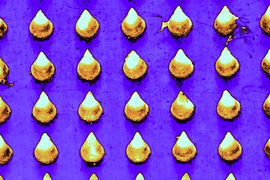
*Terms of Use:
Images for download on the MIT News office website are made available to non-commercial entities, press and the general public under a Creative Commons Attribution Non-Commercial No Derivatives license . You may not alter the images provided, other than to crop them to size. A credit line must be used when reproducing images; if one is not provided below, credit the images to "MIT."

Previous image Next image
Researchers at MIT, Brigham and Women’s Hospital, and Harvard Medical School have developed a potential new treatment for alopecia areata, an autoimmune disorder that causes hair loss and affects people of all ages, including children.
For most patients with this type of hair loss, there is no effective treatment. The team developed a microneedle patch that can be painlessly applied to the scalp and releases drugs that help to rebalance the immune response at the site, halting the autoimmune attack.
In a study of mice, the researchers found that this treatment allowed hair to regrow and dramatically reduced inflammation at the treatment site, while avoiding systemic immune effects elsewhere in the body. This strategy could also be adapted to treat other autoimmune skin diseases such as vitiligo, atopic dermatitis, and psoriasis, the researchers say.
“This innovative approach marks a paradigm shift. Rather than suppressing the immune system, we’re now focusing on regulating it precisely at the site of antigen encounter to generate immune tolerance,” says Natalie Artzi, a principal research scientist in MIT’s Institute for Medical Engineering and Science, an associate professor of medicine at Harvard Medical School and Brigham and Women’s Hospital, and an associate faculty member at the Wyss Institute of Harvard University.
Artzi and Jamil R. Azzi, an associate professor of medicine at Harvard Medical School and Brigham and Women’s Hospital, are the senior authors of the new study , which appears in the journal Advanced Materials . Nour Younis, a Brigham and Women’s postdoc, and Nuria Puigmal, a Brigham and Women’s postdoc and former MIT research affiliate, are the lead authors of the paper.
The researchers are now working on launching a company to further develop the technology, led by Puigmal, who was recently awarded a Harvard Business School Blavatnik Fellowship.
Direct delivery
Alopecia areata, which affects more than 6 million Americans, occurs when the body’s own T cells attack hair follicles, leading the hair to fall out. The only treatment available to most patients — injections of immunosuppressant steroids into the scalp — is painful and patients often can’t tolerate it.
Some patients with alopecia areata and other autoimmune skin diseases can also be treated with immunosuppressant drugs that are given orally, but these drugs lead to widespread suppression of the immune system, which can have adverse side effects.
“This approach silences the entire immune system, offering relief from inflammation symptoms but leading to frequent recurrences. Moreover, it increases susceptibility to infections, cardiovascular diseases, and cancer,” Artzi says.
A few years ago, at a working group meeting in Washington, Artzi happened to be seated next to Azzi (the seating was alphabetical), an immunologist and transplant physican who was seeking new ways to deliver drugs directly to the skin to treat skin-related diseases.
Their conversation led to a new collaboration, and the two labs joined forces to work on a microneedle patch to deliver drugs to the skin. In 2021, they reported that such a patch can be used to prevent rejection following skin transplant. In the new study, they began applying this approach to autoimmune skin disorders.
“The skin is the only organ in our body that we can see and touch, and yet when it comes to drug delivery to the skin, we revert to systemic administration. We saw great potential in utilizing the microneedle patch to reprogram the immune system locally,” Azzi says.
The microneedle patches used in this study are made from hyaluronic acid crosslinked with polyethylene glycol (PEG), both of which are biocompatible and commonly used in medical applications. With this delivery method, drugs can pass through the tough outer layer of the epidermis, which can’t be penetrated by creams applied to the skin.
“This polymer formulation allows us to create highly durable needles capable of effectively penetrating the skin. Additionally, it gives us the flexibility to incorporate any desired drug,” Artzi says. For this study, the researchers loaded the patches with a combination of the cytokines IL-2 and CCL-22. Together, these immune molecules help to recruit regulatory T cells, which proliferate and help to tamp down inflammation. These cells also help the immune system learn to recognize that hair follicles are not foreign antigens, so that it will stop attacking them.
Hair regrowth
The researchers found that mice treated with this patch every other day for three weeks had many more regulatory T cells present at the site, along with a reduction in inflammation. Hair was able to regrow at those sites, and this growth was maintained for several weeks after the treatment ended. In these mice, there were no changes in the levels of regulatory T cells in the spleen or lymph nodes, suggesting that the treatment affected only the site where the patch was applied.
In another set of experiments, the researchers grafted human skin onto mice with a humanized immune system. In these mice, the microneedle treatment also induced proliferation of regulatory T cells and a reduction in inflammation.
The researchers designed the microneedle patches so that after releasing their drug payload, they can also collect samples that could be used to monitor the progress of the treatment. Hyaluronic acid causes the needles to swell about tenfold after entering the skin, which allows them to absorb interstitial fluid containing biomolecules and immune cells from the skin.
Following patch removal, researchers can analyze samples to measure levels of regulatory T cells and inflammation markers. This could prove valuable for monitoring future patients who may undergo this treatment.
The researchers now plan to further develop this approach for treating alopecia, and to expand into other autoimmune skin diseases.
The research was funded by the Ignite Fund and Shark Tank Fund awards from the Department of Medicine at Brigham and Women’s Hospital.
Share this news article on:
Press mentions, healthday news.
MIT researchers have developed microneedle patches that are capable of restoring hair growth in alopecia areata patients, reports Ernie Mundell for HealthDay . The team’s approach includes a, “patch containing myriad microneedles that is applied to the scalp,” writes Mundell. “It releases drugs to reset the immune system so it stops attacking follicles.”
Previous item Next item
Related Links
- Natalie Artzi
- Institute for Medical Engineering and Science
Related Topics
- Drug delivery
- Health sciences and technology
- Institute for Medical Engineering and Science (IMES)
Related Articles

A sprayable gel could make minimally invasive surgeries simpler and safer

Patch that delivers drug, gene, and light-based therapy to tumor sites shows promising results
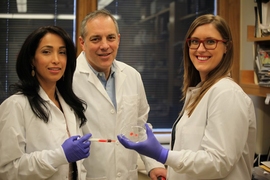
MIT researchers design tailored tissue adhesives
More mit news.

Scientists use generative AI to answer complex questions in physics
Read full story →

New tool empowers users to fight online misinformation

Elaine Liu: Charging ahead
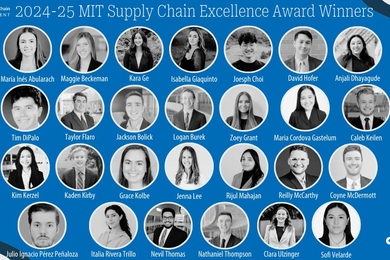
2024 MIT Supply Chain Excellence Awards given to 35 undergraduates

Faces of MIT: Reimi Hicks

John Joannopoulos receives 2024-2025 Killian Award
- More news on MIT News homepage →
Massachusetts Institute of Technology 77 Massachusetts Avenue, Cambridge, MA, USA
- Map (opens in new window)
- Events (opens in new window)
- People (opens in new window)
- Careers (opens in new window)
- Accessibility
- Social Media Hub
- MIT on Facebook
- MIT on YouTube
- MIT on Instagram
Live 5 News anchors, website honored in ‘Best of Charleston’ awards
CHARLESTON, S.C. (WCSC) - Readers of the Charleston City Paper named Live 5 News as the “Best of Charleston” in four categories, the paper announced.
Live 5 News anchor Ann McGill was named Best Local TV Anchor. McGill, who joined the Live 5 News team in October of 2001, is an award-winning journalist with more than 35 years of experience in both television and radio.
Live 5 Sports anchor Summer Huechtker, who has worked for WCSC-TV since January of 2020, as Best Local TV Sports Anchor.
Readers also selected Live5News.com as the Best Local Website.
They selected WCSC-TV as the Best Local TV Station. Now in its 70th year of broadcasting, WCSC-TV, is the longest continuously-operating station in South Carolina. Lowcountry broadcasting legend Charlie Hall signed the station on with the words, “Channel 5 is now alive” back on June 19, 1953.
The Charleston City Paper announced the winners at a private event Wednesday night. The paper’s “Best of Charleston 2024″ edition, which will list all of the winners in hundreds of categories, comes out on Friday.
Copyright 2024 WCSC. All rights reserved.

Charleston Co. men face charges related to sexually-explicit images of children

1 dead, 2 injured in Dorchester Rd. crash

CARTA bus stop bench removed, riders forced to stand or sit on ground

Deputies locate missing Georgetown County woman shortly after updating search

DD2 names new Principal for Flowertown Elementary School
Latest news.

Truck hits railroad overpass near Park Circle, road closed through weekend

N. Charleston Police searching for missing 14-year-old

Charleston Co. man sentenced for 2021 Christmas Day ATM bombing

VIDEO: N. Charleston Police searching for missing 14-year-old

VIDEO: N. Charleston road closed near Park Circle after truck hits railroad overpass
- Frontiers in Physics
- Low-Temperature Plasma Physics
- Research Topics
Atmospheric Pressure Plasma Jets: Fundamentals, Modeling and Applications
Total Downloads
Total Views and Downloads
About this Research Topic
Plasma jets have been studied for a long time for their ability to generate fluxes of reactive species at low gas temperatures. This property makes plasma jets suitable for many different applications, such as surface treatments, food decontamination, plasma medicine, and water treatment. Despite being relatively simple devices, their behavior is characterized by the coexistence of multiple physical and chemical mechanisms occurring across different spatial and temporal scales, as typically found for non-thermal plasma devices. Experimental characterization and numerical simulations are essential tools for elucidating the underlying physical mechanisms of their operation and extending both the effectiveness and the spectrum of applications of these devices. This Research Topic is aimed at providing the current state of the art concerning basic aspects of atmospheric pressure plasma jet design, construction, operation, and characterization, both from the experimental and modeling point of view. Furthermore, it is intended to give an overview of their applications. We thus invite scholars to submit both original research papers or reviews covering one or more of these topics. The papers are required to have a broad enough introduction and bibliographic section, so as to allow scientists from other fields to get a gentle introduction to the topic. The Research Topic shall collect original research papers and review papers on the following topics: - plasma jet design and construction - plasma jet operational regimes, experimental characterization, and modeling - diagnostics and modeling of the physical properties of plasma jets - diagnostics and modeling of the chemistry induced by plasma jets in gas, liquid, and solid phase - diagnostics and modeling of the interaction of plasma jets with matter - applications of plasma jets in material science - applications of plasma jets in the biomedical field - applications of plasma jets in agriculture - applications of plasma jets in cultural heritage protection - production of plasma-activated liquids and their applications - other applications of plasma jets
Keywords : plasma jet, plasma physics, plasma sources, plasma applications, plasma medicine, plasma modeling
Important Note : All contributions to this Research Topic must be within the scope of the section and journal to which they are submitted, as defined in their mission statements. Frontiers reserves the right to guide an out-of-scope manuscript to a more suitable section or journal at any stage of peer review.
Topic Editors
Topic coordinators, submission deadlines, participating journals.
Manuscripts can be submitted to this Research Topic via the following journals:
total views
- Demographics
No records found
total views article views downloads topic views
Top countries
Top referring sites, about frontiers research topics.
With their unique mixes of varied contributions from Original Research to Review Articles, Research Topics unify the most influential researchers, the latest key findings and historical advances in a hot research area! Find out more on how to host your own Frontiers Research Topic or contribute to one as an author.
Global Site
Breadcrumb navigation
Internship experience interview report: akira nakashima.
April 2, 2024
Evolving From an Internship to Joint Research Between NEC and University Laboratories

Researcher, Secure System Platform Research Laboratories Akira Nakashima
Nakashima joined NEC after completing his master's degree in 2023. He has been involved in cryptography research since his students days and is currently conducting research in the data security field with a focus on secure computation.
Participating in an internship for his studies with no thought of finding a job
I first learned about the NEC internship through an announcement on a university mailing list around May during the first year of my master's degree. The announcement was framed as a research internship opportunity for students in homomorphic encryption, which is my major. So, I thought that I might learn something since that is my major, and I applied for the internship. At the time, I wasn't even thinking about finding a job, so to be honest, I only applied for the sake of my own research. In particular, NEC has many researchers who are internationally active in the cryptography field. I recall that when I consulted with my academic adviser, he told me, "I think that you can learn a lot at NEC's research laboratory" and recommended that I participate in the internship. At the time, I was living in Kyushu and participated remotely in the internship. However, that was in the summer of 2021, right when the Tokyo Olympics were being held. It was a time when the number of people infected with COVID-19 was increasing. Initially, I planned to visit the research laboratory at the beginning and end of my internship, but in light of the situation at that time, I shifted to a fully remote arrangement with my PC being delivered and returned by home delivery service. The employment interviews and presentation of the employment offer were also held online, so I only set foot inside NEC after I joined the company. That being said, during the internship period NEC provided a mentor, established online opportunities to consult and report on my progress once every two days, and I was connected via chat at all times, so I did not feel like I was being left alone. NEC also established time for one-on-one chats with the team members during the internship period. Of course, I am no longer working only remotely but also reporting to the office to work face to face. In fact, it seems many of the students who interned this year were working in-house. I think that is a more stimulating environment.
Feeling enjoyment and a sense of purpose during his first full-scale implementation
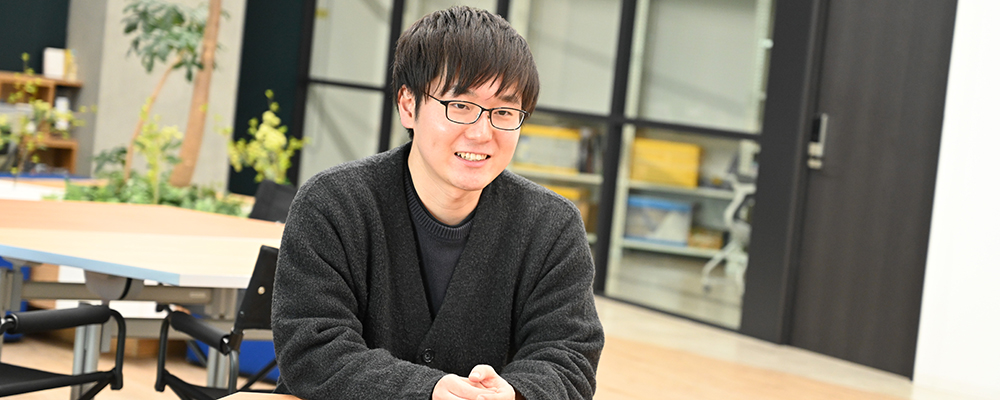
The overall theme of the internship is presented during the recruiting process, but the specific details of the work are determined in consultation with your supervisor and mentor in light of the situation where you are assigned as well as your own interests and skills. In my case, I mainly focused on the implementation of cryptography. In addition, I also investigated encryption methods, held seminar-format study sessions, and conducted improvement studies. In the study sessions, I summarized the encryption method algorithms and other information that I investigated on slides, gave a presentation to the team members, received suggestions, and engaged in a question and answer session to jointly think about ways to improve the algorithms. This led to a lively discussion and created a very stimulating forum. During the implementation, I worked on the development of homomorphic encryption (encryption method which can perform computation with data in an encrypted form). I had never really carried out a full-scale implementation at university, so it was a really fresh experience for me. When trying to implement cryptography in a practical way, there are various aspects that you must pay attention to. For example, when generating a random number, you cannot use the kind of algorithm that is implemented in a game, etc. because you have to use something which is properly secured. I majored in mathematics during my undergraduate days and was a novice when I started doing cryptography for real with my master's degree, so I had not even mastered such basic rules and only learned about them when a team member pointed them out to me. In addition, the pursuit of practical speed also became an important point. Naturally, the goal in corporate research is to tie it to productization and business. The discussion unfolds such that one might say, "If you are going to use it for this solution, then this encryption method is probably better" or conversely, "This method is unsuited to this authentication, so we should do it a different way." This kind of discussion which places social implementation as the goal was very stimulating. I was able to come to the realization that technologies that I thought up or implemented could benefit society and people, which was a lot of fun. Of course, that feeling remains unchanged to this day.

An introduction to Nakashima's daily schedule during his internship
Evolving from research conducted during his internship to co-authoring research papers presented at top international conferences.
In my case, the research activities into cryptography that I worked on during my internship continued even after the internship period ended. The university research laboratory entered into a full-scale collaboration with NEC to conduct joint research. As a result, a research paper summarizing this work was successfully published by ESORICS '23, a top cryptography related international conference, and I was able to list my name as a co-author. (Note 1) My senior colleagues are heading to the conference site to give an oral presentation. In this way, it is not unusual for research conducted during an NEC internship to lead to presentations at an academic conference. This year as well, results produced by students during their internship period were presented at an academic conference in Japan with the students' names listed as co-authors. Moreover, even if the research content does not tie into results in academia, what you learn in the internship will nourish your own research. I myself was able to acquire knowledge about cryptographic technology through my NEC internship, which I believe helped me to grow. In fact, the research paper that I presented during the second year of my master's degree won a research paper award at the SCIS conference in Japan. (Note 2) The award ceremony was held in January of this year. I believe that the NEC internship was a good opportunity to broaden and deepen the scope of my own research. After finishing my internship, I discovered that the recruiting process had started and immediately applied. For my interview, I created materials and gave a presentation on "what I would like to achieve after joining NEC." The selection process advanced very quickly, and they extended an offer, so I decided to directly join NEC. The internship was a lot of fun, and the team members were all very kind and nice, so I considered myself lucky to be able to join NEC. There are many NEC researchers that I hold in high regard. There are some who have been active in academia as researchers and produced results for many years while others excel at coordinating with others and promoting co-creation as business people. I am very grateful to be able to work in such an extremely inspiring workplace.

- ※ The information posted on this website is the information at the time of publication.

IMAGES
VIDEO
COMMENTS
Get 30 days free. 1. Google Scholar. Google Scholar is the clear number one when it comes to academic search engines. It's the power of Google searches applied to research papers and patents. It not only lets you find research papers for all academic disciplines for free but also often provides links to full-text PDF files.
15 Best Academic Research Trend Prediction Platforms. 15 Best Websites To Download Research Papers For Free. #20. Jurn. Powered by Google Custom Search Engine (CSE), Jurn is a free online search engine for accessing and downloading free full-text scholarly papers.
Still, Google Books is a great first step to find sources that you can later look for at your campus library. 6. Science.gov. If you're looking for scientific research, Science.gov is a great option. The site provides full-text documents, scientific data, and other resources from federally funded research.
Google Scholar provides a simple way to broadly search for scholarly literature. Search across a wide variety of disciplines and sources: articles, theses, books, abstracts and court opinions.
Harness the power of visual materials—explore more than 3 million images now on JSTOR. Enhance your scholarly research with underground newspapers, magazines, and journals. Explore collections in the arts, sciences, and literature from the world's leading museums, archives, and scholars. JSTOR is a digital library of academic journals ...
Access 160+ million publications and connect with 25+ million researchers. Join for free and gain visibility by uploading your research.
Organize your papers in one place. Try Paperpile. 1. Scopus. Scopus is one of the two big commercial, bibliographic databases that cover scholarly literature from almost any discipline. Besides searching for research articles, Scopus also provides academic journal rankings, author profiles, and an h-index calculator. 2.
Find the research you need | With 160+ million publications, 1+ million questions, and 25+ million researchers, this is where everyone can access science
Work faster and smarter with advanced research discovery tools. Search the full text and citations of our millions of papers. Download groups of related papers to jumpstart your research. Save time with detailed summaries and search alerts. Advanced Search. PDF Packages of 37 papers.
It is a highly interdisciplinary platform used to search for scholarly articles related to 67 social science topics. SSRN has a variety of research networks for the various topics available through the free scholarly database. The site offers more than 700,000 abstracts and more than 600,000 full-text papers.
3.3 million articles on ScienceDirect are open access. Articles published open access are peer-reviewed and made freely available for everyone to read, download and reuse in line with the user license displayed on the article. ScienceDirect is the world's leading source for scientific, technical, and medical research.
Help you achieve your academic goals. Whether we're proofreading and editing, checking for plagiarism or AI content, generating citations, or writing useful Knowledge Base articles, our aim is to support students on their journey to become better academic writers. We believe that every student should have the right tools for academic success.
Semantic Reader is an augmented reader with the potential to revolutionize scientific reading by making it more accessible and richly contextual. Try it for select papers. Learn More. Semantic Scholar uses groundbreaking AI and engineering to understand the semantics of scientific literature to help Scholars discover relevant research.
Elsevier Journal Finder helps you find journals that could be best suited for publishing your scientific article. Journal Finder uses smart search technology and field-of-research specific vocabularies to match your paper's abstract to scientific journals.
Grammarly. Grammarly is a real-time writing tool that checks spelling, punctuation, and style. It was created in 2009 by linguists and software engineers and is now one of the most popular writing tools. Grammarly is available as a browser extension, a desktop program for Windows and macOS, and a web app.
3. Filter your search results and analyze trends. Group, rank and analyze the research articles in your search results to optimize the relevancy and efficiency of your efforts. In the Web of Science, researchers can cut through the data in a number of creative ways. This will help you when you're stuck wondering where to find peer reviewed ...
Create a research paper outline. Write a first draft of the research paper. Write the introduction. Write a compelling body of text. Write the conclusion. The second draft. The revision process. Research paper checklist. Free lecture slides.
RefSeek - Academic Search Engine. Web. Documents. Type 2 or more characters for results. Learn about: Flowers, Chocolate. Browse the Reference Site Directory. Academic search engine for students and researchers. Locates relevant academic search results from web pages, books, encyclopedias, and journals.
1. PubMed. PubMed is the number one source for medical and healthcare research. It is hosted by the National Institutes of Health (NIH) and provides bibliographic information including abstracts and links to the full text publisher websites for more than 28 million articles. Coverage: around 35 million items.
Aggregation plays an increasingly essential role in maximising the long-term benefits of open access, helping to turn the promise of a 'research commons' into a reality. The aggregation services that CORE provides therefore make a very valuable contribution to the evolving open access environment in the UK. Show all.
ReferenceDesk.org: Dubbed "The Internet's Best Reference Source," this extremely useful web directory provides everything from business and finance information to federal government resources, scholarship details, links to newspapers and calendars, search engines, and more. Ask the Space Expert: NASA's source for space and science research help.
ResearchGate. ResearchGate is a platform hosting over 135 million publication pages with a community of 20 million scientists. The platform allows you to show off your work, access papers and advice from other researchers, make contacts and even find jobs. Some of its more prominent features include: Dedicated Q&A section with searchable ...
Deep learning segmentation of non-perfusion area from color fundus images and AI-generated fluorescein angiography. Kanato Masayoshi. Yusaku Katada. Toshihide Kurihara. Article Open Access 11 May ...
The introduction of AlphaFold 21 has spurred a revolution in modelling the structure of proteins and their interactions, enabling a huge range of applications in protein modelling and design2-6 ...
Zillow Research aims to be the most open, authoritative source for timely and accurate housing data and unbiased insight. Market Reports. The Housing Market Eased off the Accelerator in April as Mortgage Rates Spiked (April 2024 Market Report) The Numbers APRIL 2024
Voices in Bioethics is currently seeking submissions on philosophical and practical topics, both current and timeless. Papers addressing access to healthcare, the bioethical implications of recent Supreme Court rulings, environmental ethics, data privacy, cybersecurity, law and bioethics, economics and bioethics, reproductive ethics, research ethics, and pediatric bioethics are sought.
Nour Younis, a Brigham and Women's postdoc, and Nuria Puigmal, a Brigham and Women's postdoc and former MIT research affiliate, are the lead authors of the paper. The researchers are now working on launching a company to further develop the technology, led by Puigmal, who was recently awarded a Harvard Business School Blavatnik Fellowship.
CHARLESTON, S.C. (WCSC) - Readers of the Charleston City Paper named Live 5 News as the "Best of Charleston" in four categories, the paper announced. Live 5 News anchor Ann McGill was named Best Local TV Anchor. McGill, who joined the Live 5 News team in October of 2001, is an award-winning journalist with more than 35 years of experience ...
The papers are required to have a broad enough introduction and bibliographic section, so as to allow scientists from other fields to get a gentle introduction to the topic.The Research Topic shall collect original research papers and review papers on the following topics:- plasma jet design and constructi...
The university research laboratory entered into a full-scale collaboration with NEC to conduct joint research. As a result, a research paper summarizing this work was successfully published by ESORICS '23, a top cryptography related international conference, and I was able to list my name as a co-author.